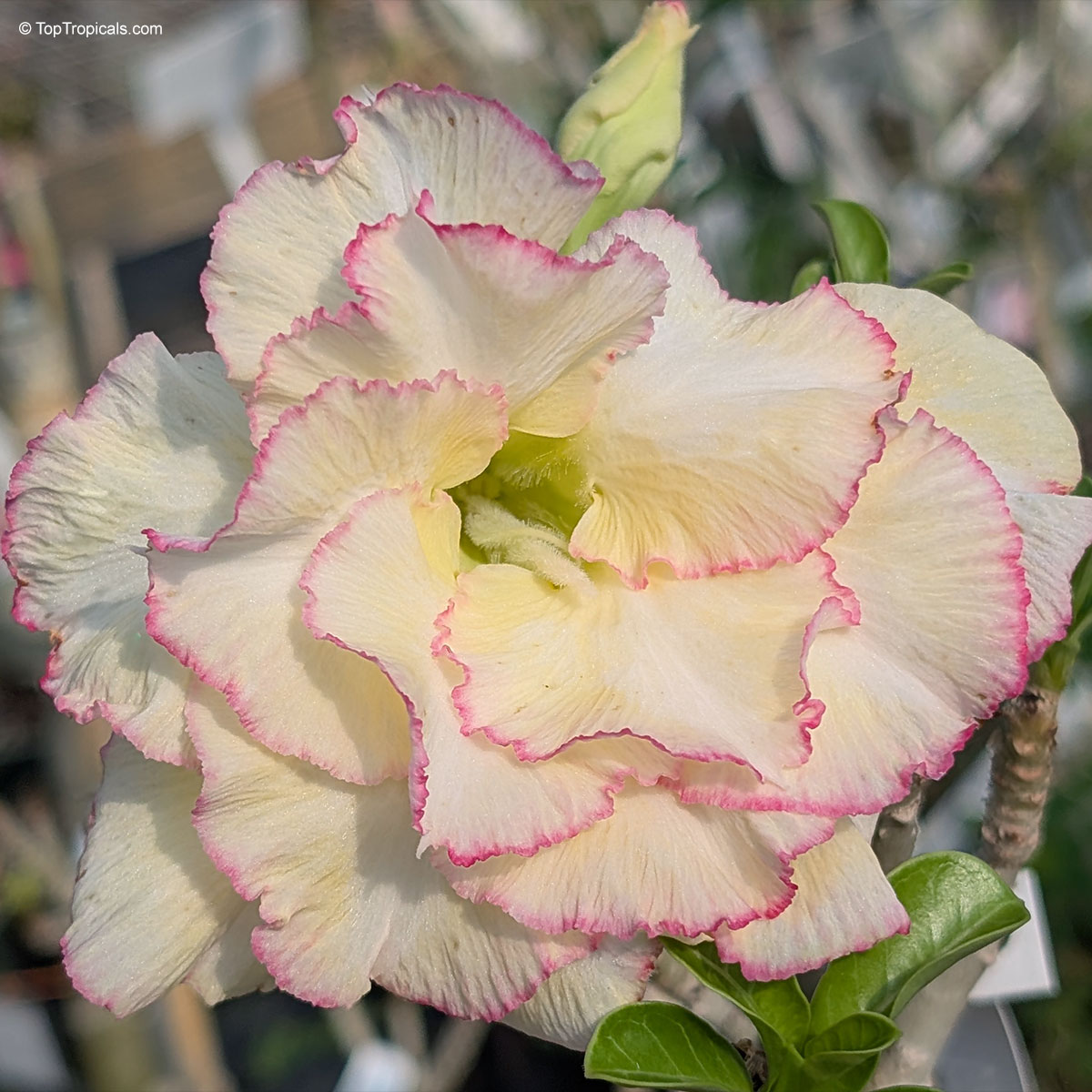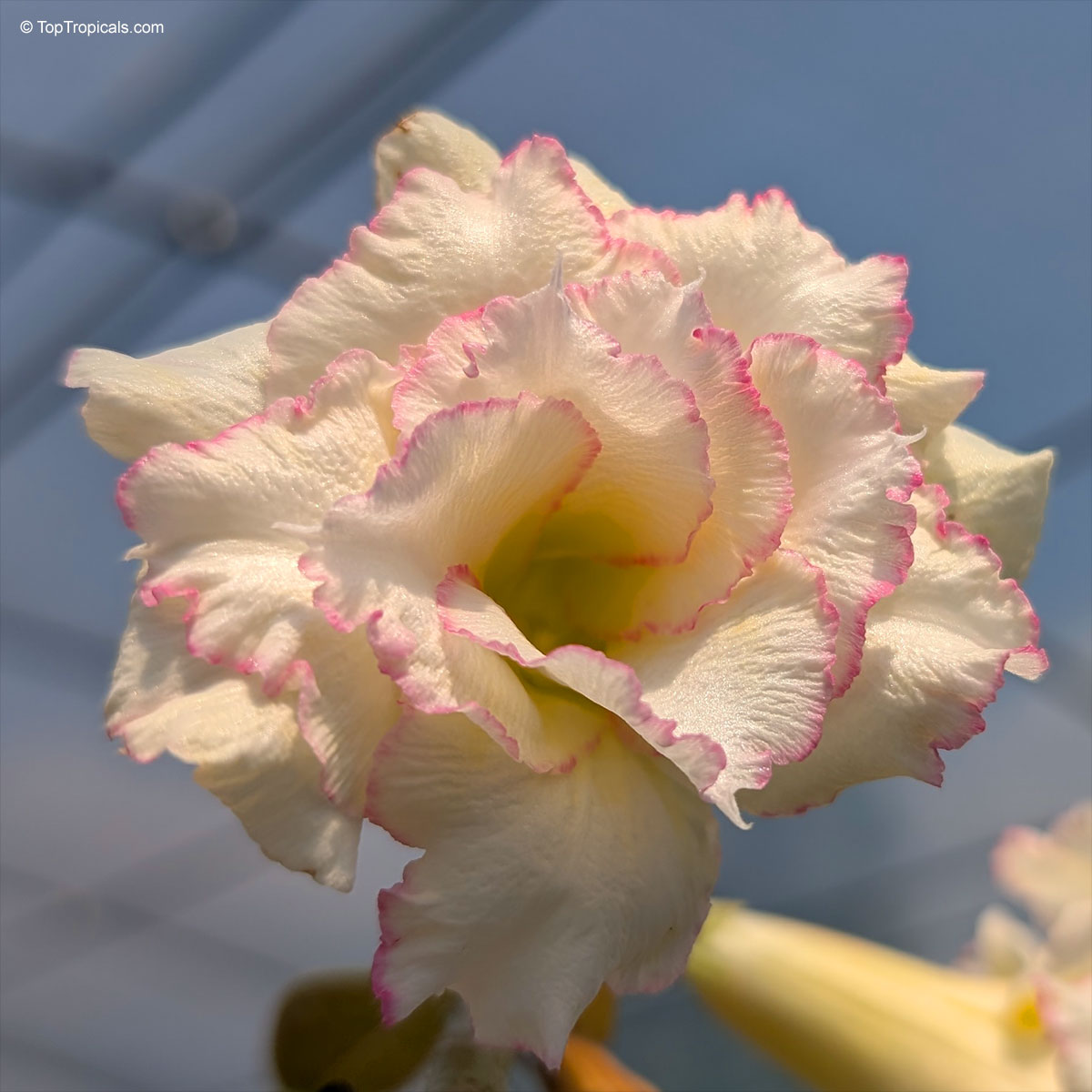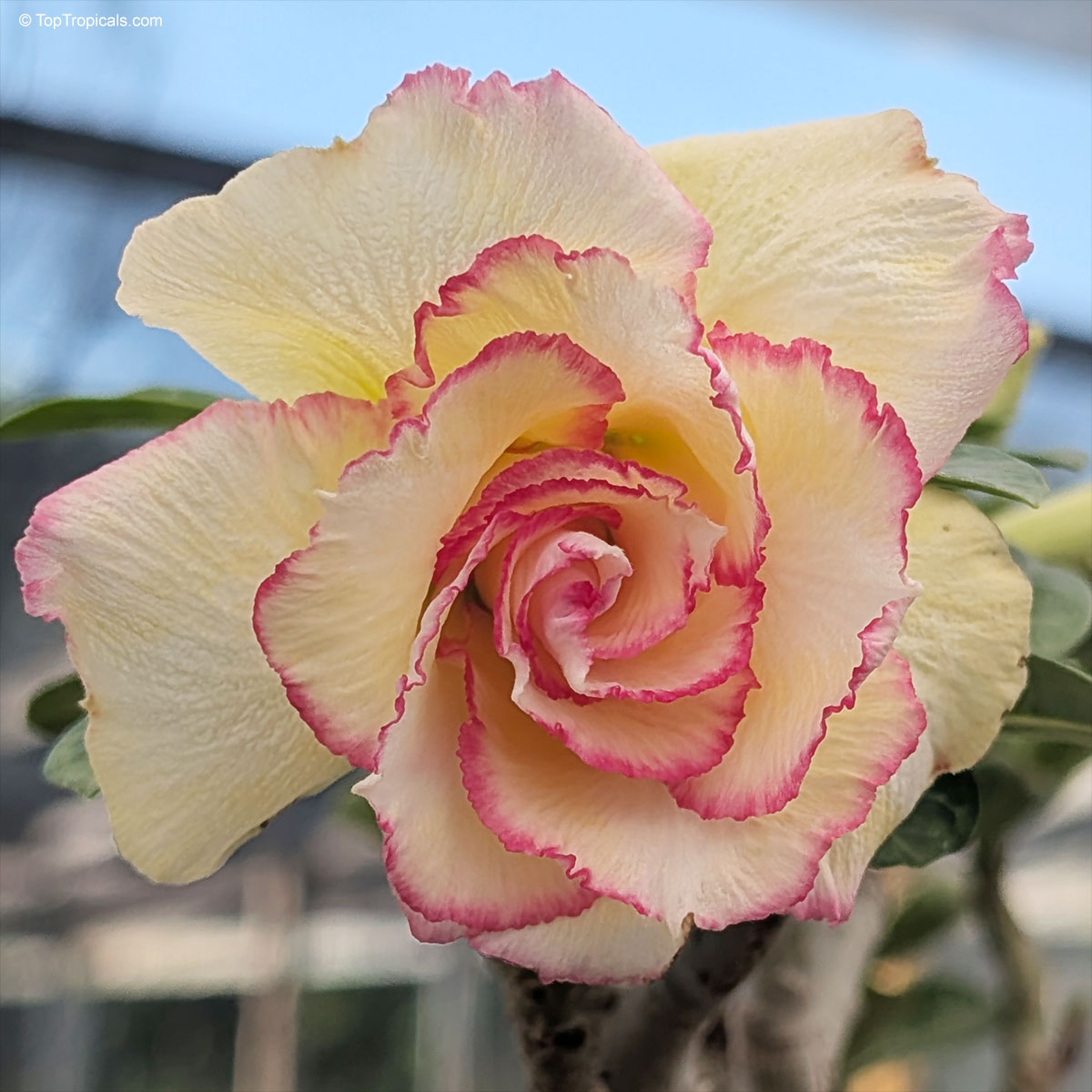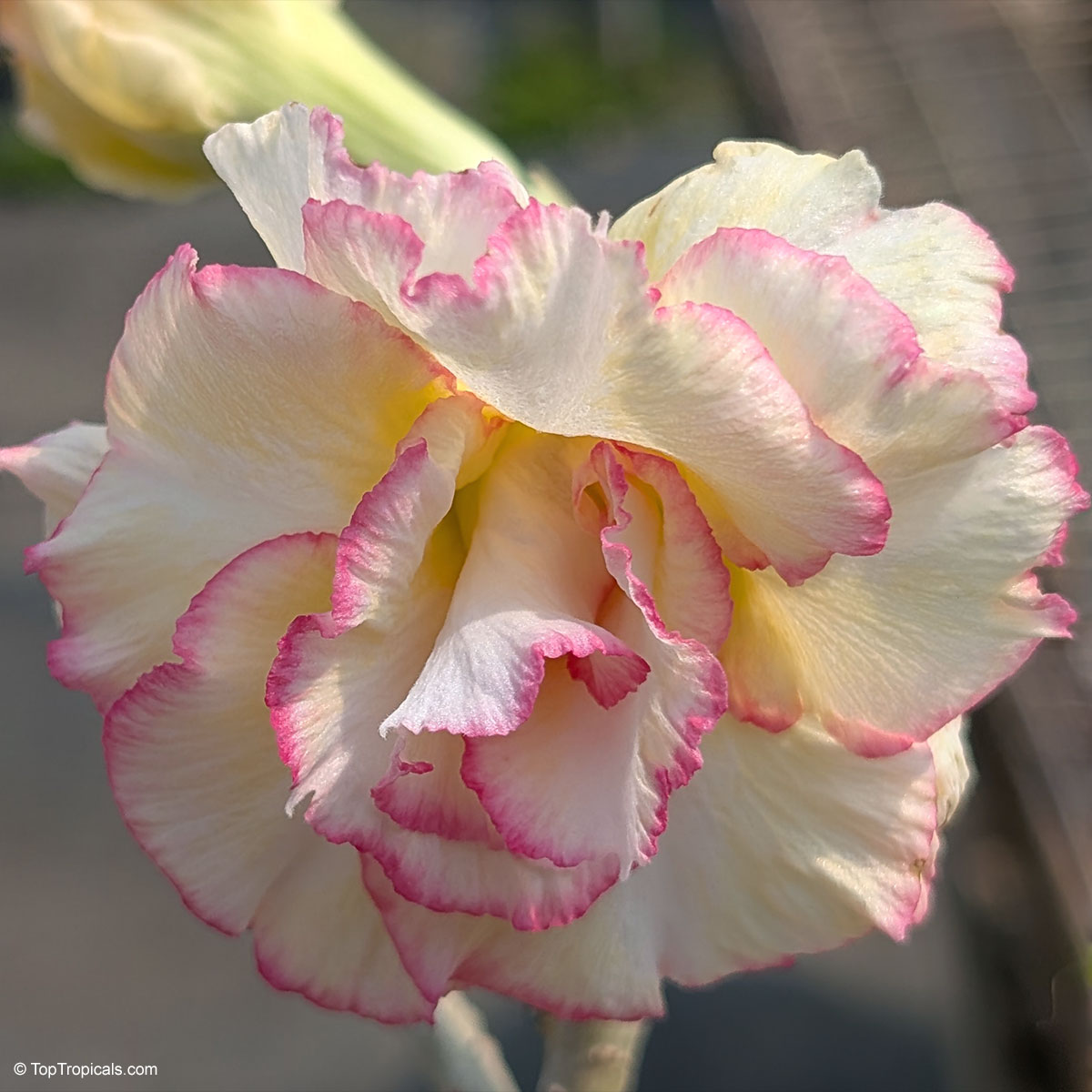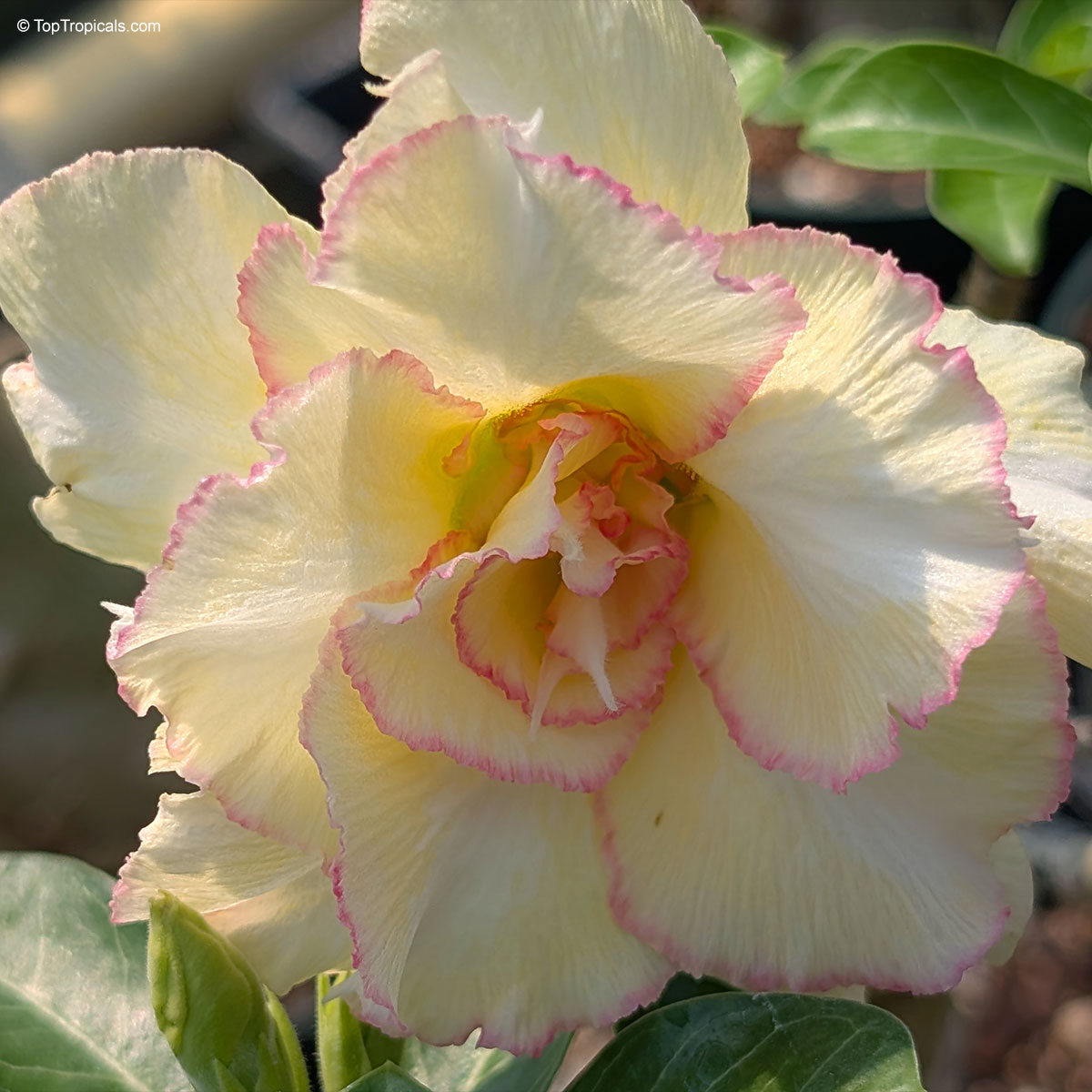Adenium - Plant Encyclopedia Results
Top Tropicals Plant Encyclopedia
| Number of plants found: 121 | Next | 
|
Go to page: | 1 | 2 | 3 | 4 | 5 | Last |
Botanical name: Adenium arabicum
Common name: Desert Rose
Family: Apocynaceae
Origin: Arabia and East Africa













Growing to a height of about 4-5ft, this succulent plant is a member of the same family as Plumeria. Its swollen, often twisted trunk is pale gray. The leaves are glossy and club-shaped, and the flowers, which appear almost continuously, are trumpet-shaped, and range from white and bright pink to crimson red. It exudes a highly toxic sap which in some places is used as a poison for arrows. Adenium is not generally grown in moist tropical gardens but is often seen as a decorative pot plant; it may also be used in rock gardens. It needs full sun and a well-drained potting mixture. Exotic multi-color varieties can be grafted on the same plant. See other exotic species of Adenium, photo gallery of exotic varieties and Thai Adeniums - milti-colored, multi-grafted. More info about Adenium
See picture of the actual size of plants for sale (sizes vary).
See picture of the mature plant in 5 gal pot (4 years old) and picture of flower. The plants we have for sale are 2 years old, in 1-3 gal pots, with large caudex, some already bloomed!
Recommended Supplies: SUNSHINE Megaflor - Bloom Nutrition Booster
SUNSHINE-Epi - Caudex booster
Adenium Soilless Mix
Botanical name: Adenium boehmianum
Common name: Desert Rose
Family: Apocynaceae
Origin: Arabia and East Africa













Growing to a height of about 4-5ft, this succulent plant is a member of the same family as Plumeria. Its swollen, often twisted trunk, is pale grey. The leaves are glossy, and club-shaped and the flowers, which appear almost continuously, are trumpet-shaped and range from white and bright pink to crimson red. It exudes a highly toxic sap that in some places,is used as a poison for arrows. Adenium is not generally grown in moist tropical gardens but is often seen as a decorative pot plant; it may also be used in rock gardens. It needs full sun and a well-drained potting mixture. Exotic multi-color varieties can be grafted on the same plant. See other exotic species of Adenium, photo gallery of exotic varieties and Thai Adeniums - milti-colored, multi-grafted. More info about Adenium
Botanical name: Adenium multiflorum
Common name: Desert Rose
Family: Apocynaceae
Origin: Arabia and East Africa











Growing to a height of about 4-5ft, this succulent plant is a member of the same family as Plumeria. Its swollen, often twisted trunk, is pale grey. The leaves are glossy and club-shaped. The flowers appear almost continuously, are trumpet-shaped, and range from white and bright pink to crimson red. It emits a highly toxic sap which in some places is used as a poison for arrows. Adeniums are not generally grown in moist tropical gardens but are often seen as a decorative pot plant; they may also be used in rock gardens. They need full sun and a well-drained potting mixture. Exotic multi-color varieties can be grafted onto the same plant. See other exotic species of Adenium, photo gallery of exotic varieties and Thai Adeniums - milti-colored, multi-grafted.
See article about Adenium.
Botanical name: Adenium obesum
Common names: Desert Rose, Impala Lily
Family: Apocynaceae
Origin: Arabia and East Africa












Growing to a height of about 4-5ft, this succulent plant is a member of the same family as Plumeria. Its swollen, often twisted trunk, is pale grey. The leaves are glossy, and club-shaped. The flowers appear almost continuously, are trumpet-shaped and range from white and bright pink to crimson, red. It exudes a highly toxic sap, which in some places is used as a poison for arrows. Adeniums are not generally grown in moist tropical gardens but are often seen as a decorative pot plants. They may also be used in rock gardens.They need full sun and a well-drained potting mixture. Exotic multi-color varieties can be grafted onto the same plant. See other exotic species of Adenium, photo gallery of exotic varieties and Thai Adeniums - milti-colored, multi-grafted.
See article about Adenium.
Botanical name: Adenium somalense
Common name: Desert Rose
Family: Apocynaceae
Origin: Arabia and East Africa










Growing to a height of about 4-5ft, this succulent plant is a member of the same family as Plumeria. Its swollen, often twisted trunk is pale grey, the leaves are glossy and club-shaped, and the flowers, which appear almost continuously, are trumpet-shaped and range from white and bright pink to crimson, red. It exudes a highly toxic sap which in some places is used as a poison for arrows. Adenium is not generally grown in moist tropical gardens but is often seen as a decorative pot plant; it may also be used in rock gardens. It needs full sun and a well-drained potting mixture. Exotic multi-color varieties can be grafted on the same plant. See other exotic species of Adenium, photo gallery of exotic varieties and Thai Adeniums - milti-colored, multi-grafted.
See article about Adenium.
Botanical name: Adenium sp.
Common name: Black Desert Rose
Cultivar: Dark-colored Flower
Family: Apocynaceae
Origin: Arabia and East Africa









These bizarre hybrids appeared on the market a few years ago. At first, pictures looked confusing and unreal. When our first Black adeniums went into bloom, we were disappointed with red buds popped up on the plants... However after the dark red flowers opened, they started to darken as they aged, and some varieties turned so dark in color that it was close to black or brown. Some varieties have only black contour around red flower. So, black flower is actually a very old flower! So be, patient and let it age as an old good vine. See picture of darkening process.
Adeniums have many spectacular hybrids. The basic culture is very similar to orchids. A small pot with excellent drainage is a must. Adeniums do not like both over-watering or drying-out. There is a little secret of how to create a weird shape of the base: lift the plant a bit every time you re-pot the plant, so that the upper part of roots will be a little exposed. The plant will form more roots that will go down. To make your plant develop a large swollen base/trunk, you'll need a good quality fertilizer. Fertilizer requirement for swelling up trunks is also used to increase flowering. It shouldn't be too high in nitrogen, the middle number should be the highest. Never apply fertilizer directly on roots and do not liquid feed when a plant is thirsty: always water first slightly to avoid root burn and leaf drop. Do not wet leaves. Adeniums need lots of light for heavy flowering. Most hybrids and species start blooming in the spring when the conditions are warm and days get longer, and continue blooming through the fall and winter in warmer climates. Adeniums like a neutral to hard water. Acidic water tends to sour the soil too fast and may cause root rot. Water plants preferably in the early morning, and allow them to drink up throughout the day. Watering can be done daily to every few days. Never allow your plants to sit in a saucer of water, but don't let them to dry out too often - this causes adeniums to go into early dormancy.
Recommended Supplies: SUNSHINE Megaflor - Bloom Nutrition Booster
SUNSHINE-Epi - Caudex booster
Adenium Soilless Mix
Succulent Care. This plant is shipped bare-rooted. Plant it in well-drained soil mix, water and keep in warm (75-80F) place in filtered light. Let soil dry between waterings.
Recommended Supplies: SUNSHINE Megaflor - Bloom Nutrition Booster
SUNSHINE-Epi - Caudex booster
Adenium Soilless Mix
Succulent Care. This plant is shipped bare-rooted. Plant it in well-drained soil mix, water and keep in warm (75-80F) place in filtered light. Let soil dry between waterings.
Recommended Supplies: SUNSHINE Megaflor - Bloom Nutrition Booster
SUNSHINE-Epi - Caudex booster
Adenium Soilless Mix
Succulent Care. This plant is shipped bare-rooted. Plant it in well-drained soil mix, water and keep in warm (75-80F) place in filtered light. Let soil dry between waterings.
Recommended Supplies: SUNSHINE Megaflor - Bloom Nutrition Booster
SUNSHINE-Epi - Caudex booster
Adenium Soilless Mix
Succulent Care. This plant is shipped bare-rooted. Plant it in well-drained soil mix, water and keep in warm (75-80F) place in filtered light. Let soil dry between waterings.
Recommended Supplies: SUNSHINE Megaflor - Bloom Nutrition Booster
SUNSHINE-Epi - Caudex booster
Adenium Soilless Mix
Succulent Care. This plant is shipped bare-rooted. Plant it in well-drained soil mix, water and keep in warm (75-80F) place in filtered light. Let soil dry between waterings.
Recommended Supplies: SUNSHINE Megaflor - Bloom Nutrition Booster
SUNSHINE-Epi - Caudex booster
Adenium Soilless Mix
Succulent Care. This plant is shipped bare-rooted. Plant it in well-drained soil mix, water and keep in warm (75-80F) place in filtered light. Let soil dry between waterings.
Recommended Supplies: SUNSHINE Megaflor - Bloom Nutrition Booster
SUNSHINE-Epi - Caudex booster
Adenium Soilless Mix
Succulent Care. This plant is shipped bare-rooted. Plant it in well-drained soil mix, water and keep in warm (75-80F) place in filtered light. Let soil dry between waterings.
Recommended Supplies: SUNSHINE Megaflor - Bloom Nutrition Booster
SUNSHINE-Epi - Caudex booster
Adenium Soilless Mix
Succulent Care. This plant is shipped bare-rooted. Plant it in well-drained soil mix, water and keep in warm (75-80F) place in filtered light. Let soil dry between waterings.
Recommended Supplies: SUNSHINE Megaflor - Bloom Nutrition Booster
SUNSHINE-Epi - Caudex booster
Adenium Soilless Mix
Succulent Care. This plant is shipped bare-rooted. Plant it in well-drained soil mix, water and keep in warm (75-80F) place in filtered light. Let soil dry between waterings.
Recommended Supplies: SUNSHINE Megaflor - Bloom Nutrition Booster
SUNSHINE-Epi - Caudex booster
Adenium Soilless Mix
Succulent Care. This plant is shipped bare-rooted. Plant it in well-drained soil mix, water and keep in warm (75-80F) place in filtered light. Let soil dry between waterings.
Recommended Supplies: SUNSHINE Megaflor - Bloom Nutrition Booster
SUNSHINE-Epi - Caudex booster
Adenium Soilless Mix
Succulent Care. This plant is shipped bare-rooted. Plant it in well-drained soil mix, water and keep in warm (75-80F) place in filtered light. Let soil dry between waterings.
Botanical name: Adenium sp.
Common name: Yellow Desert Rose
Cultivar: Yellow Flower
Family: Apocynaceae
Origin: Arabia and East Africa










These adenium hybrids are quite unnique as they have unusual color for Adenium - yellow. Original species of Adenium were limited by pink, white, and red colors and shades. Just a few years ago, yellow hybrids were selected in Thailand and at first were considered a myth. Now we have them, and every year more and more yellow hybrids appear on the market.
Adeniums have many spectacular hybrids. The basic culture is very similar to orchids. A small pot with excellent drainage is a must. Adeniums do not like both over-watering or drying-out. There is a little secret of how to create a weird shape of the base: lift the plant a bit every time you re-pot the plant, so that the upper part of roots will be a little exposed. The plant will form more roots that will go down. To make your plant develop a large swollen base/trunk, you'll need a good quality fertilizer. Fetilizer requirement for swelling up trunks is also used to increase flowering. It shouldnt be too hight in nitrogen, the middle number should be the highest. Never apply fertilizer directly on roots and do not liquid feed when a plant is thirsty: always water first slightly to avoid root burn and leaf drop. Do not wet leaves. Adeniums need lots of light for heavy flowering. Most hybrids and species start blooming in the spring when the conditions are warm and days get longer, and continue blooming through the fall and winter in warmer climates. Adeniums like a neutral to hard water. Acidic water tends to sour the soil too fast and may cause root rot. Water plants preferably in the early morning, and allow them to drink up throughout the day. Watering can be done daily to every few days. Never allow your plants to sit in a saucer of water, but don't let them to dry out too often - this causes adeniums to go into early dormancy.
Recommended Supplies: SUNSHINE Megaflor - Bloom Nutrition Booster
SUNSHINE-Epi - Caudex booster
Adenium Soilless Mix
Succulent Care. This plant is shipped bare-rooted. Plant it in well-drained soil mix, water and keep in warm (75-80F) place in filtered light. Let soil dry between waterings.
Last one
Recommended Supplies: SUNSHINE Megaflor - Bloom Nutrition Booster
SUNSHINE-Epi - Caudex booster
Adenium Soilless Mix
Succulent Care. This plant is shipped bare-rooted. Plant it in well-drained soil mix, water and keep in warm (75-80F) place in filtered light. Let soil dry between waterings.
Last one
Recommended Supplies: SUNSHINE Megaflor - Bloom Nutrition Booster
SUNSHINE-Epi - Caudex booster
Adenium Soilless Mix
Succulent Care. This plant is shipped bare-rooted. Plant it in well-drained soil mix, water and keep in warm (75-80F) place in filtered light. Let soil dry between waterings.
Recommended Supplies: SUNSHINE Megaflor - Bloom Nutrition Booster
SUNSHINE-Epi - Caudex booster
Adenium Soilless Mix
Succulent Care. This plant is shipped bare-rooted. Plant it in well-drained soil mix, water and keep in warm (75-80F) place in filtered light. Let soil dry between waterings.
Recommended Supplies: SUNSHINE Megaflor - Bloom Nutrition Booster
SUNSHINE-Epi - Caudex booster
Adenium Soilless Mix
Succulent Care. This plant is shipped bare-rooted. Plant it in well-drained soil mix, water and keep in warm (75-80F) place in filtered light. Let soil dry between waterings.
Recommended Supplies: SUNSHINE Megaflor - Bloom Nutrition Booster
SUNSHINE-Epi - Caudex booster
Adenium Soilless Mix
Succulent Care. This plant is shipped bare-rooted. Plant it in well-drained soil mix, water and keep in warm (75-80F) place in filtered light. Let soil dry between waterings.
Recommended Supplies: SUNSHINE Megaflor - Bloom Nutrition Booster
SUNSHINE-Epi - Caudex booster
Adenium Soilless Mix
Succulent Care. This plant is shipped bare-rooted. Plant it in well-drained soil mix, water and keep in warm (75-80F) place in filtered light. Let soil dry between waterings.
Recommended Supplies: SUNSHINE Megaflor - Bloom Nutrition Booster
SUNSHINE-Epi - Caudex booster
Adenium Soilless Mix
Succulent Care. This plant is shipped bare-rooted. Plant it in well-drained soil mix, water and keep in warm (75-80F) place in filtered light. Let soil dry between waterings.
Recommended Supplies: SUNSHINE Megaflor - Bloom Nutrition Booster
SUNSHINE-Epi - Caudex booster
Adenium Soilless Mix
Succulent Care. This plant is shipped bare-rooted. Plant it in well-drained soil mix, water and keep in warm (75-80F) place in filtered light. Let soil dry between waterings.
Recommended Supplies: SUNSHINE Megaflor - Bloom Nutrition Booster
SUNSHINE-Epi - Caudex booster
Adenium Soilless Mix
Succulent Care. This plant is shipped bare-rooted. Plant it in well-drained soil mix, water and keep in warm (75-80F) place in filtered light. Let soil dry between waterings.
Recommended Supplies: SUNSHINE Megaflor - Bloom Nutrition Booster
SUNSHINE-Epi - Caudex booster
Adenium Soilless Mix
Succulent Care. This plant is shipped bare-rooted. Plant it in well-drained soil mix, water and keep in warm (75-80F) place in filtered light. Let soil dry between waterings.
Recommended Supplies: SUNSHINE Megaflor - Bloom Nutrition Booster
SUNSHINE-Epi - Caudex booster
Adenium Soilless Mix
Succulent Care. This plant is shipped bare-rooted. Plant it in well-drained soil mix, water and keep in warm (75-80F) place in filtered light. Let soil dry between waterings.
Recommended Supplies: SUNSHINE Megaflor - Bloom Nutrition Booster
SUNSHINE-Epi - Caudex booster
Adenium Soilless Mix
Succulent Care. This plant is shipped bare-rooted. Plant it in well-drained soil mix, water and keep in warm (75-80F) place in filtered light. Let soil dry between waterings.
Botanical name: Adenium sp.
Common names: Adenium, Desert Rose, Impala Lily
Family: Apocynaceae













See other exotic species of Adenium, photo gallery of exotic varieties and Thai Adeniums - milti-colored, multi-grafted.
See article about Adenium.
Botanical name: Adenium sp.
Common name: Variegated Desert Rose
Cultivar: Variegatum
Family: Apocynaceae
Origin: Arabia and East Africa













Growing to a height of about 4-5ft, this succulent plant is a member of the same family as Plumeria. Its swollen, often twisted trunk, is pale gray. The leaves are glossy and club-shaped. The flowers appear almost continuously, are trumpet-shaped, and range from white and bright pink to crimson red. They emit a highly toxic sap which in some places is used as a poison for arrows. Adeniums are not generally grown in moist tropical gardens, but are often seen as a decorative pot plants; they may also be used in rock gardens. They need full sun and well-drained potting mixture. Exotic multi-color varieties can be grafted onto the same plant. See other exotic species of Adenium, photo gallery of exotic varieties and Thai Adeniums - milti-colored, multi-grafted. More info...
Recommended Supplies: SUNSHINE Megaflor - Bloom Nutrition Booster
SUNSHINE-Epi - Caudex booster
Adenium Soilless Mix
Succulent Care. This plant is shipped bare-rooted. Plant it in well-drained soil mix, water and keep in warm (75-80F) place in filtered light. Let soil dry between waterings.
Last one
Botanical name: Adenium sp.
Cultivar: Candy
Family: Apocynaceae



Adenium 'Candy' is a hybrid with delicate, ruffled flowers in soft creamy-yellow shades fading to near white, edged with pink - a sweet mix of colors true to its name.
Recommended Supplies: SUNSHINE Megaflor - Bloom Nutrition Booster
SUNSHINE-Epi - Caudex booster
Adenium Soilless Mix
Succulent Care. This plant is shipped bare-rooted. Plant it in well-drained soil mix, water and keep in warm (75-80F) place in filtered light. Let soil dry between waterings.
| Next |  |
Use link to repeat this search:
https://toptropicals.com/cgi-bin/garden_catalog/cat.cgi?find=Adenium&search_op=and&keyword_op=and&language=e&number=10
&no_change_lang=1&user=tt&sale=1&first=0
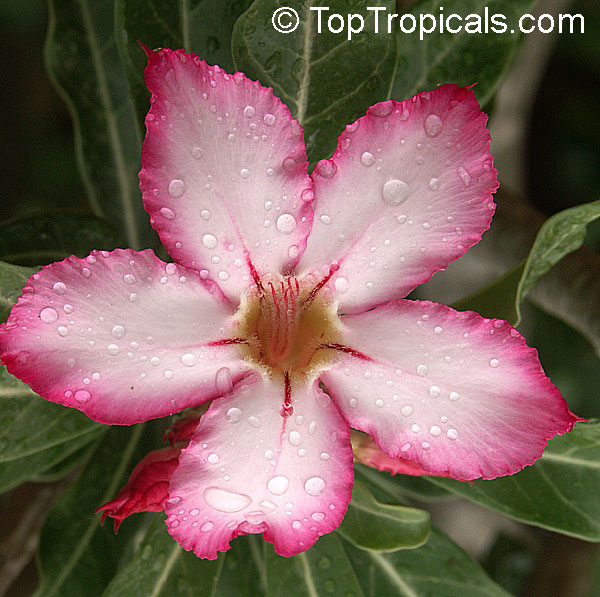
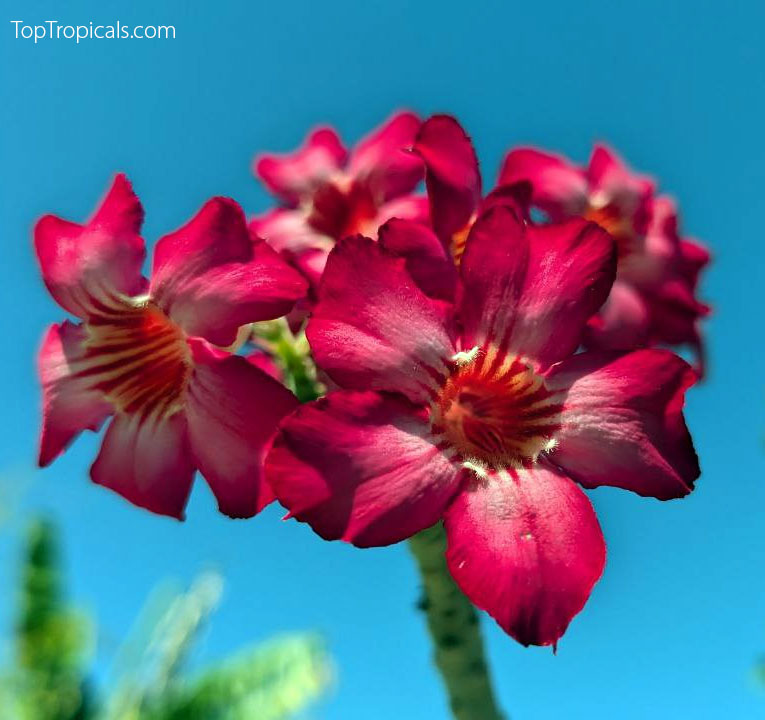
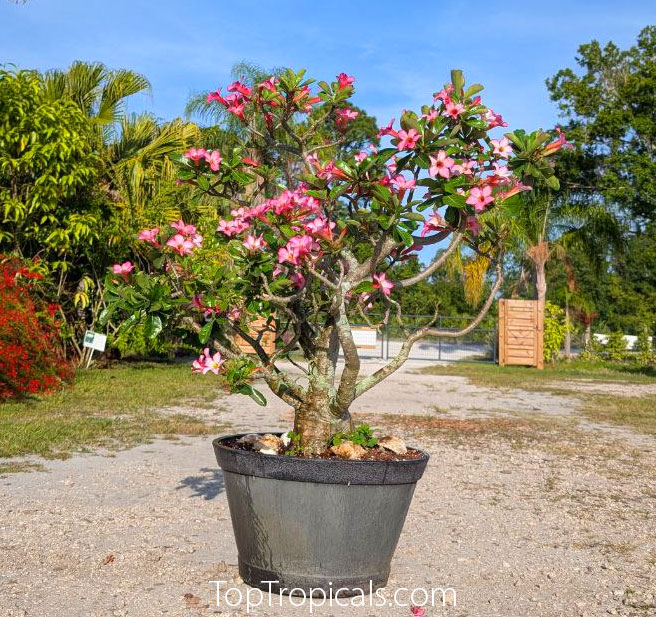
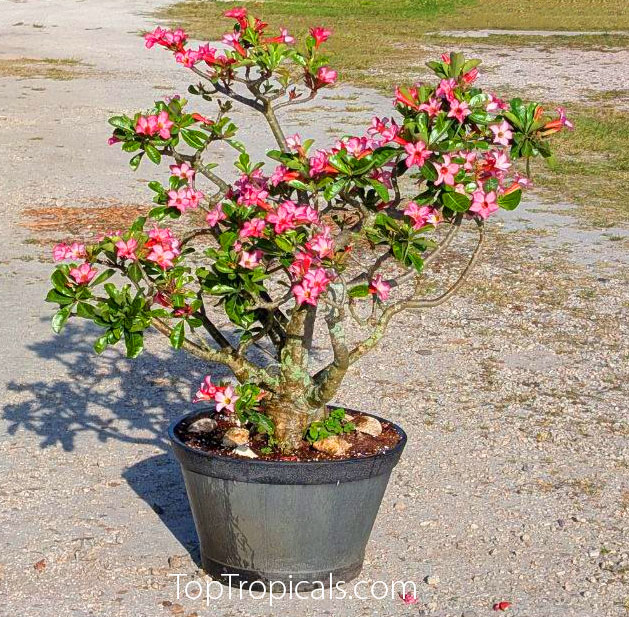
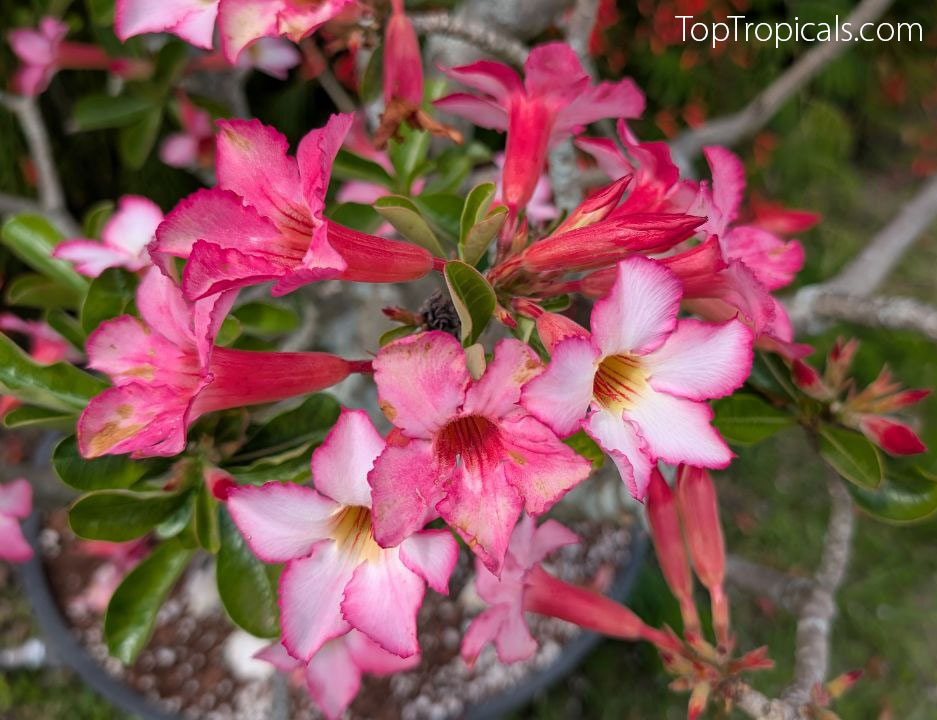
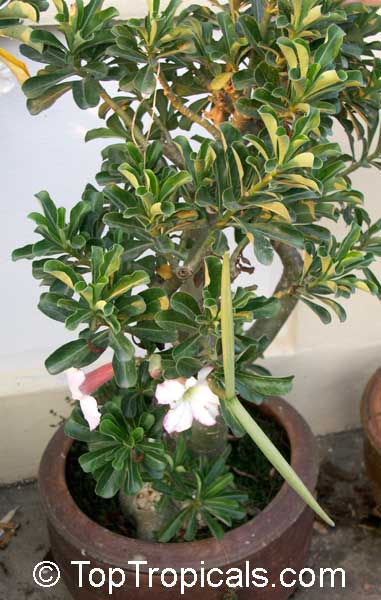
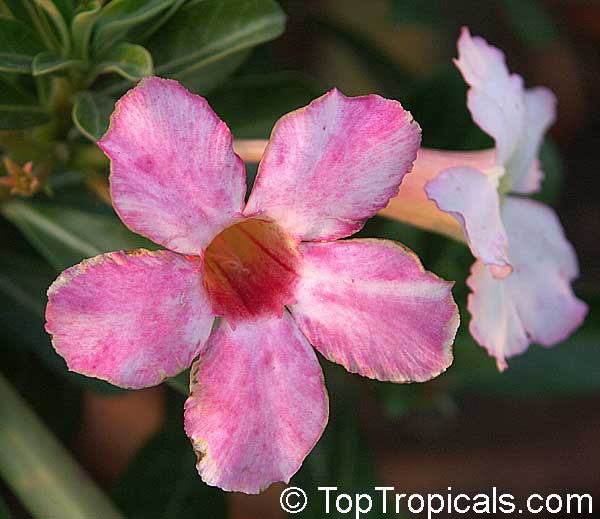
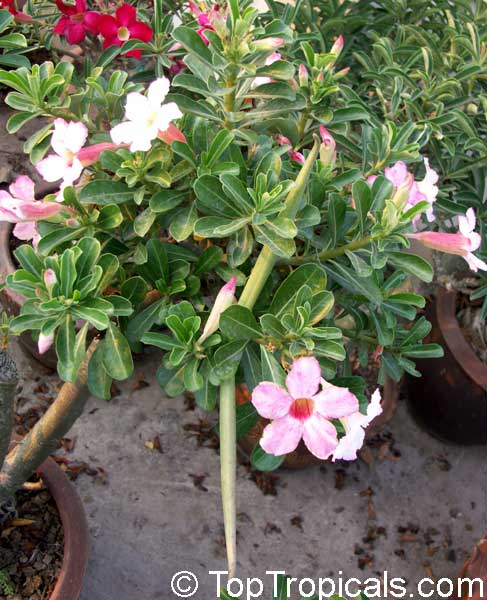
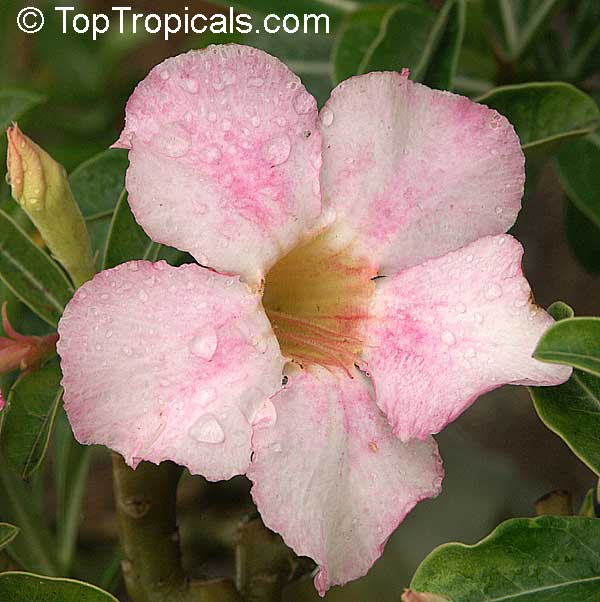
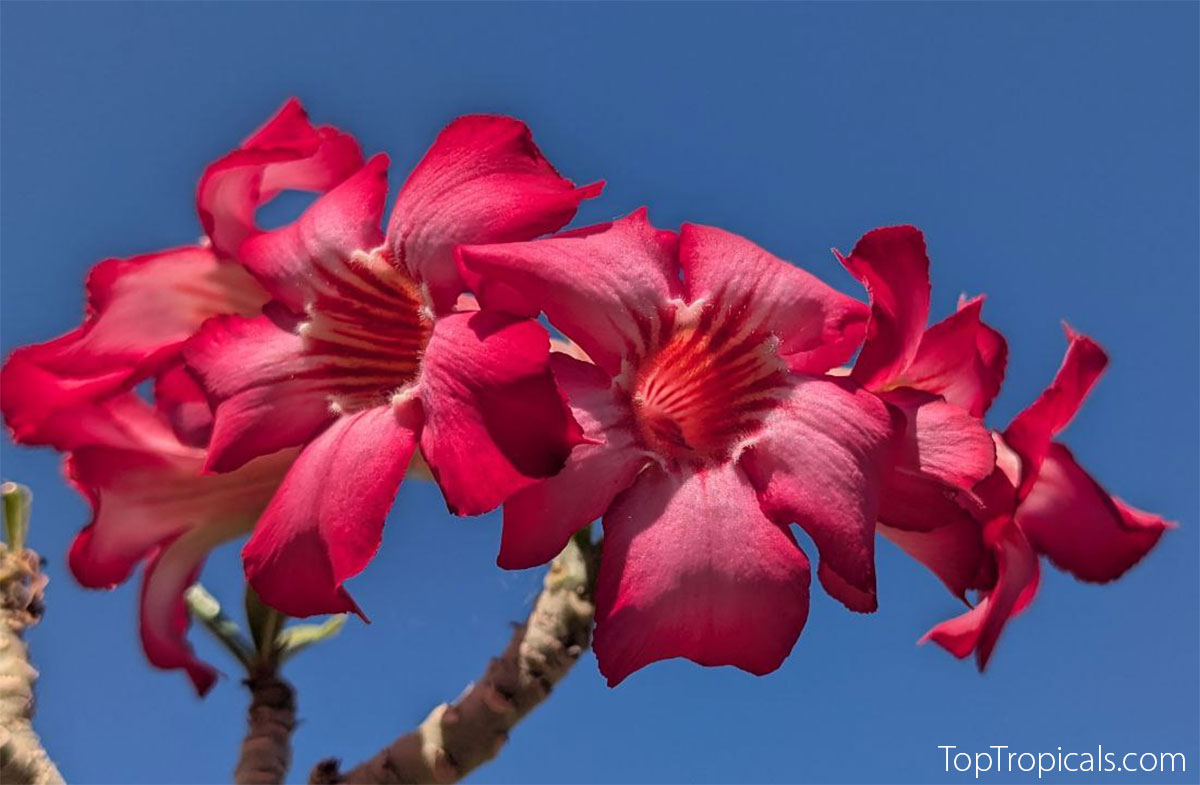
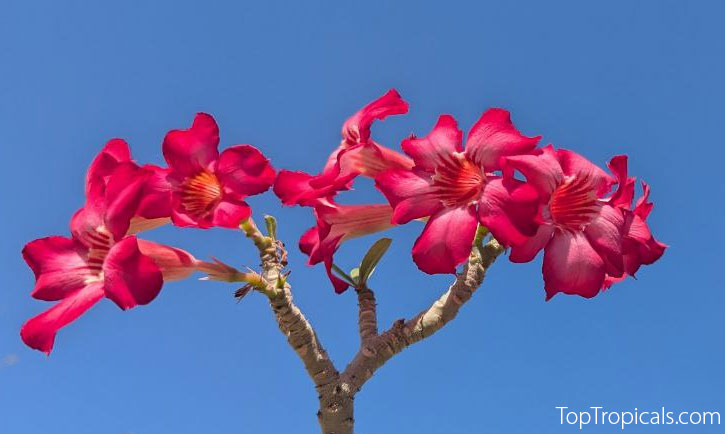
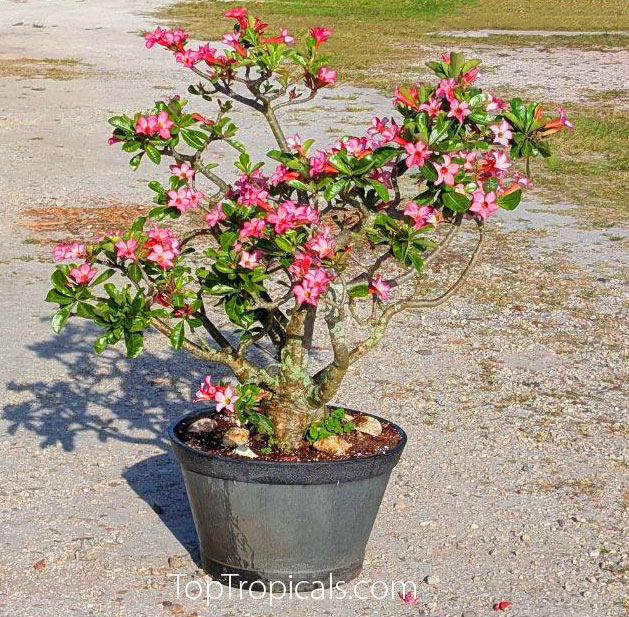

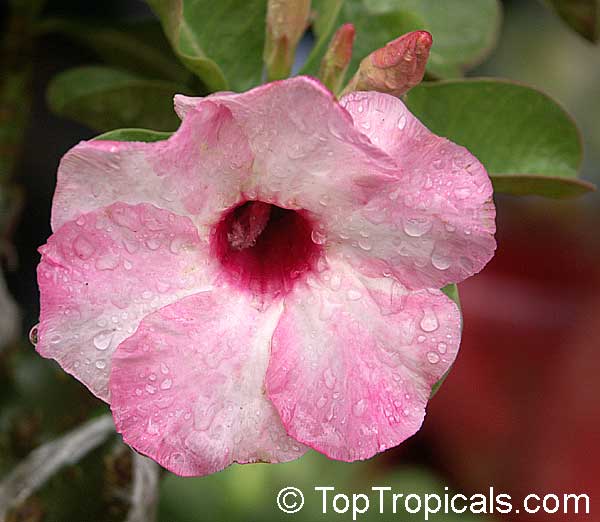
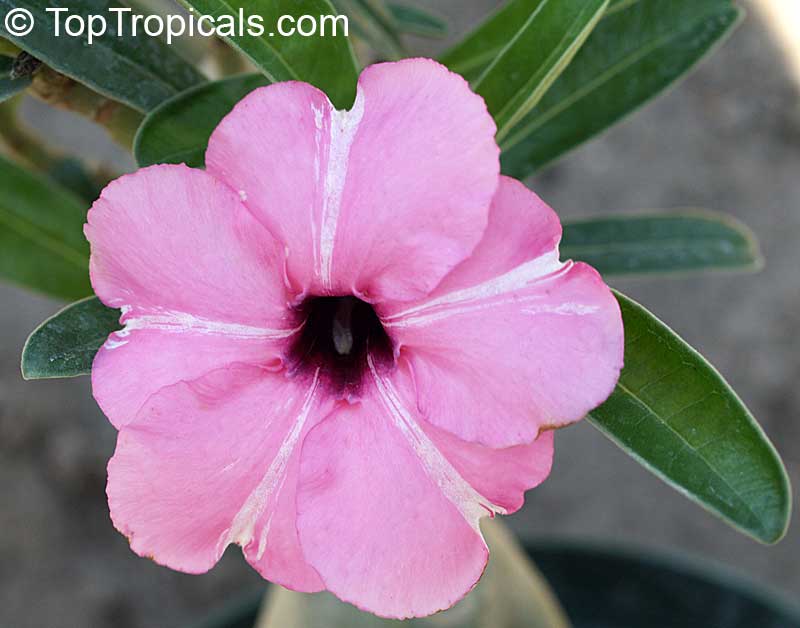

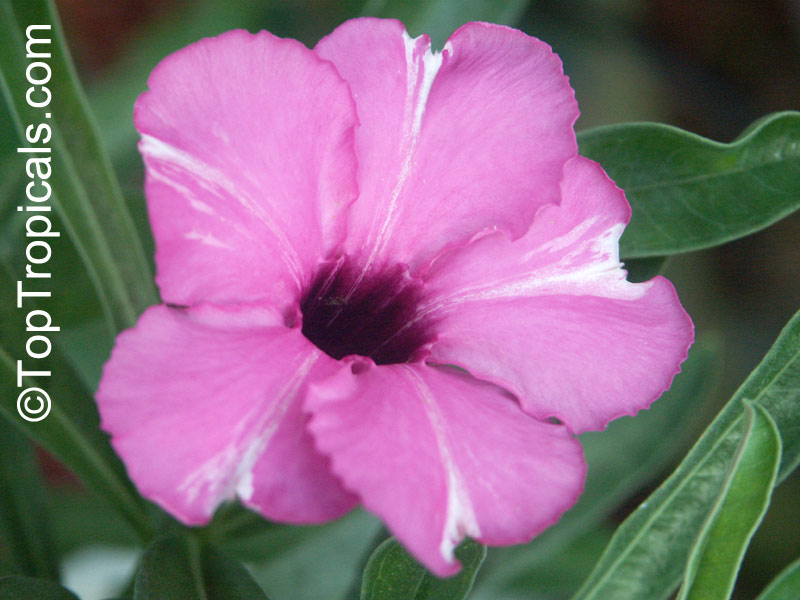
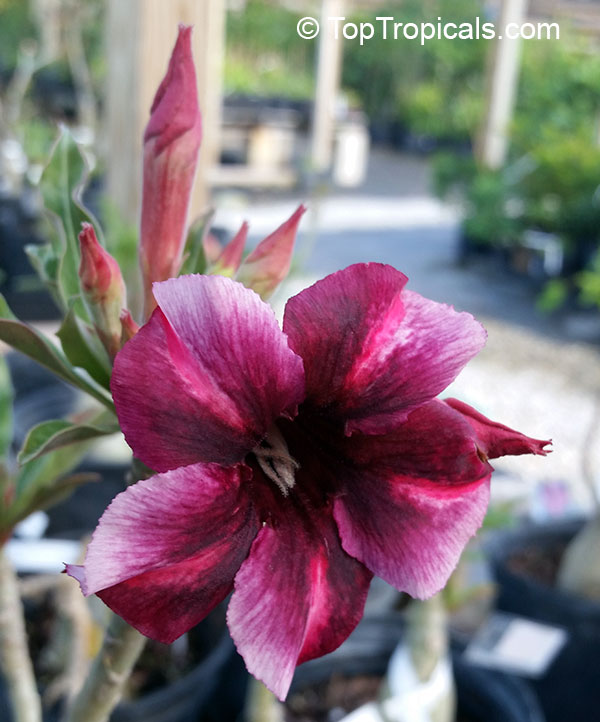
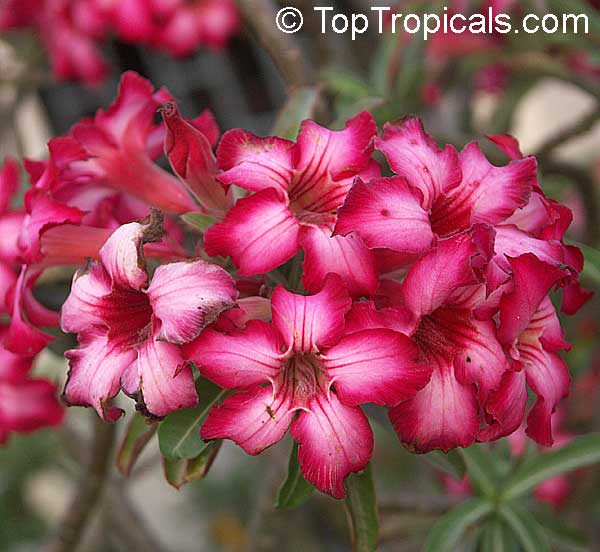
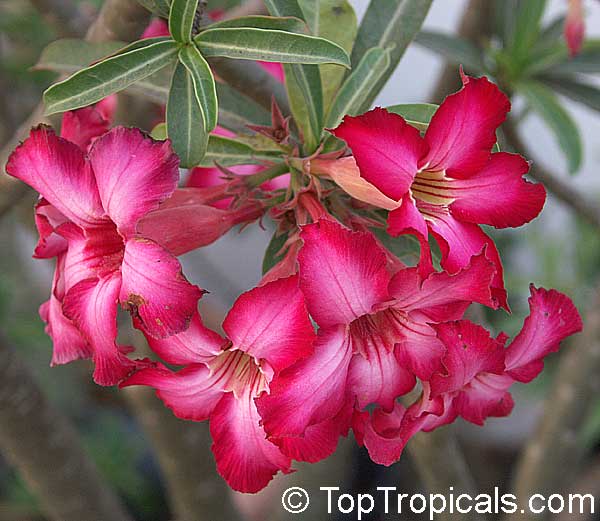
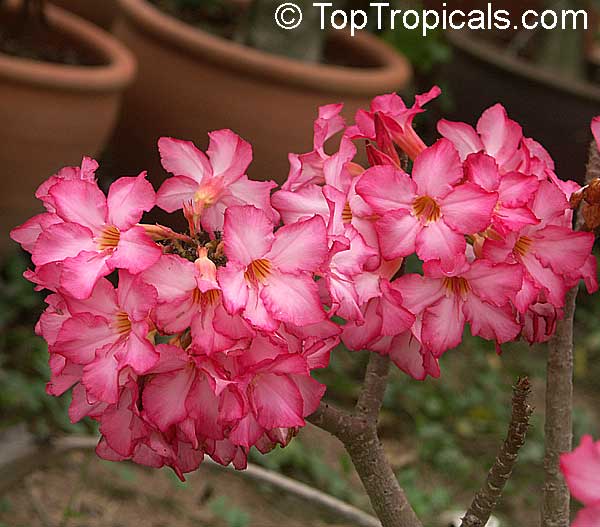
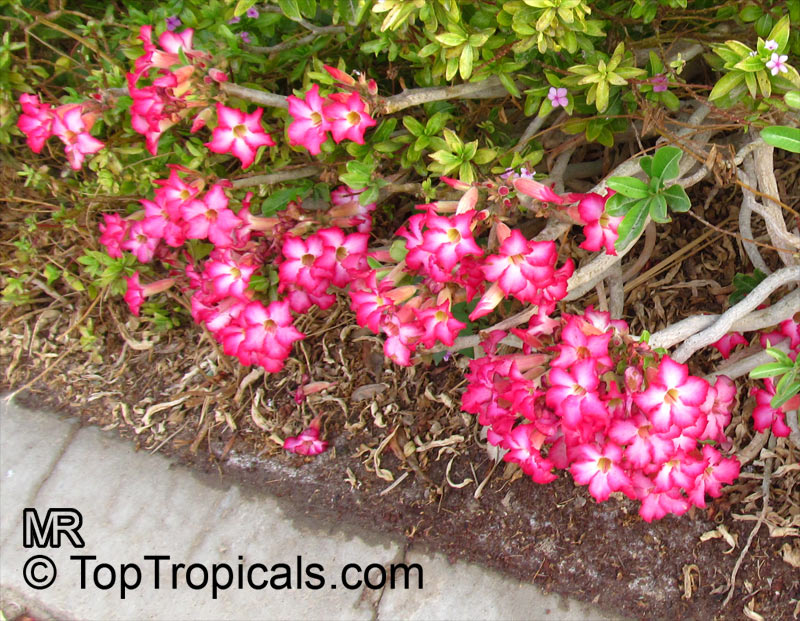
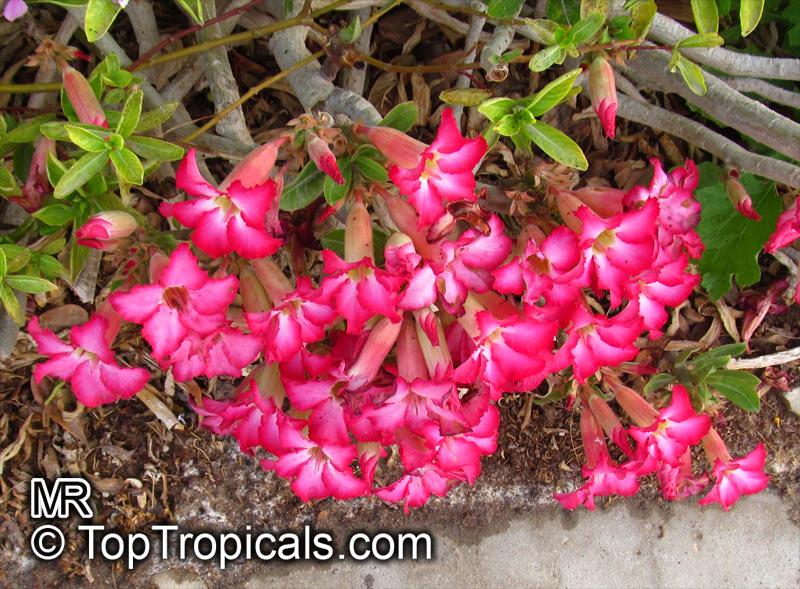
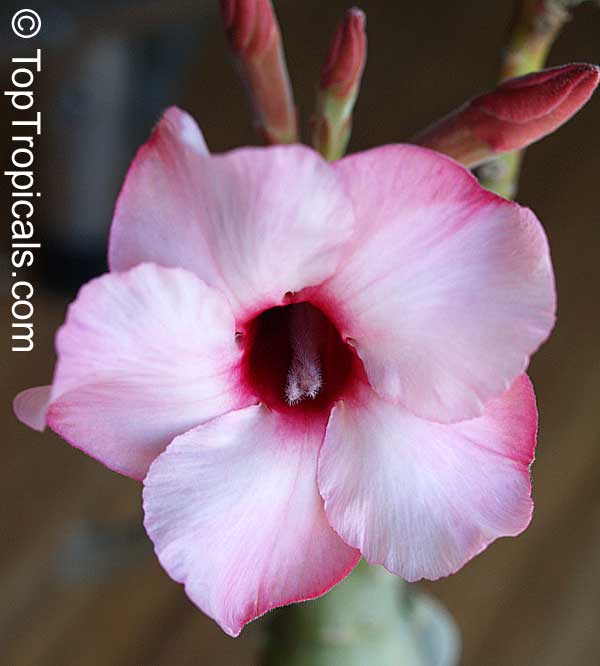
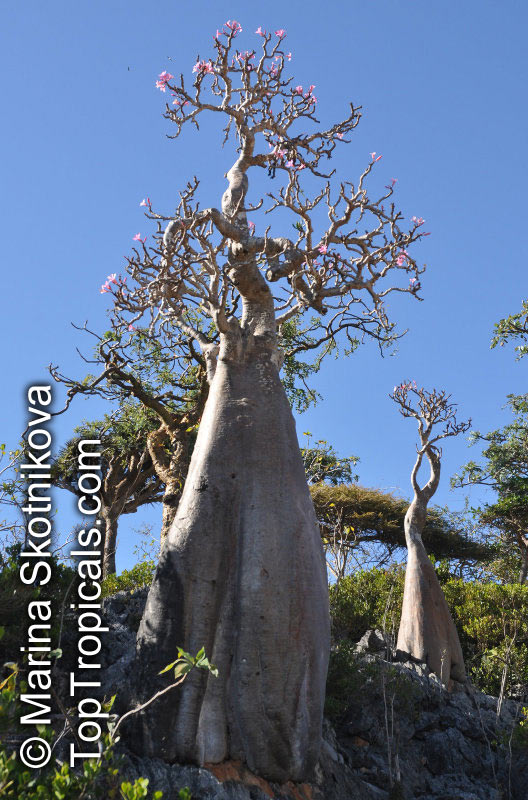
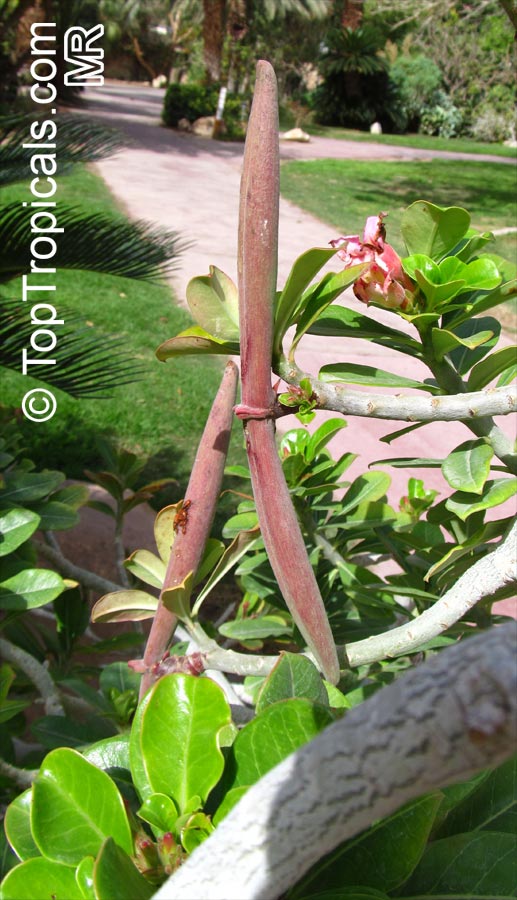
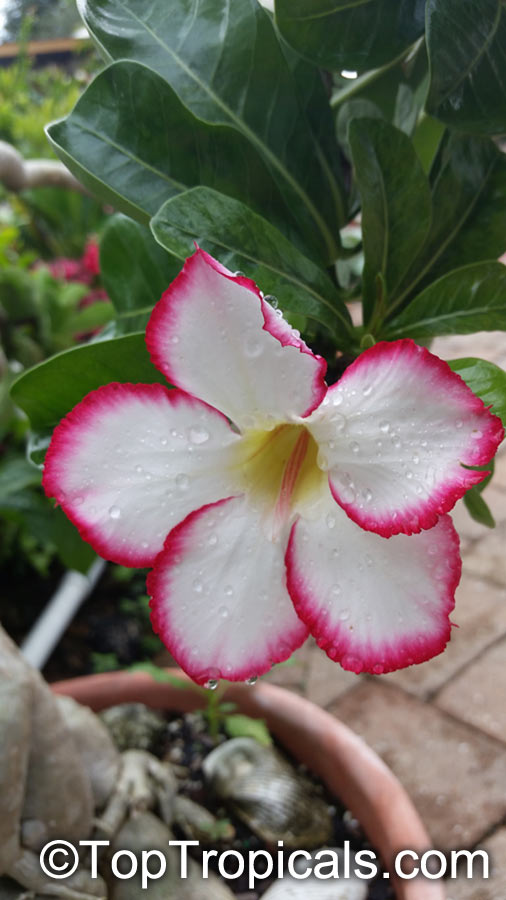
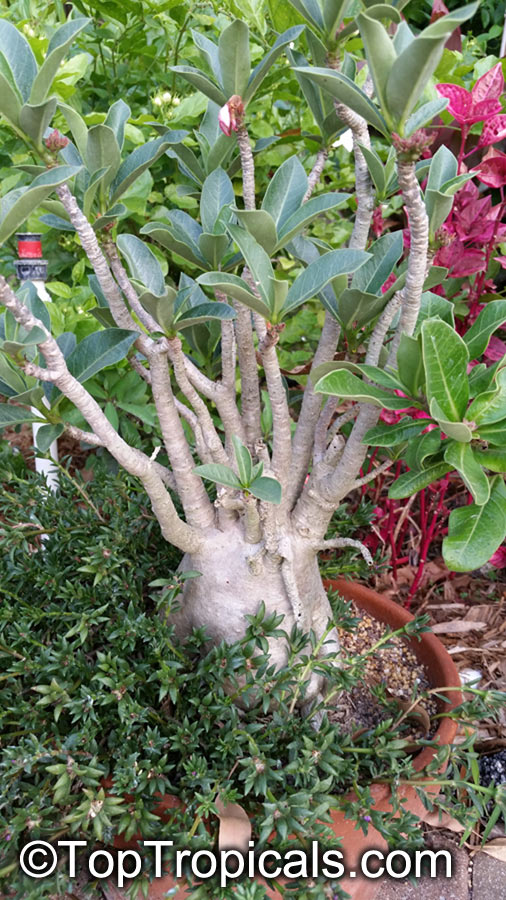
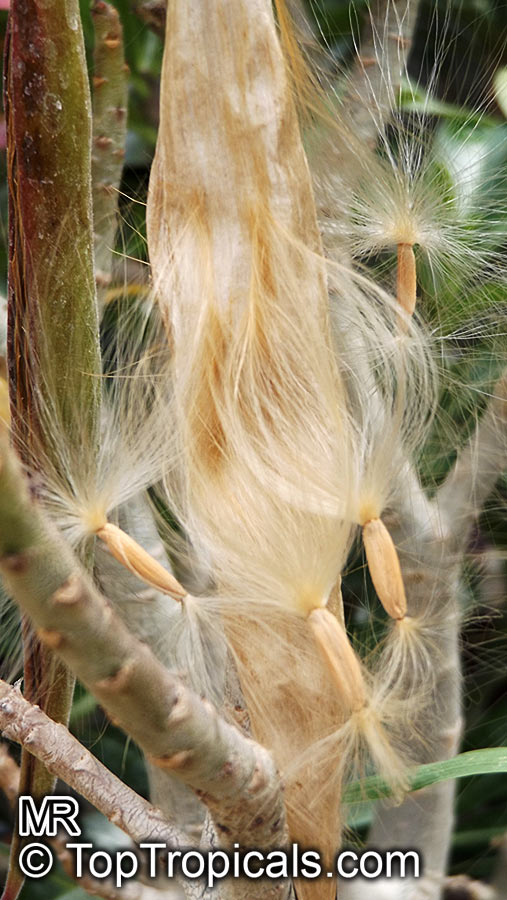
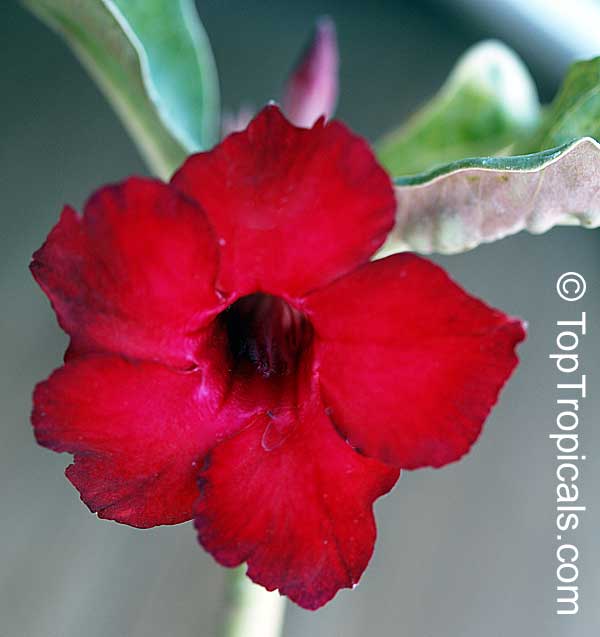


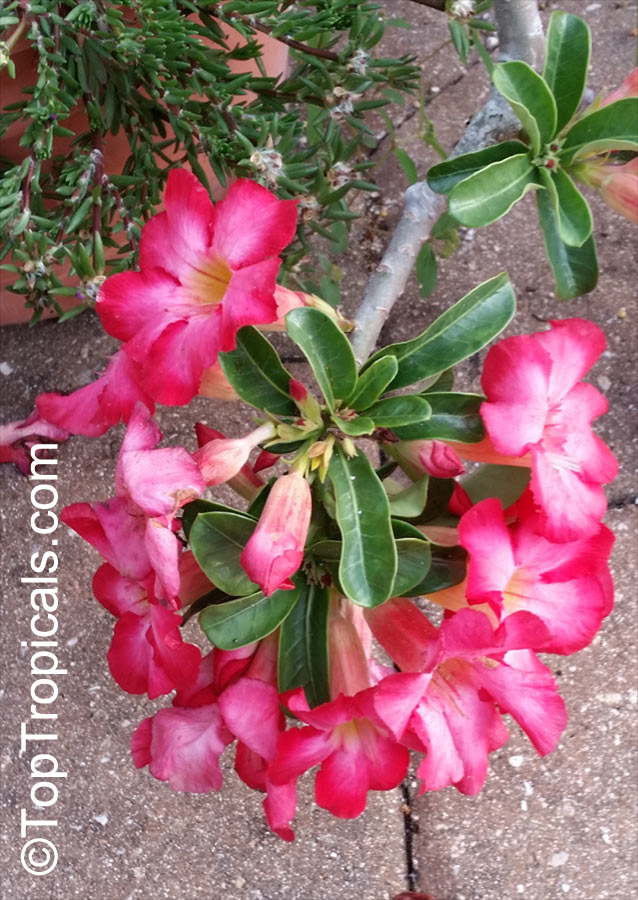
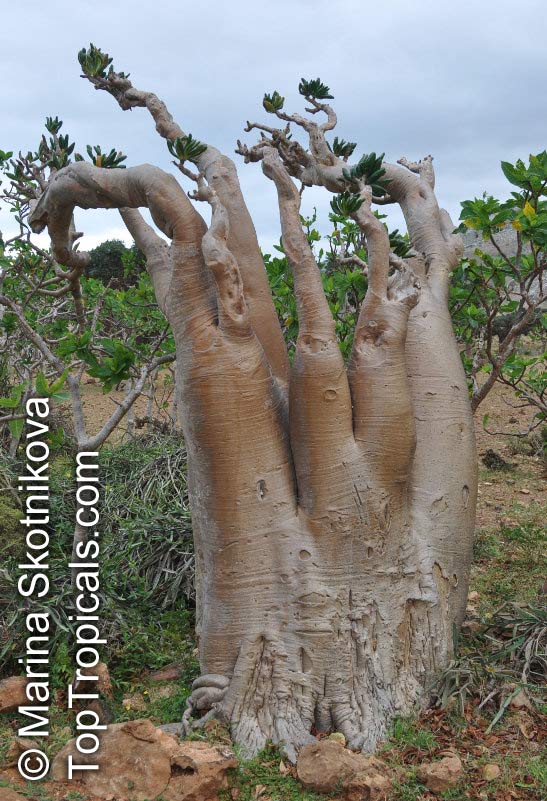
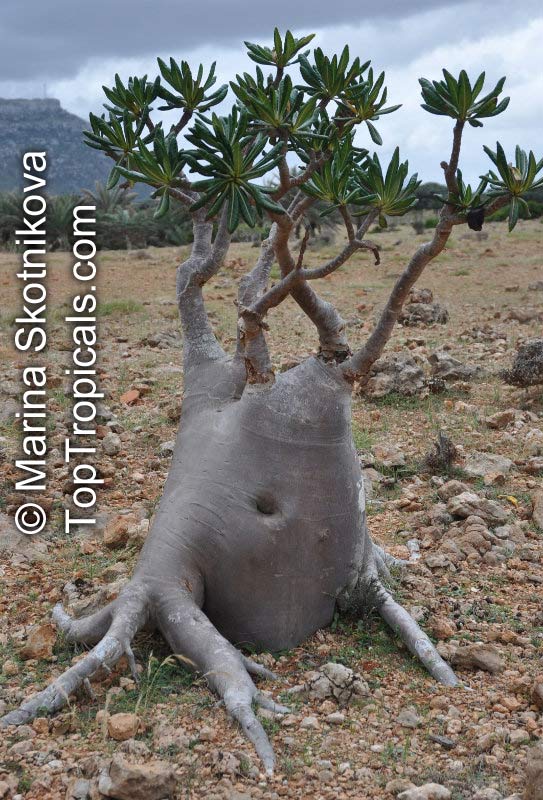
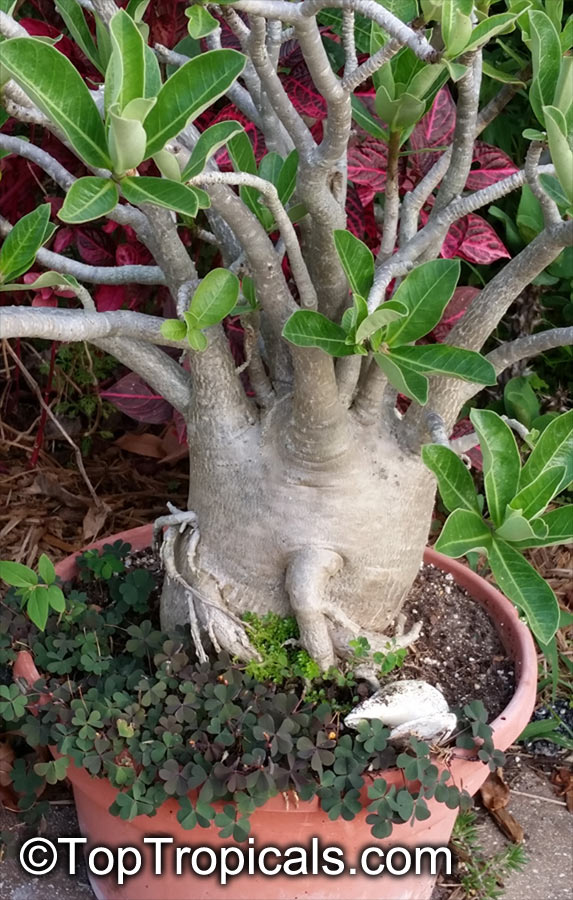

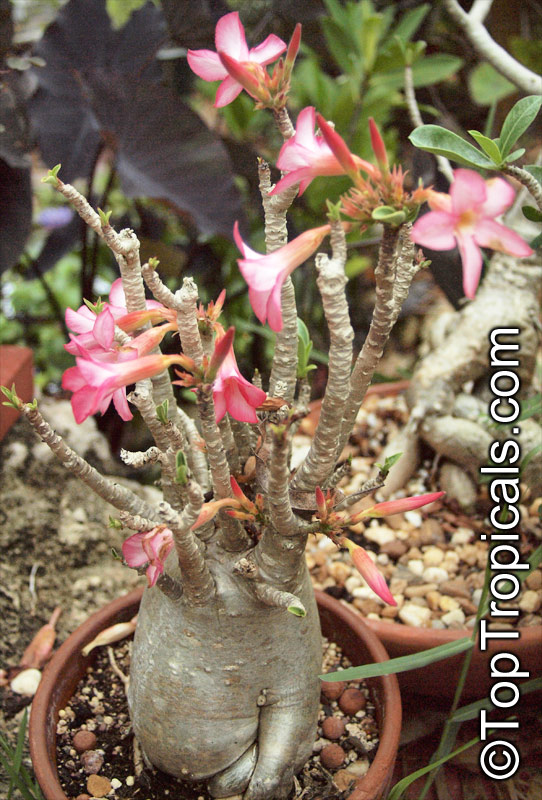
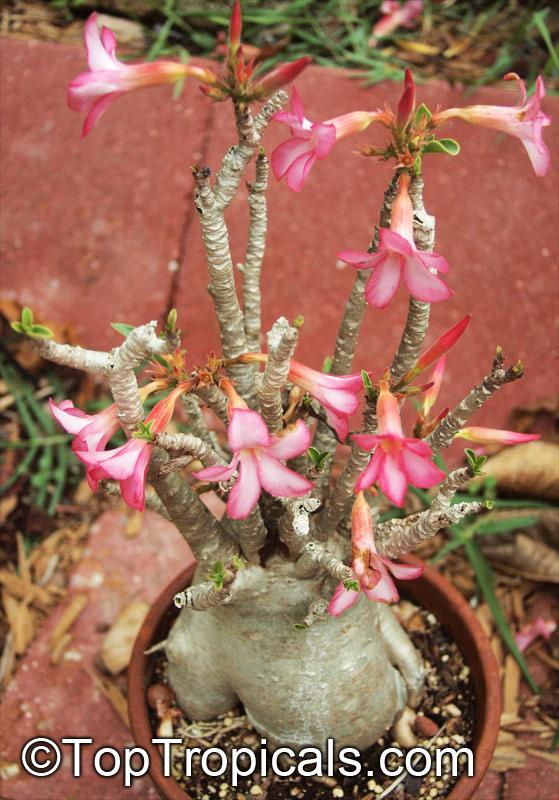
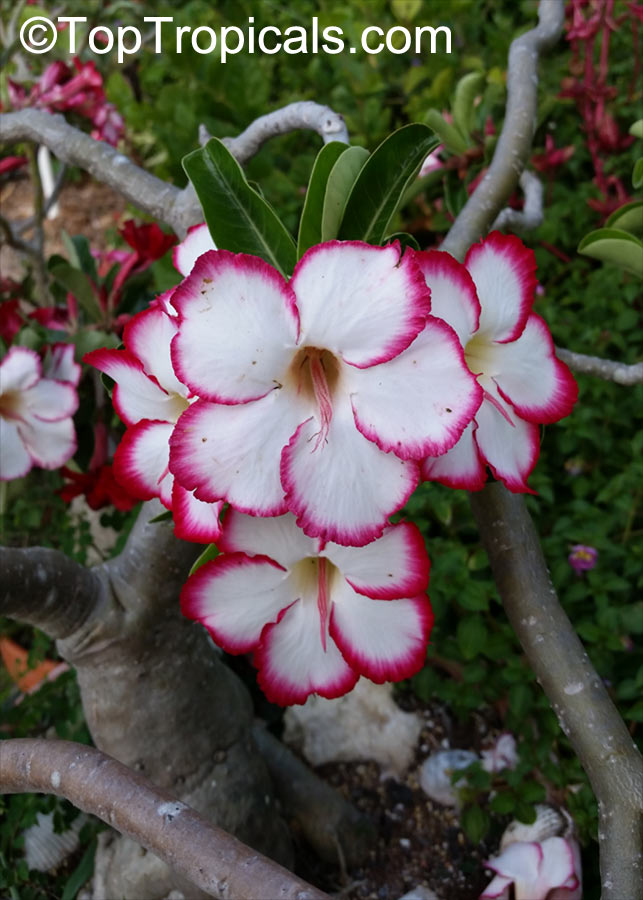
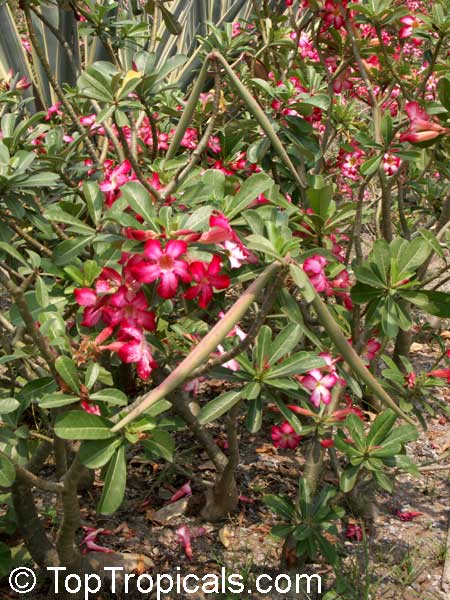
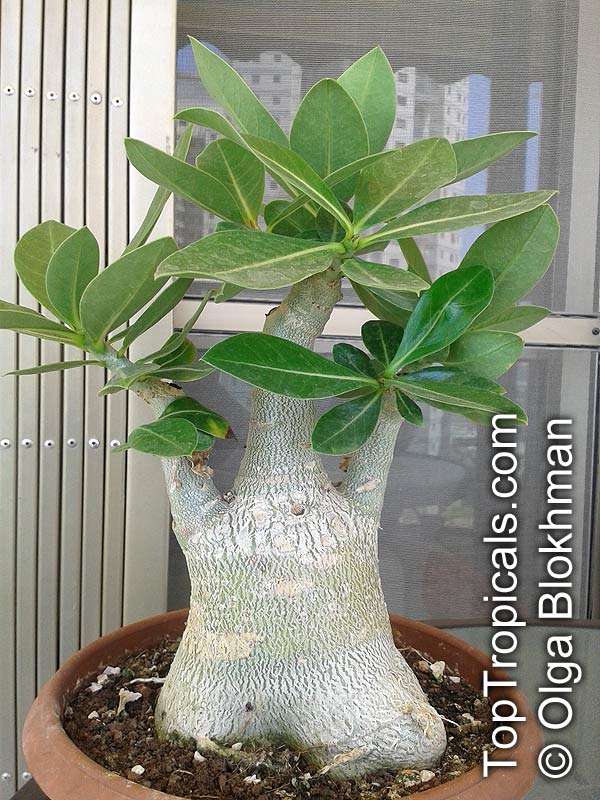
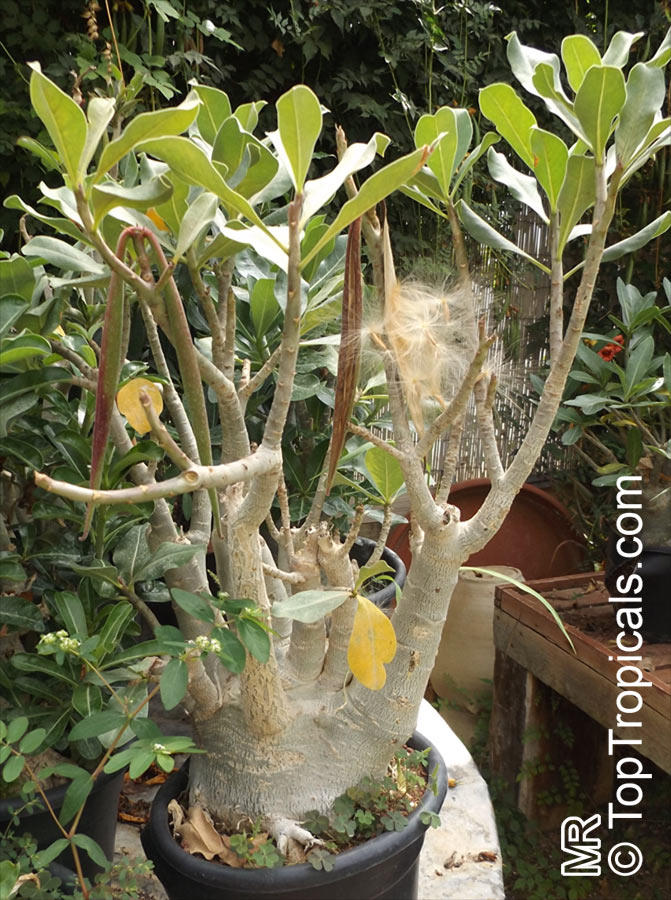
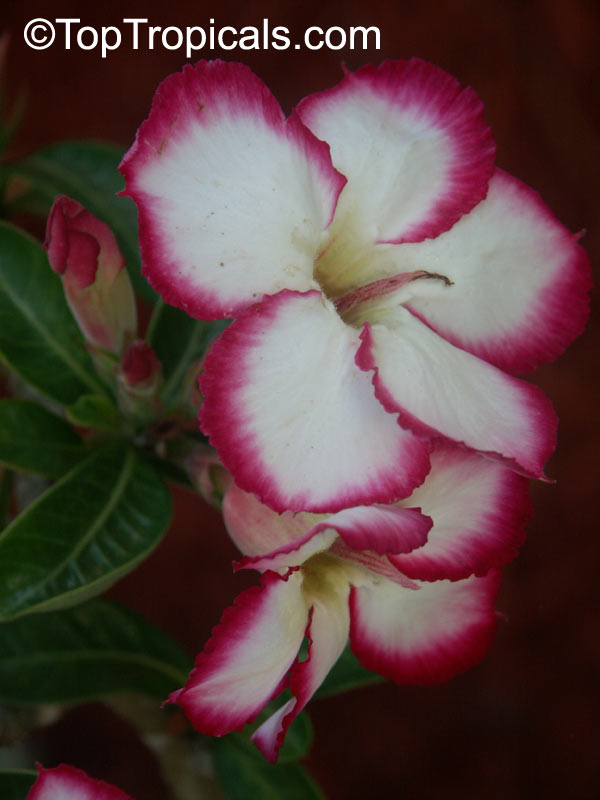
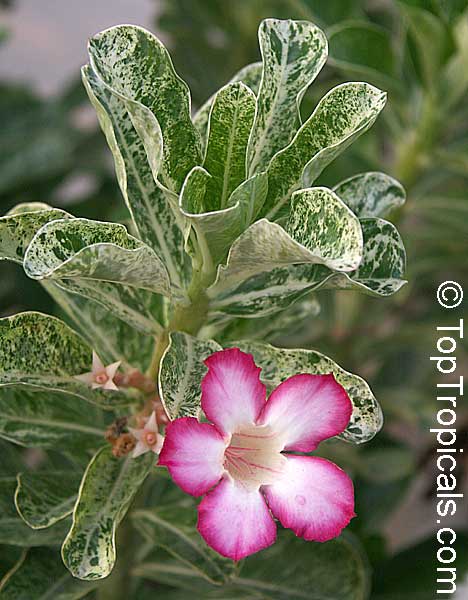
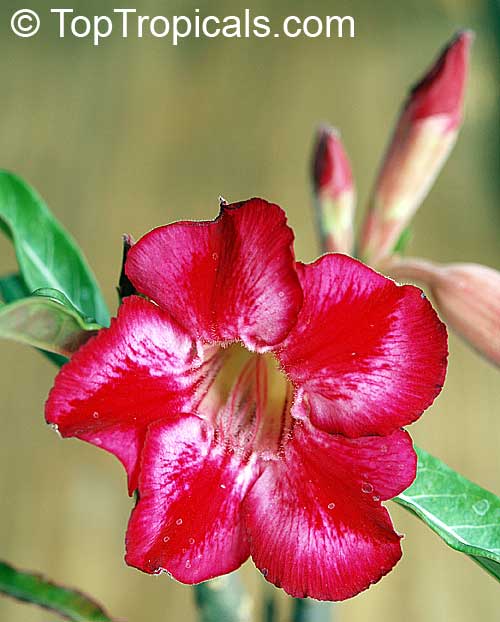
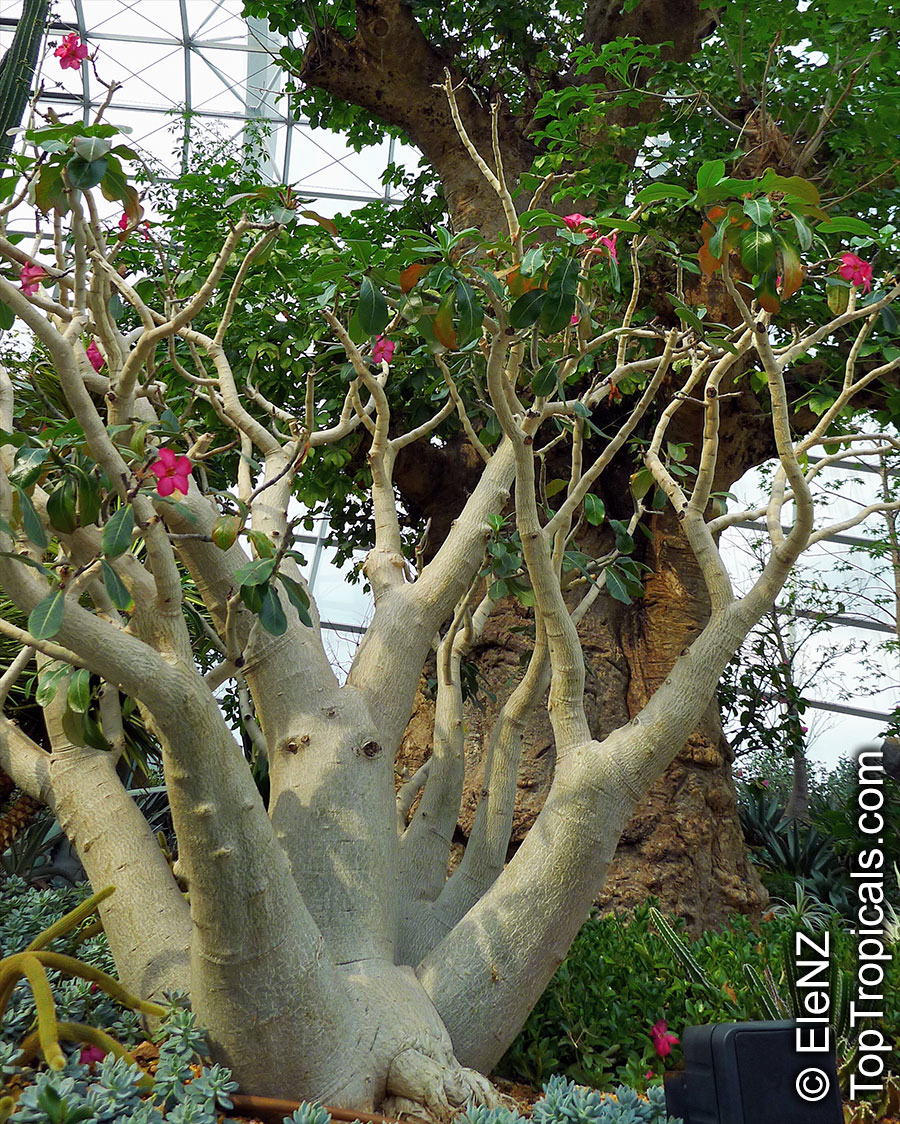
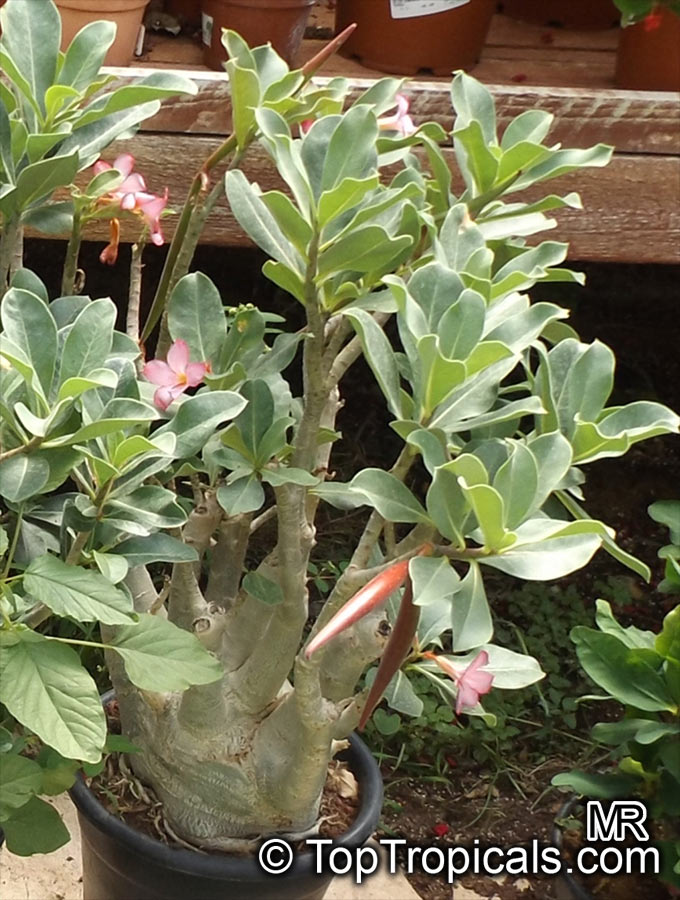
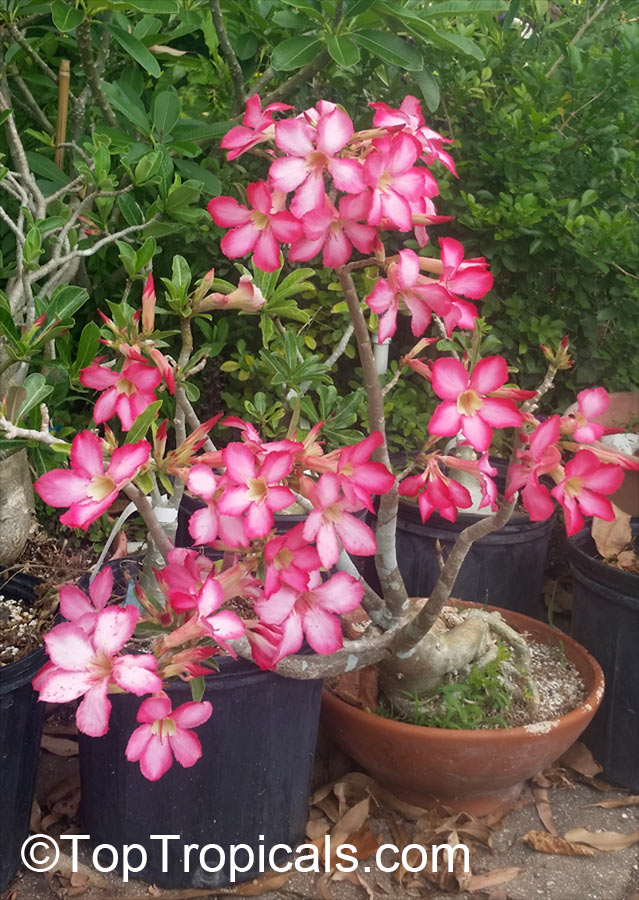
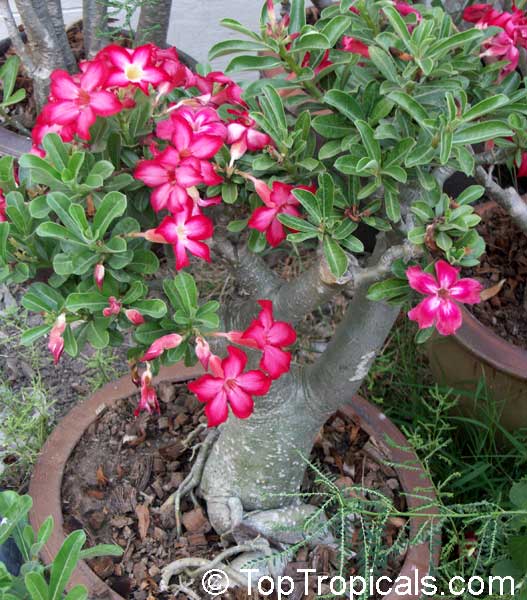
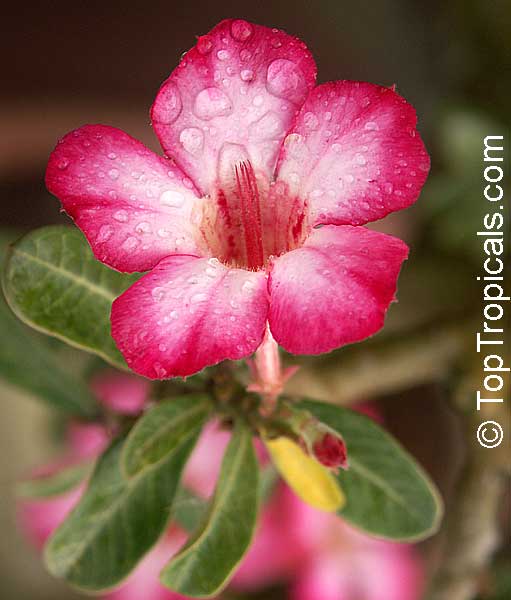
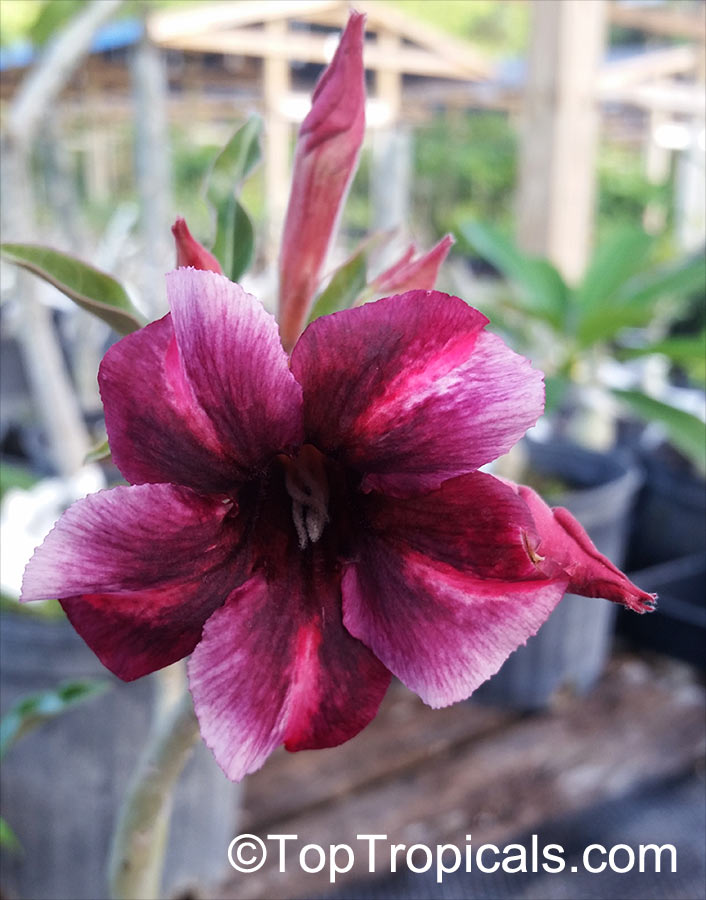
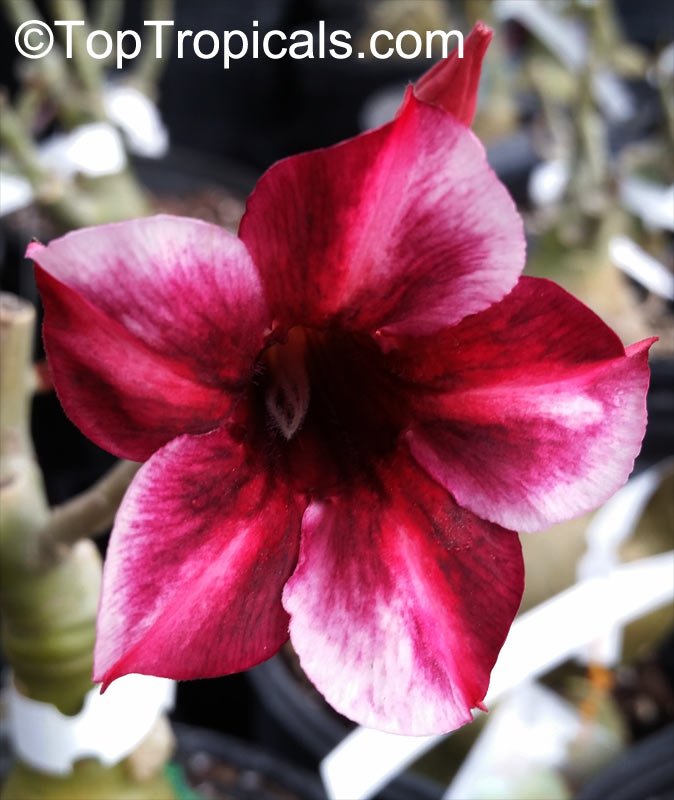
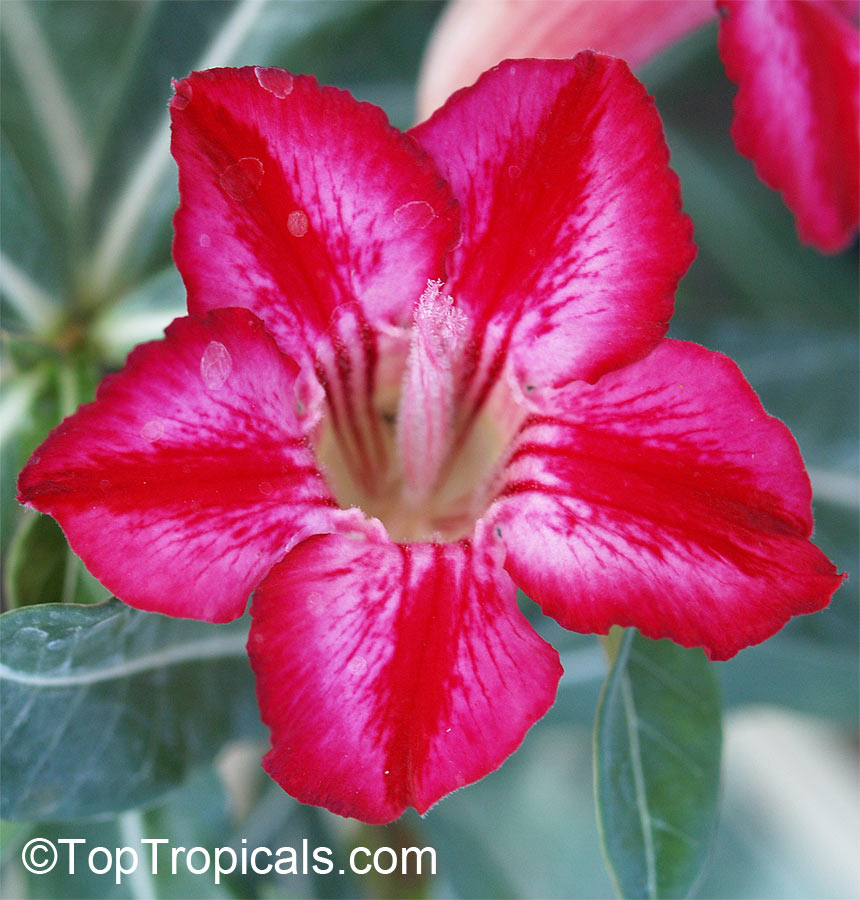
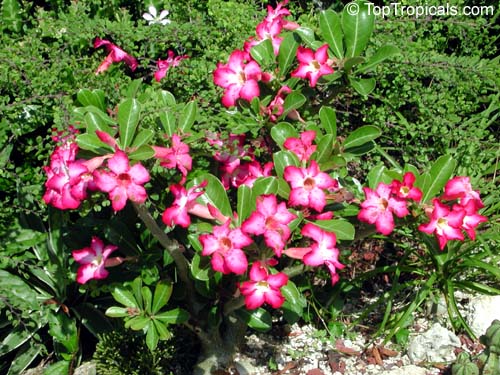
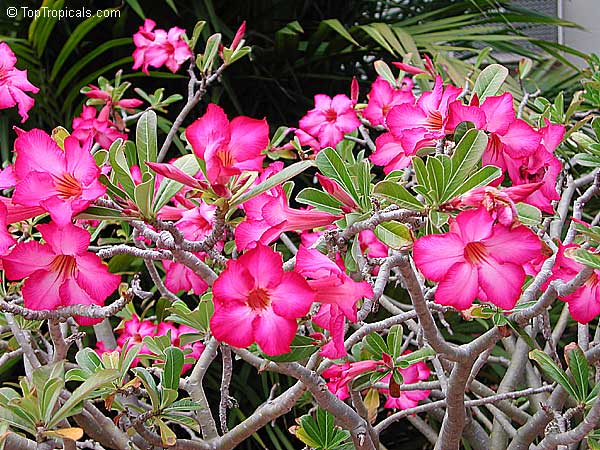
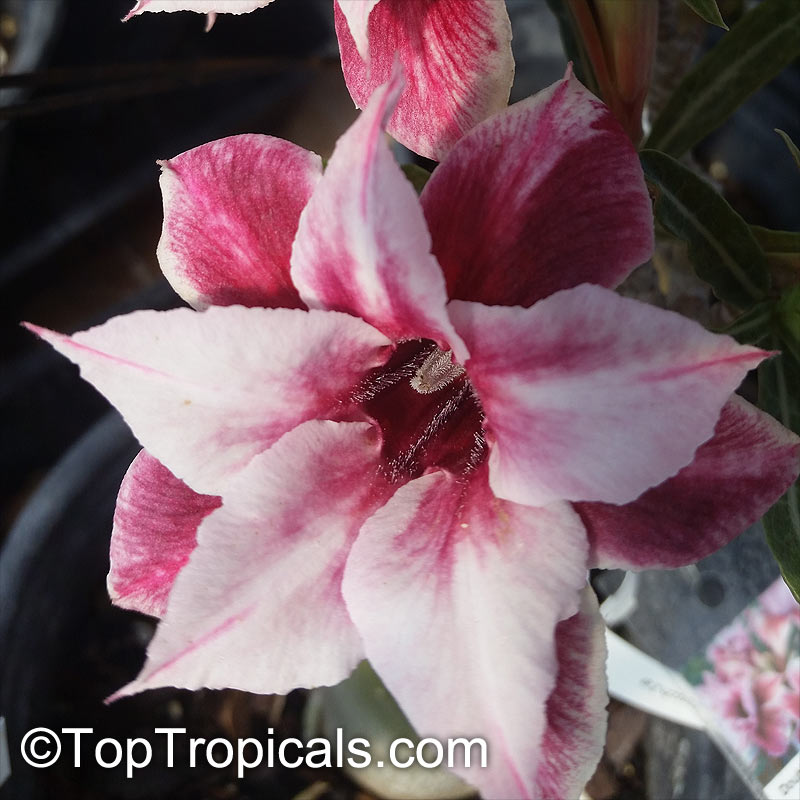
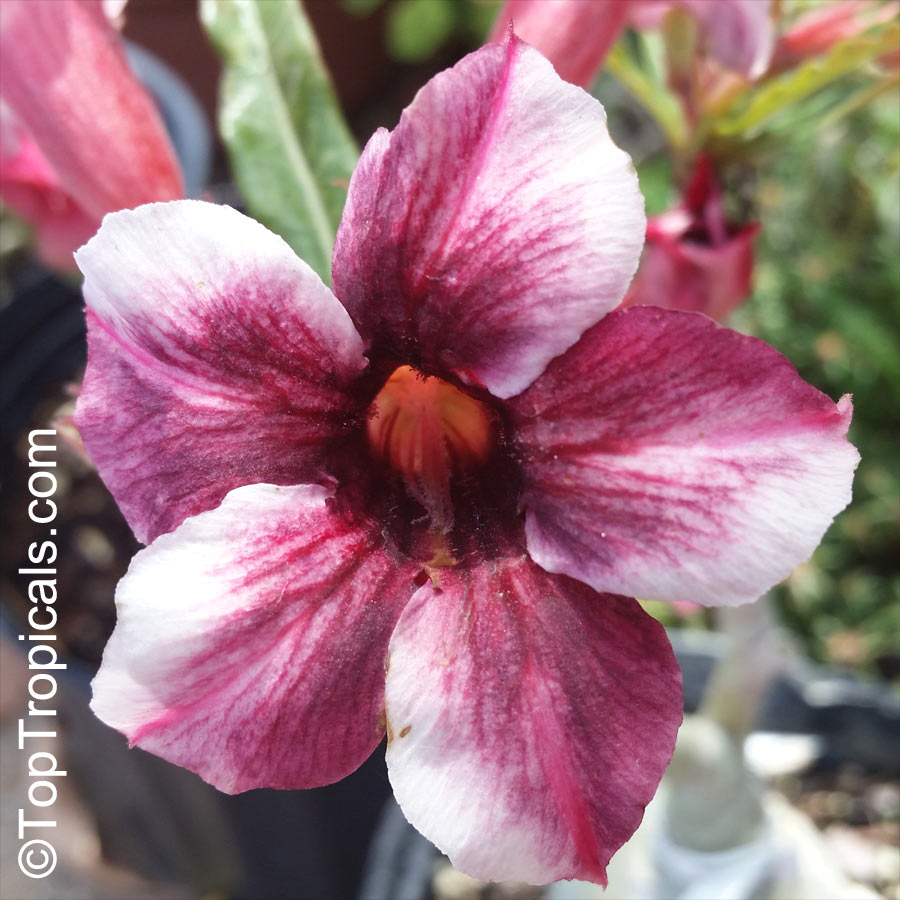
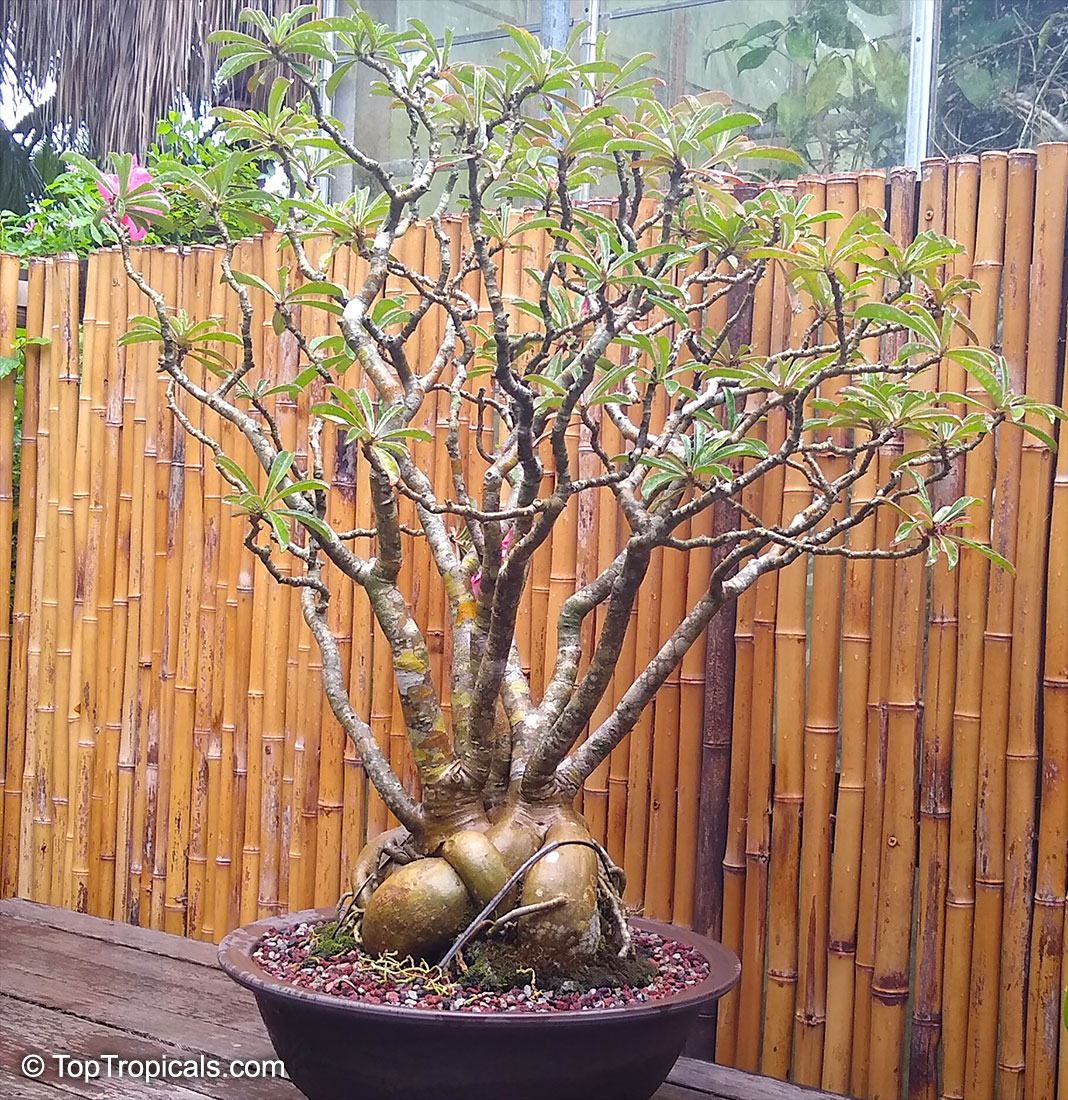
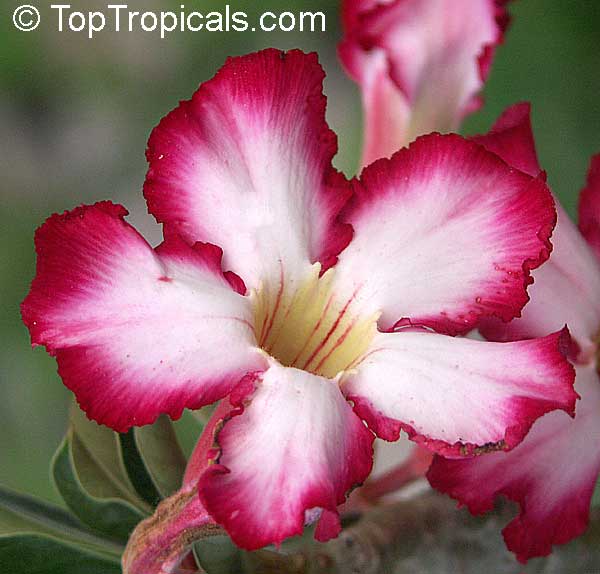
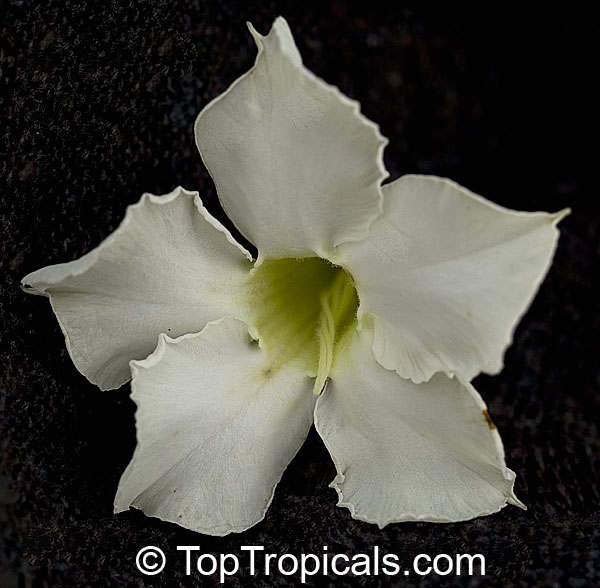
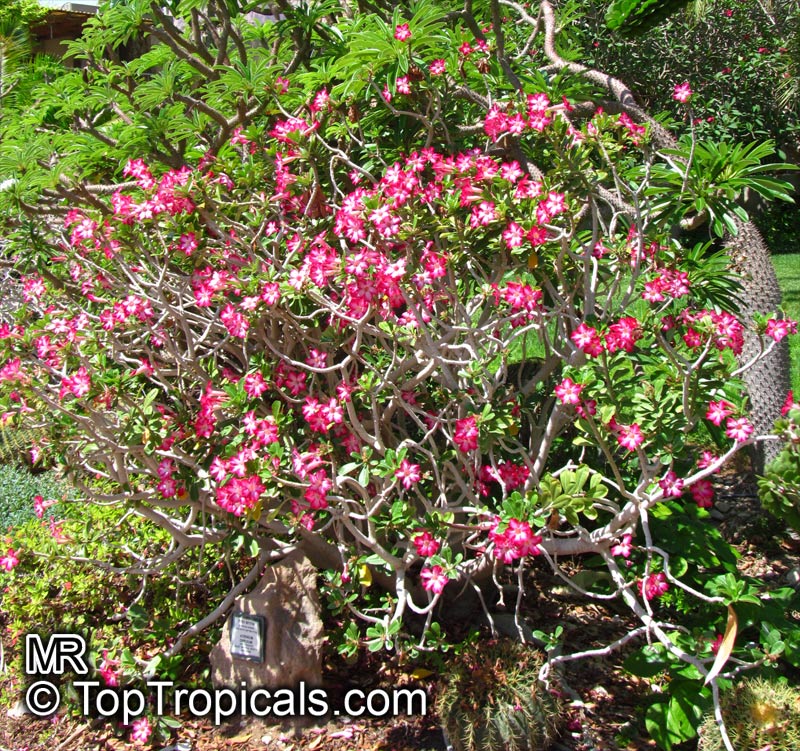
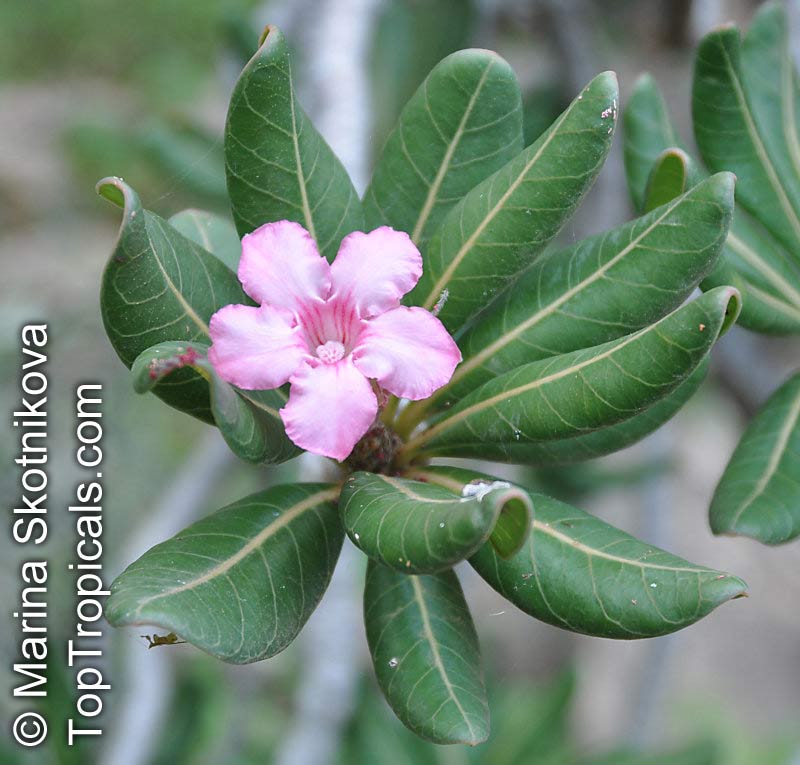
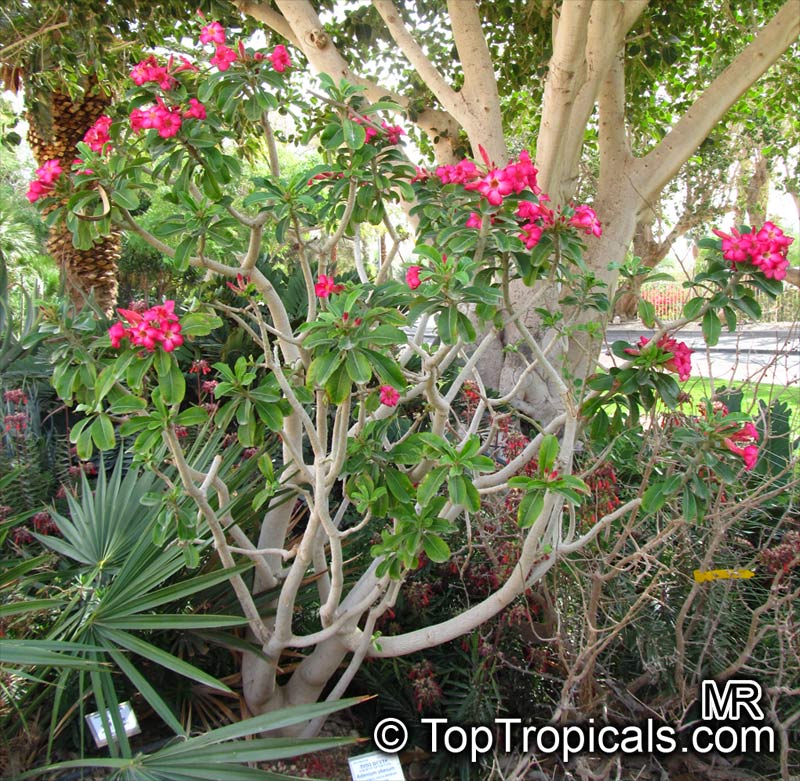
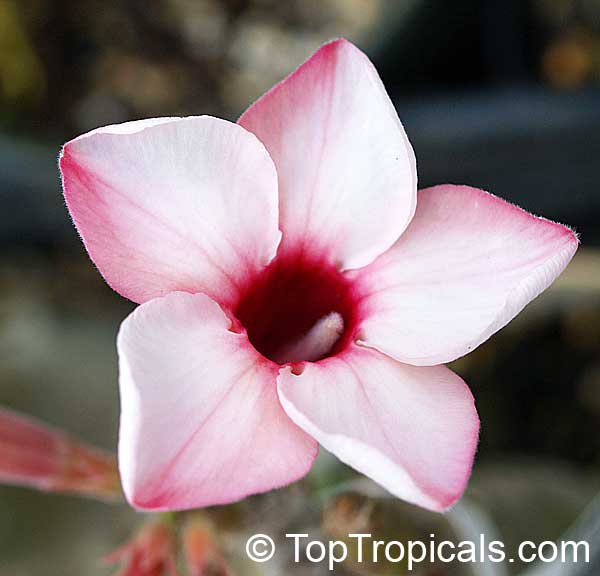
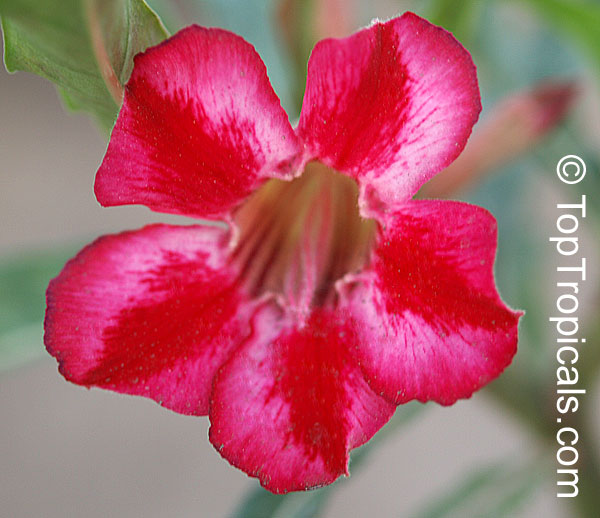
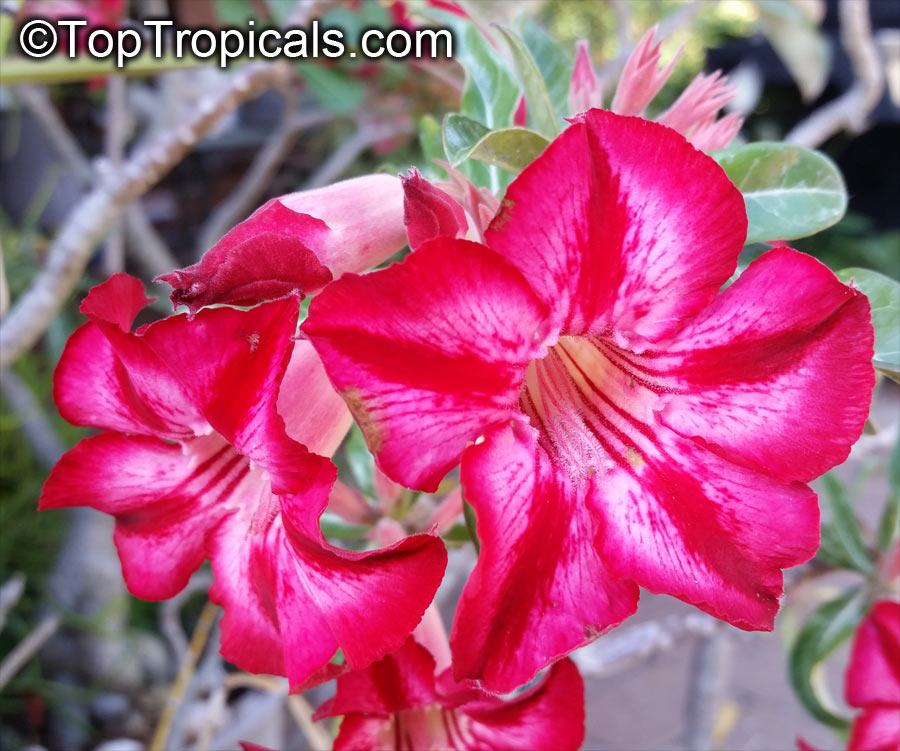
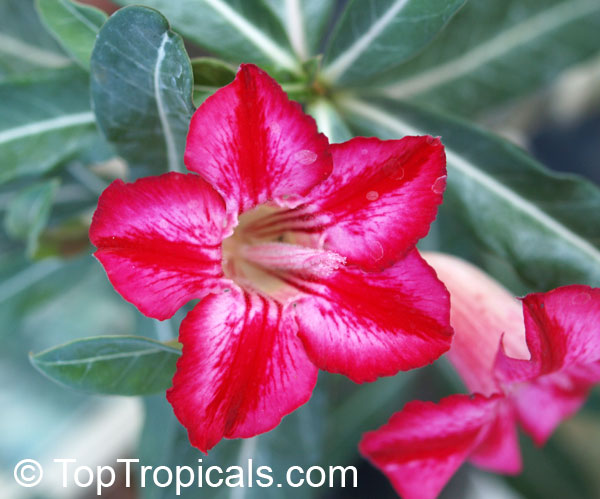
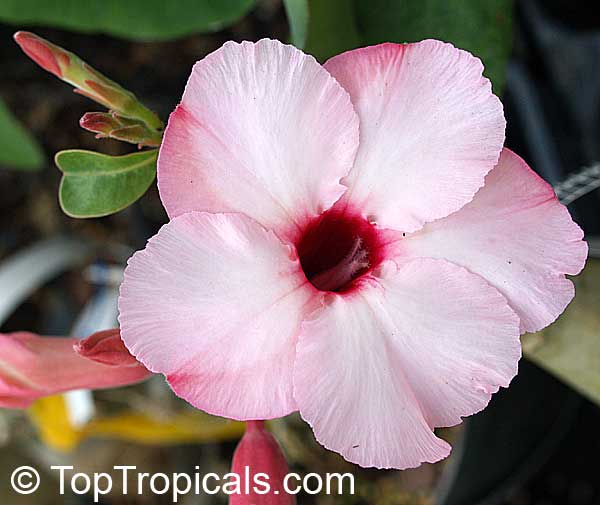
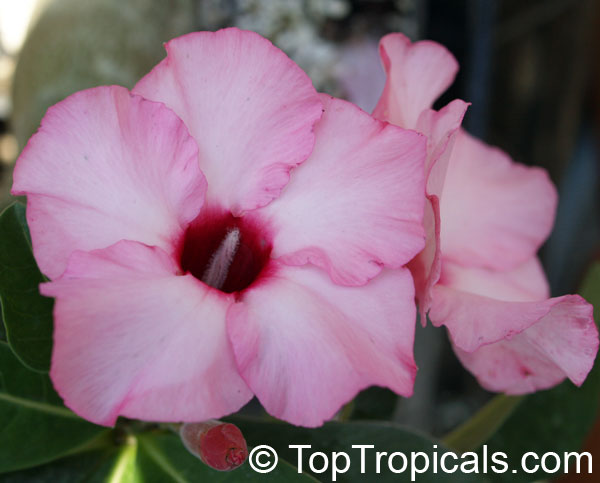
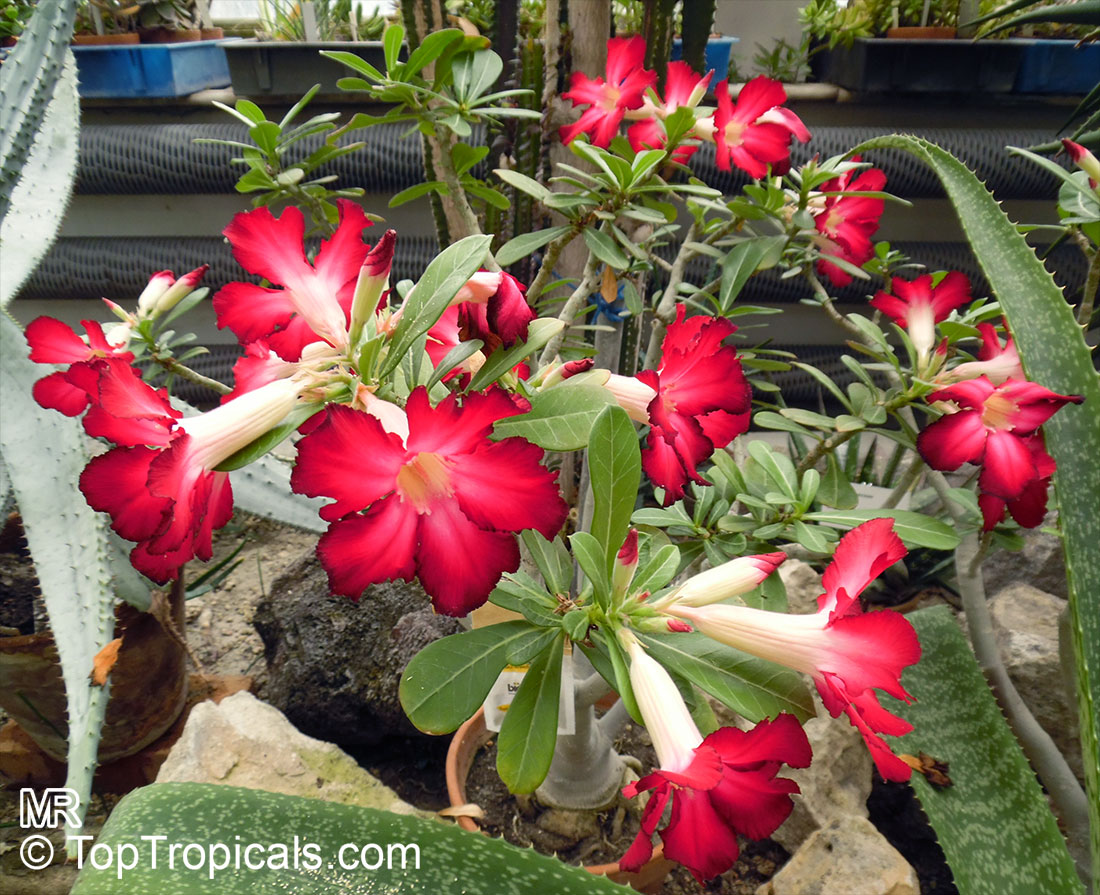
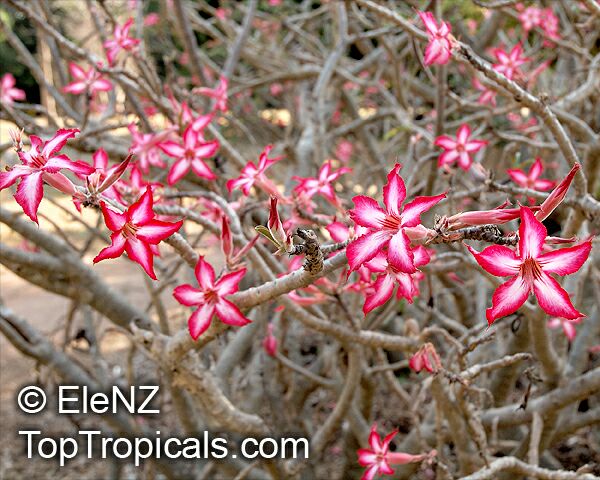
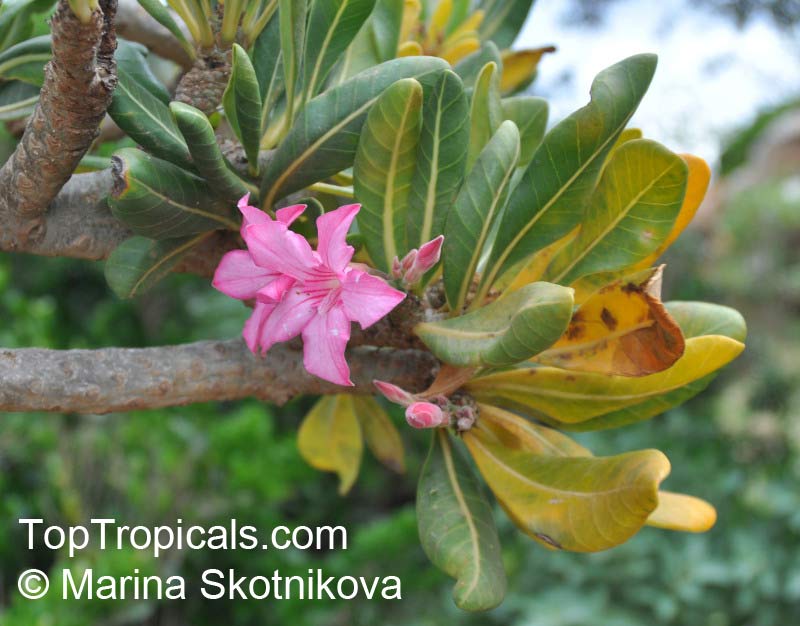
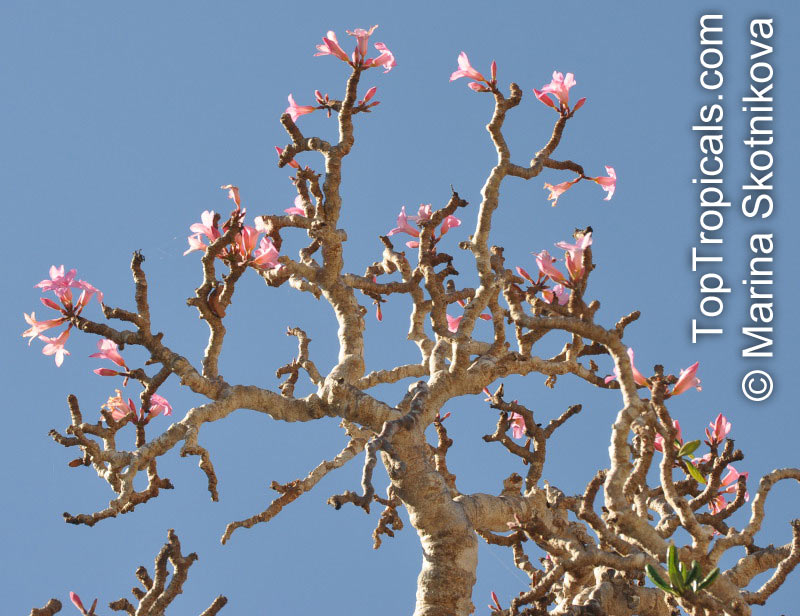
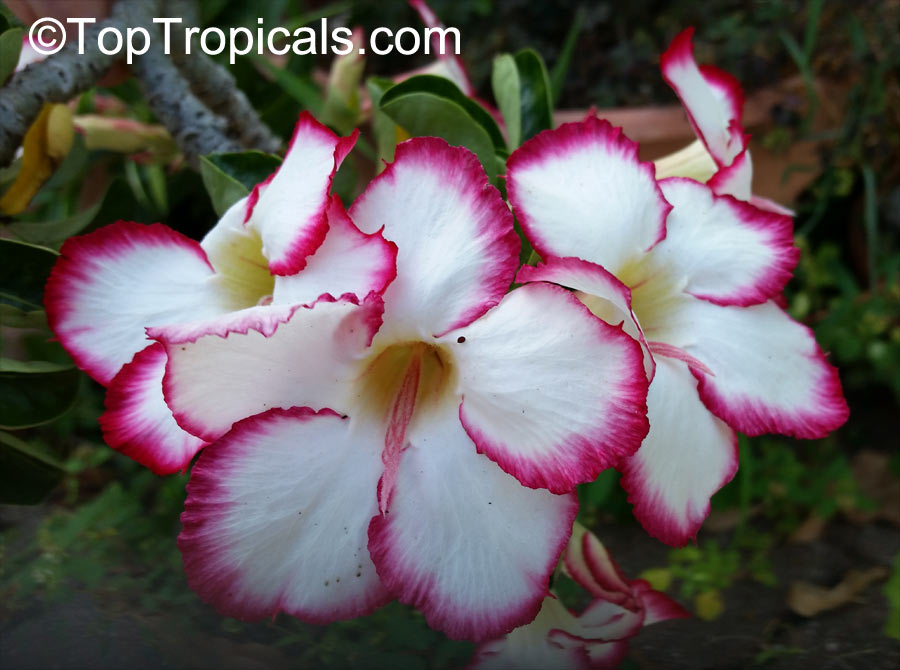
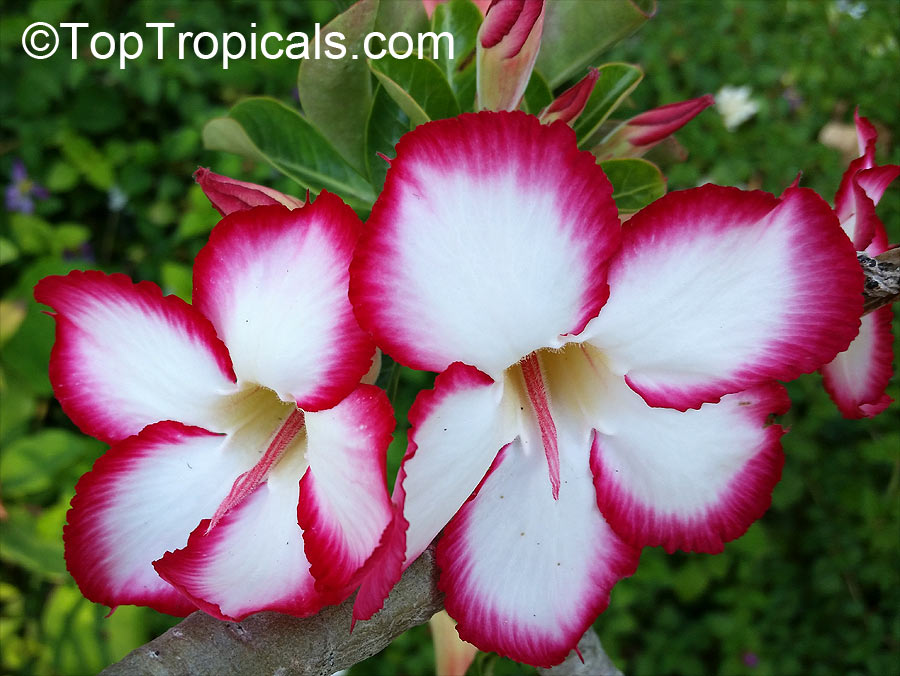
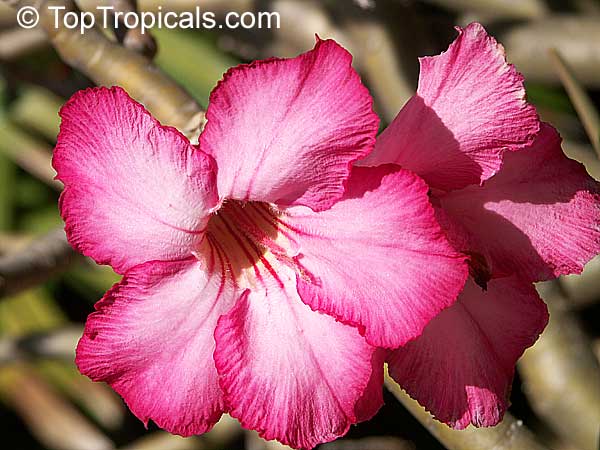
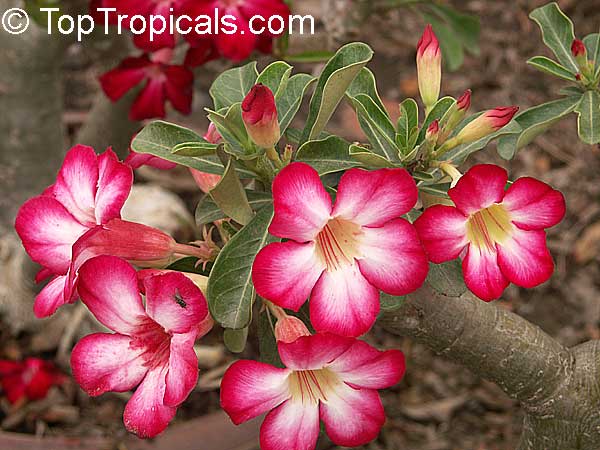

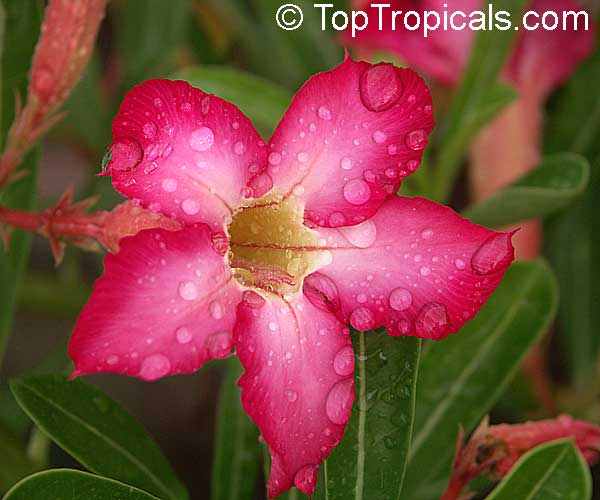
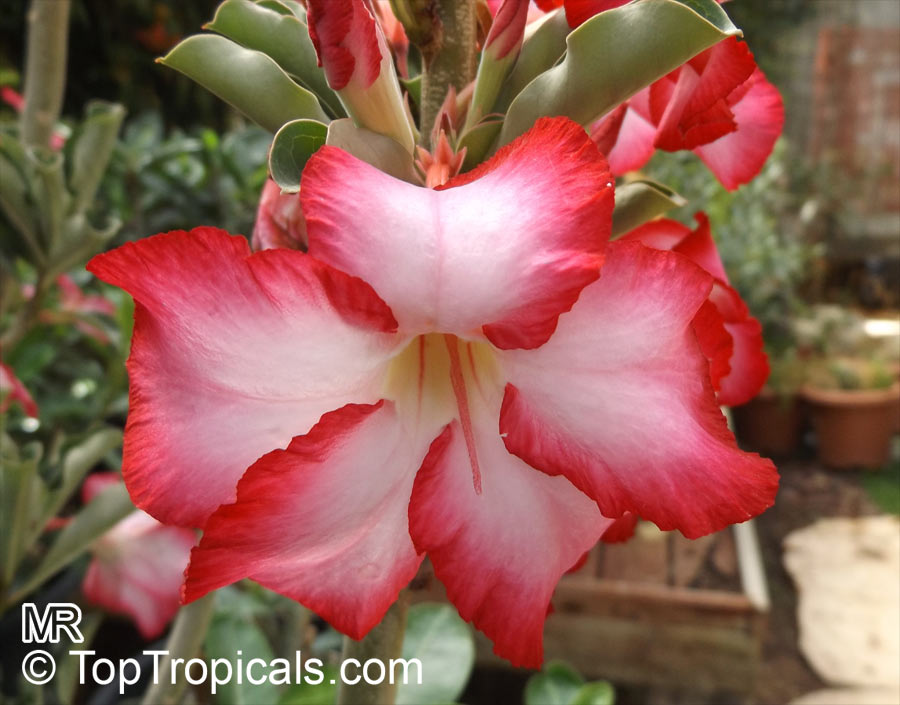
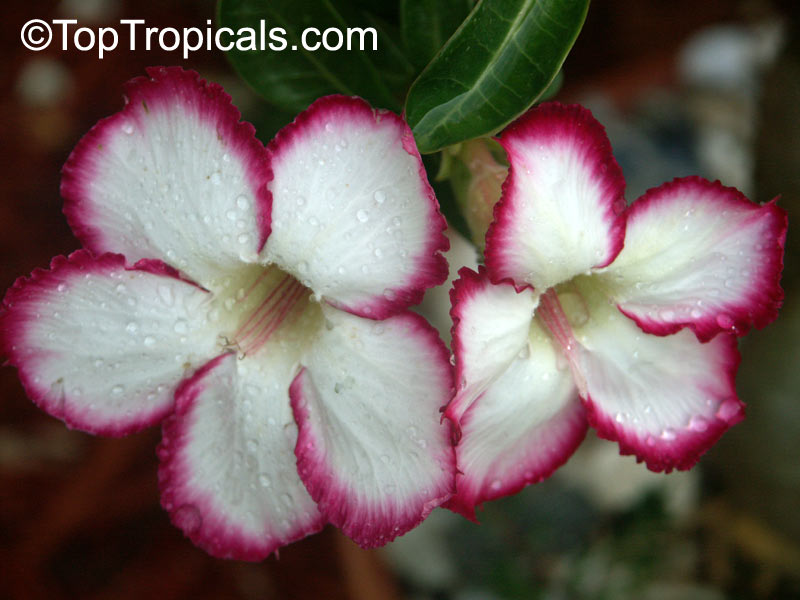

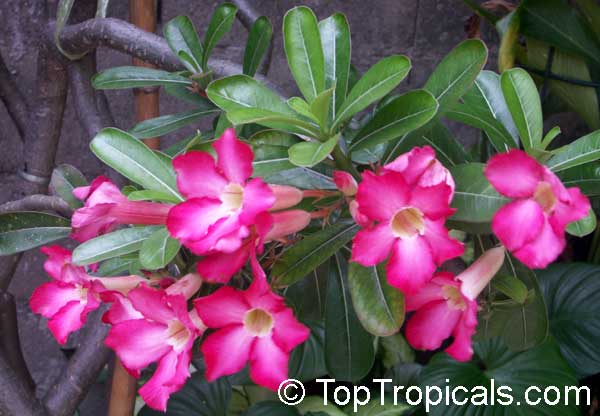
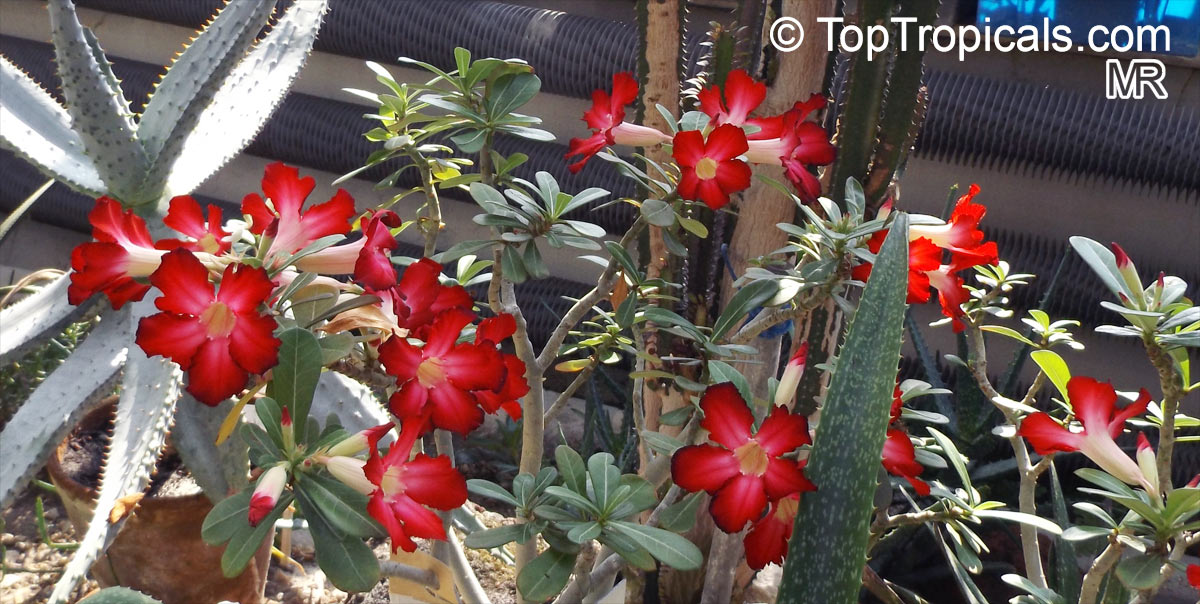
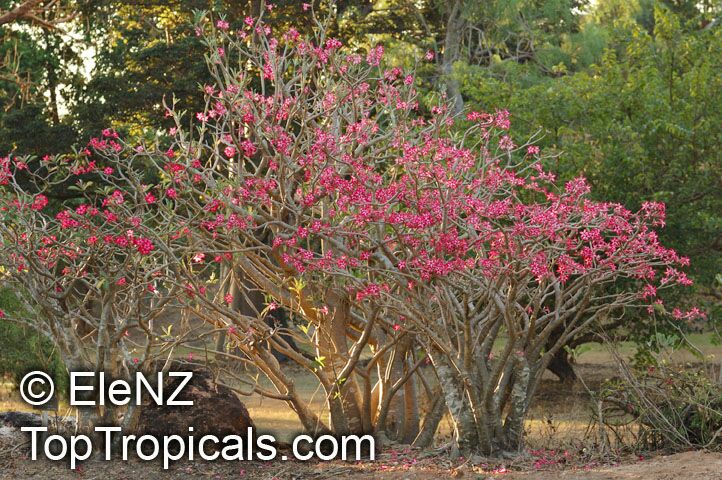
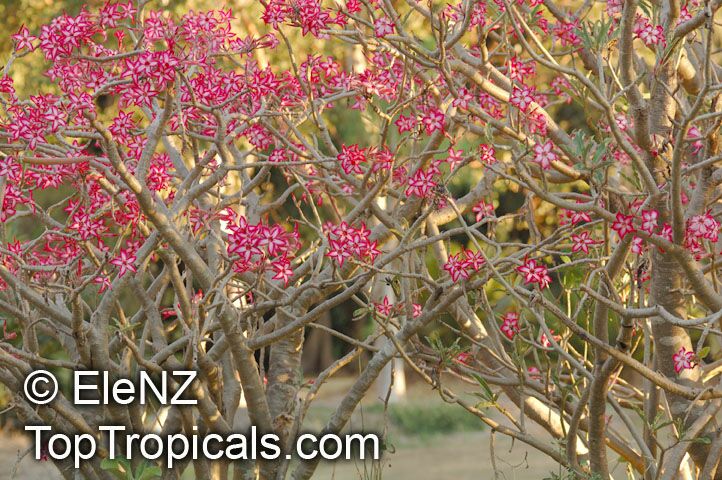
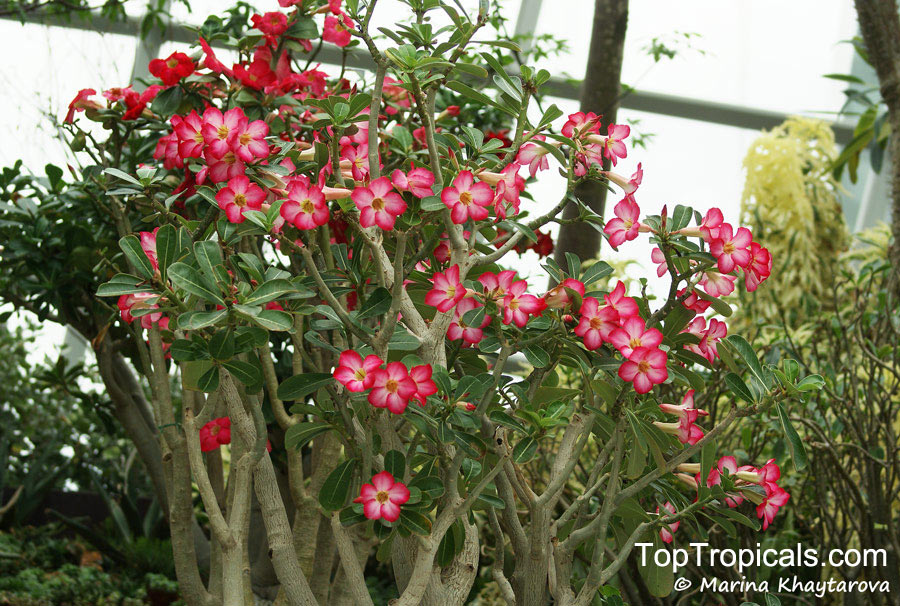
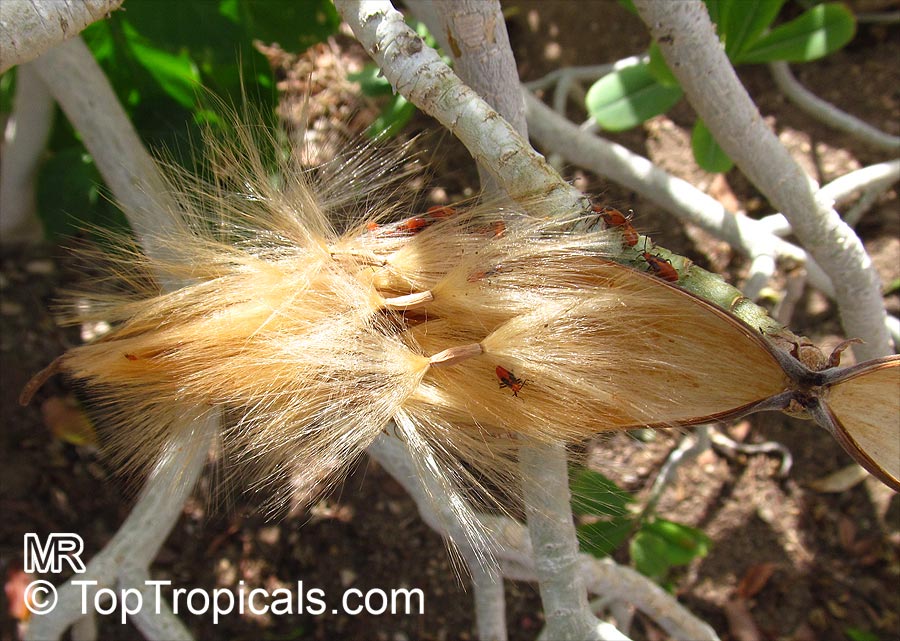
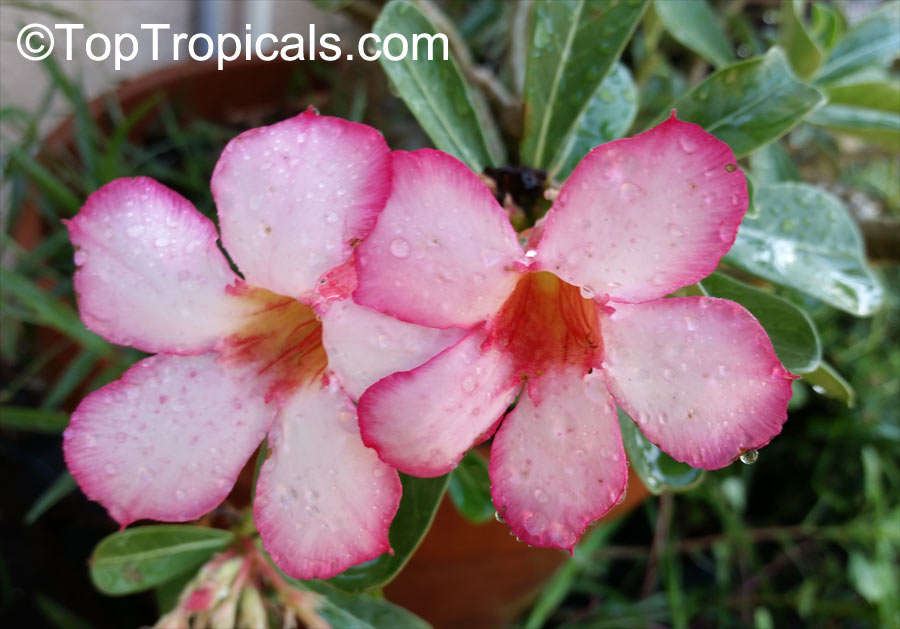
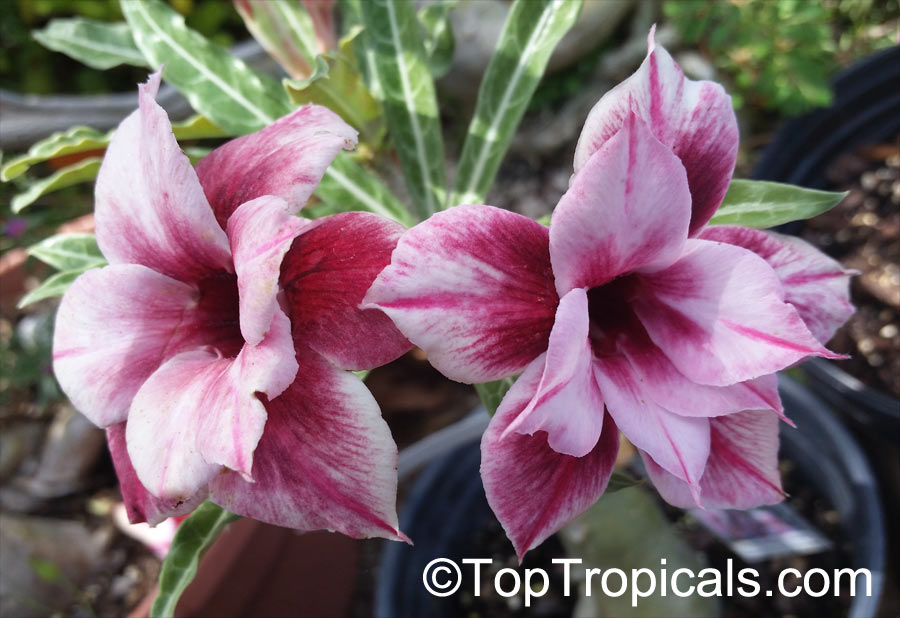
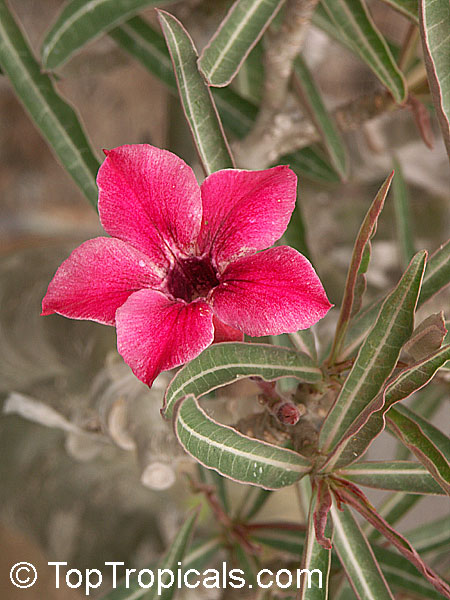
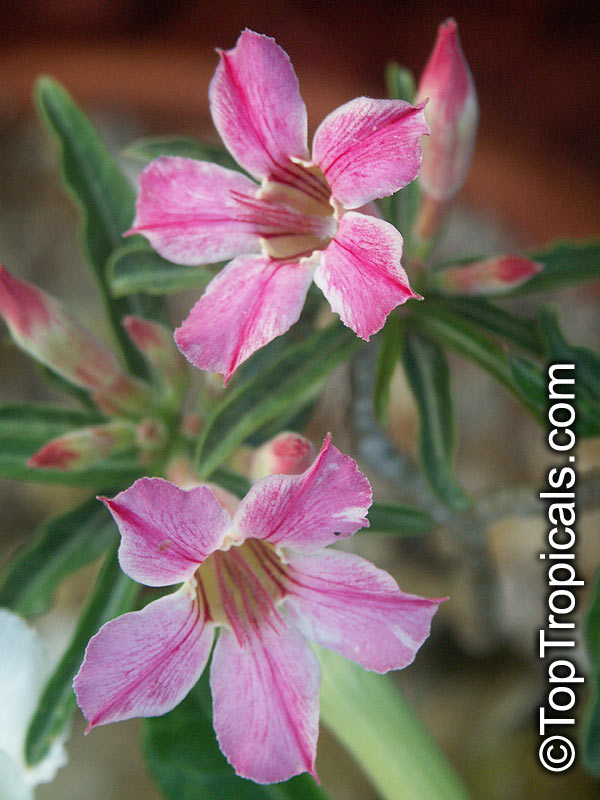
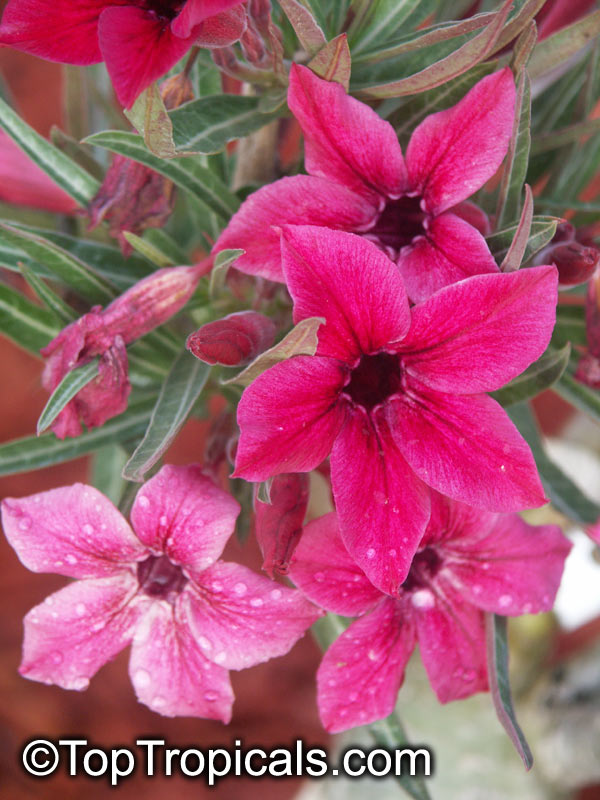
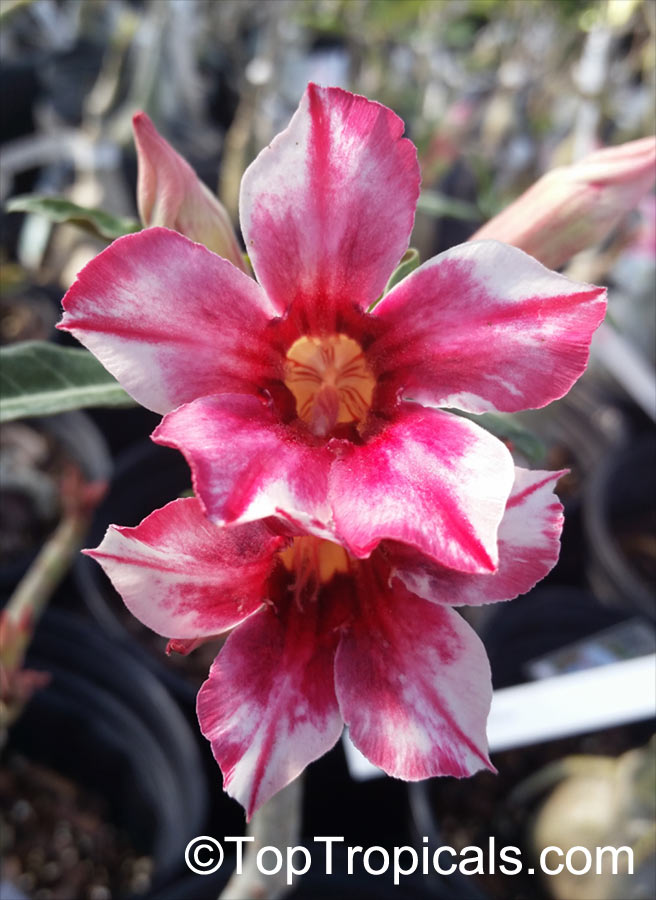
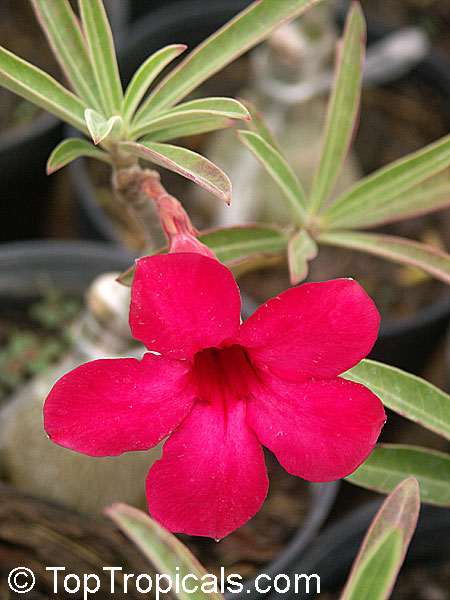
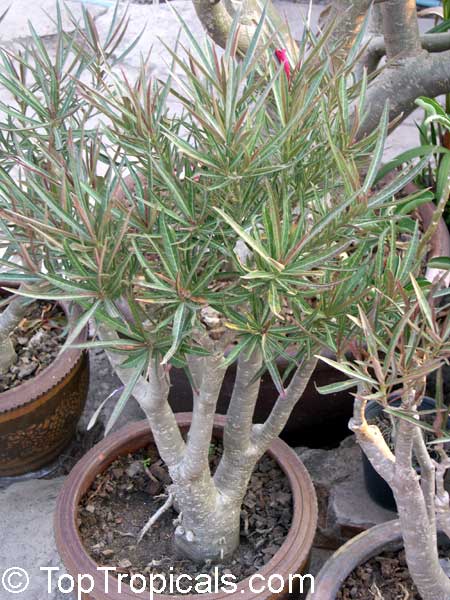
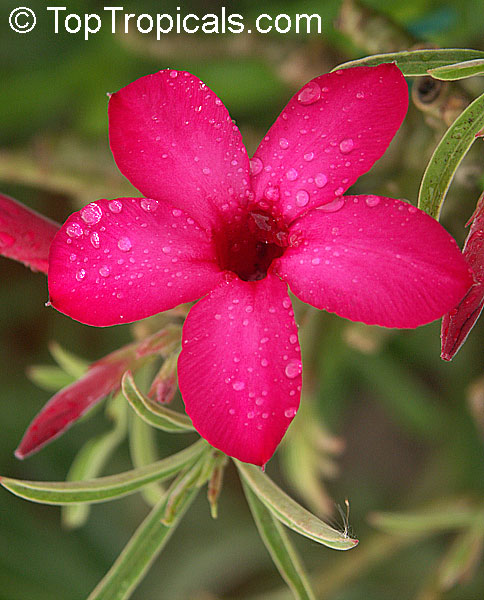
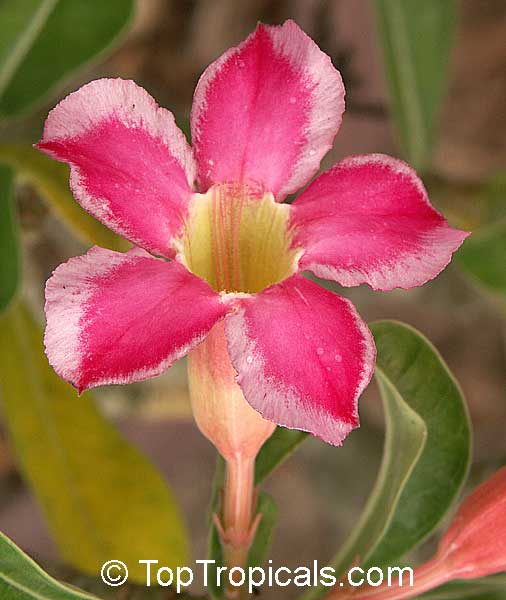
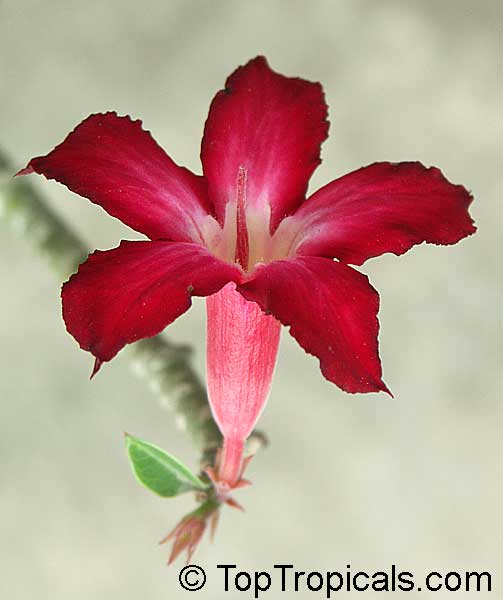
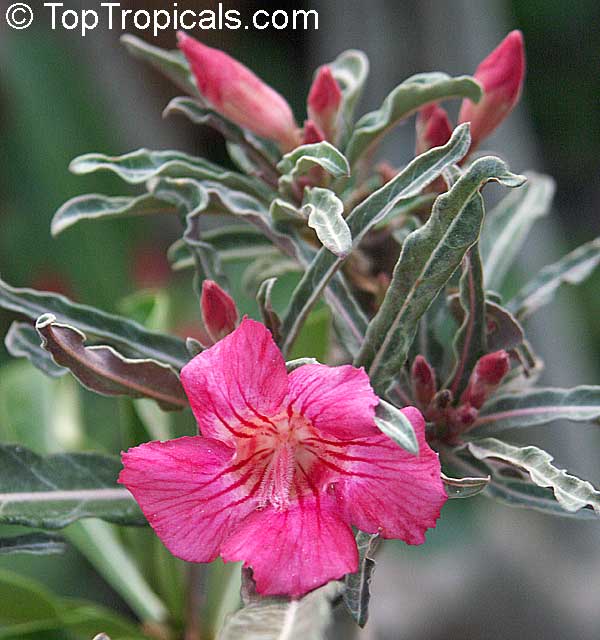
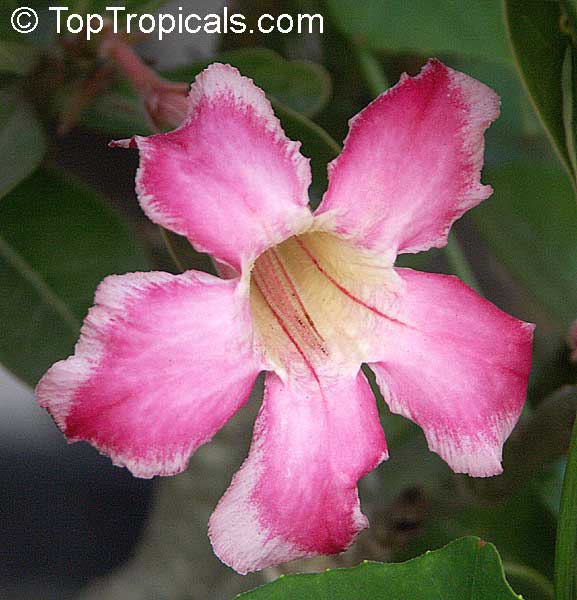
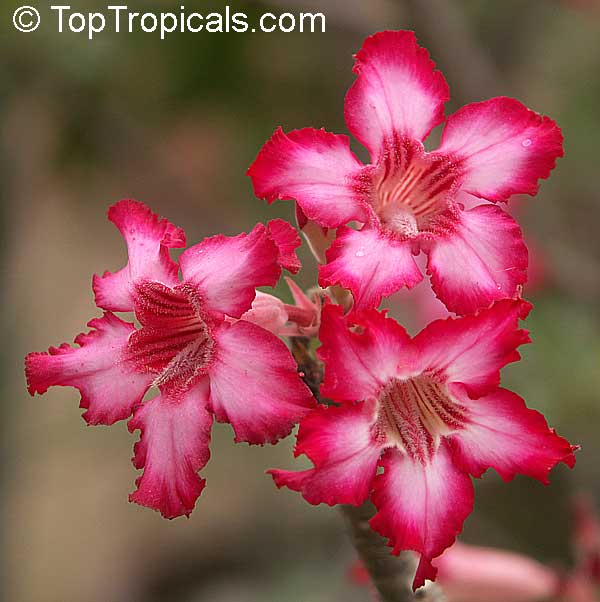
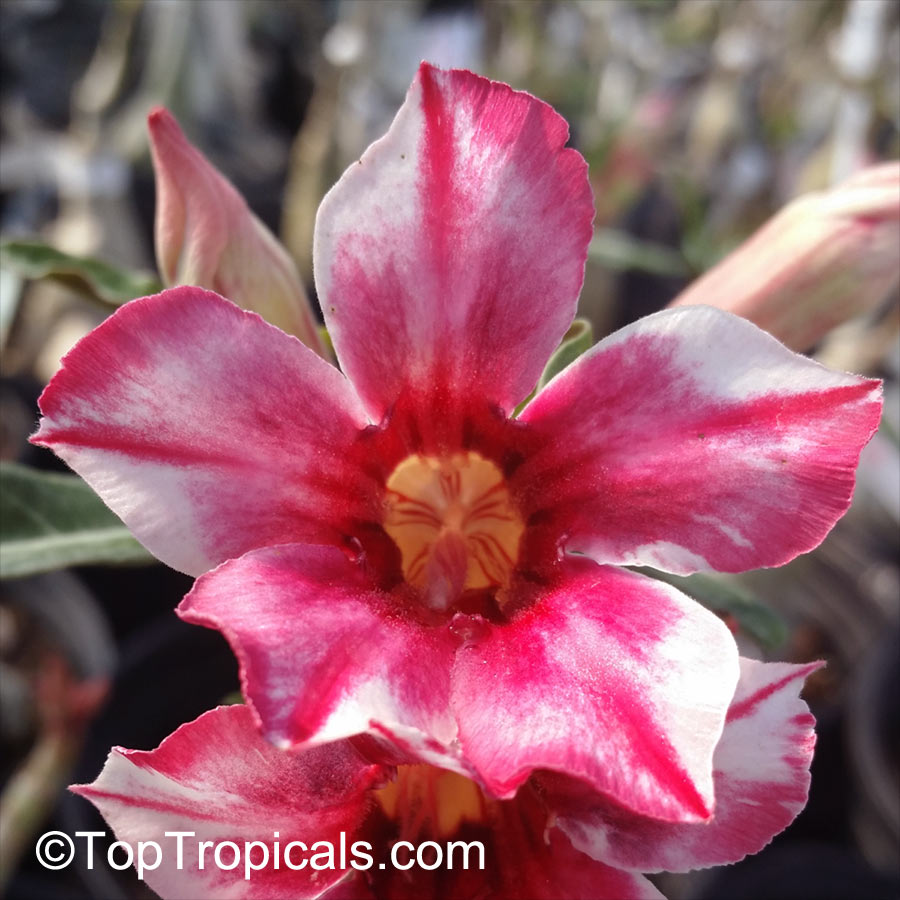
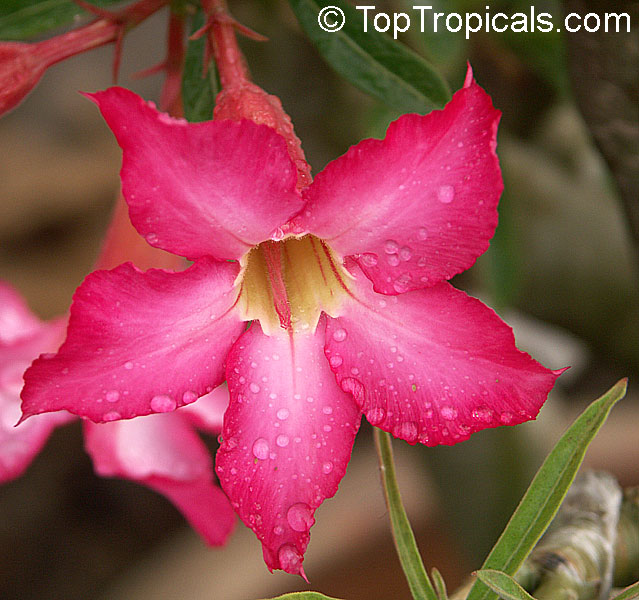
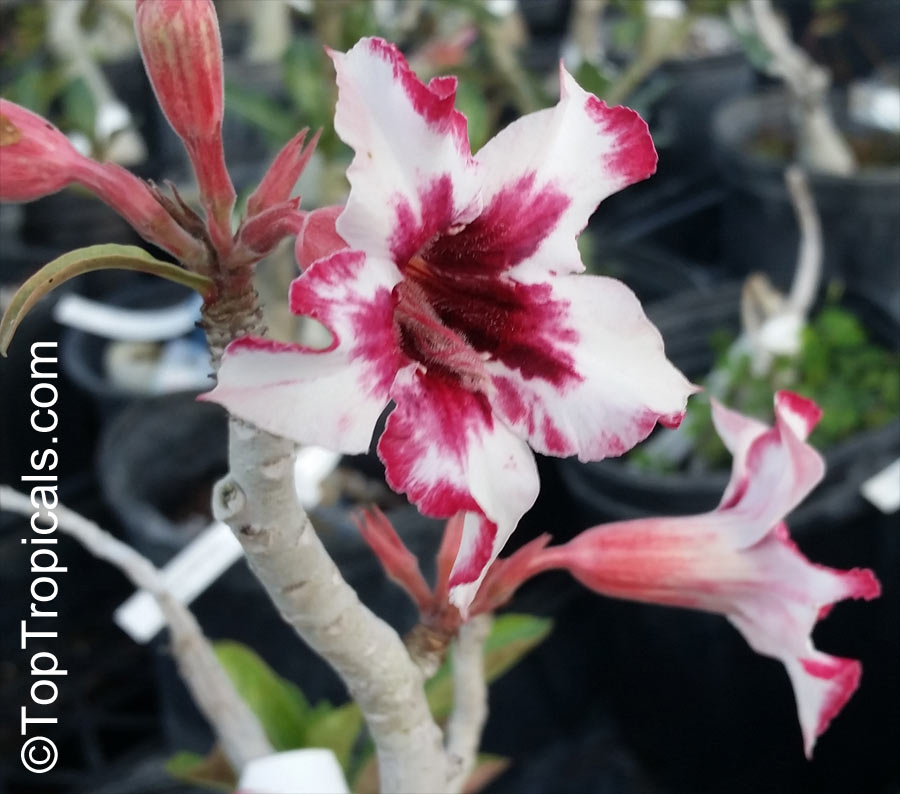
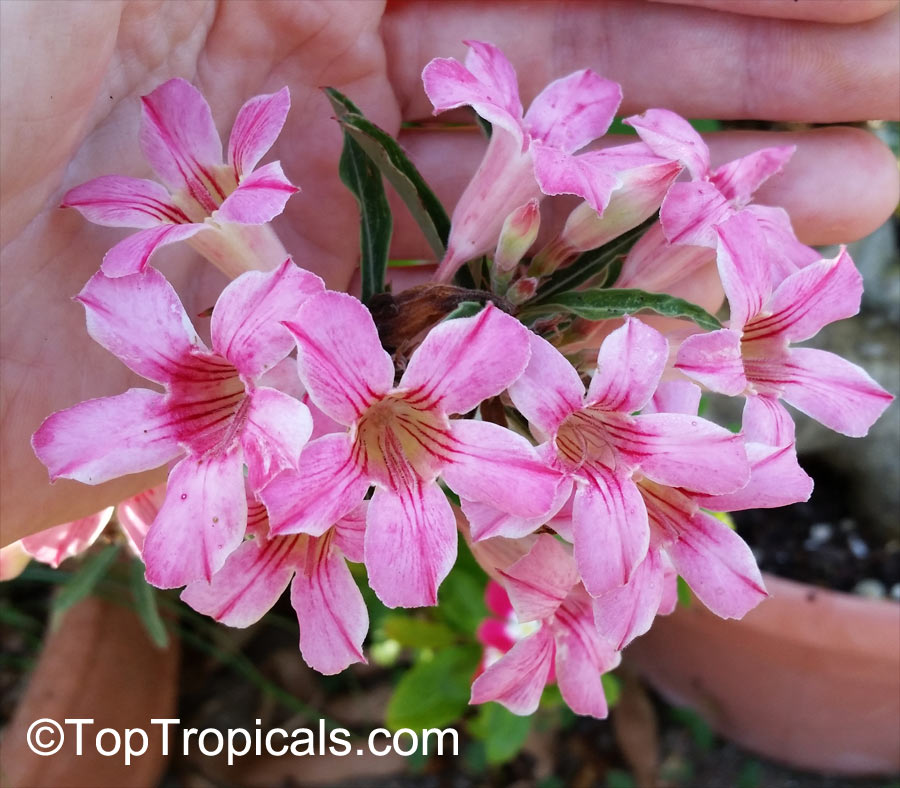
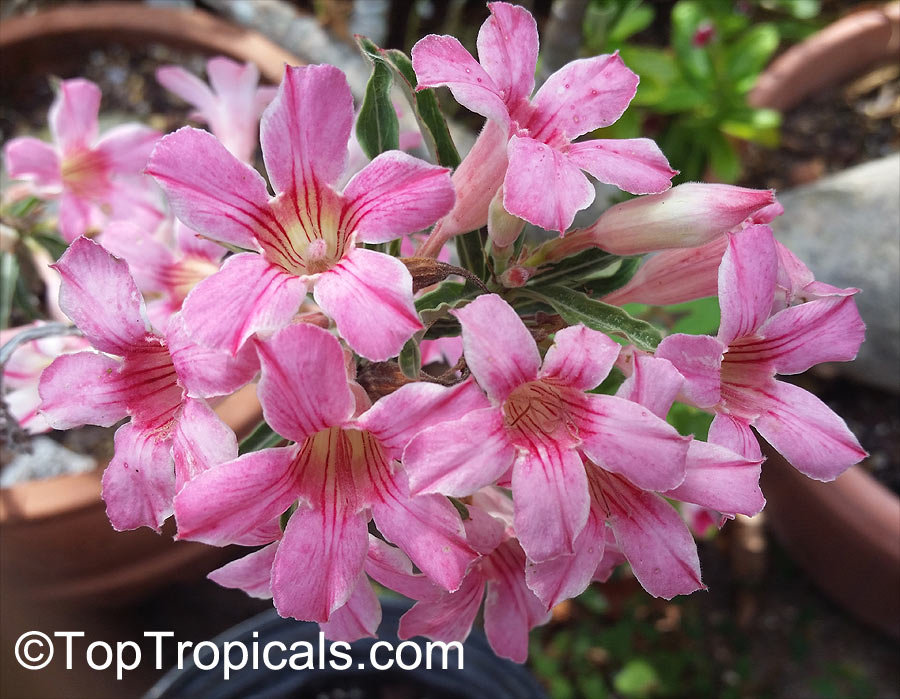
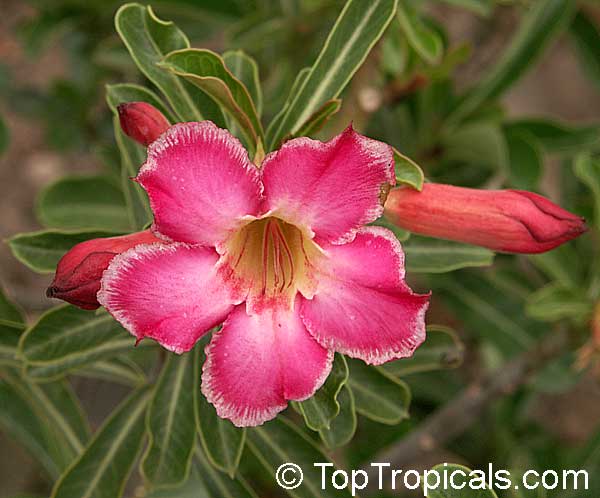
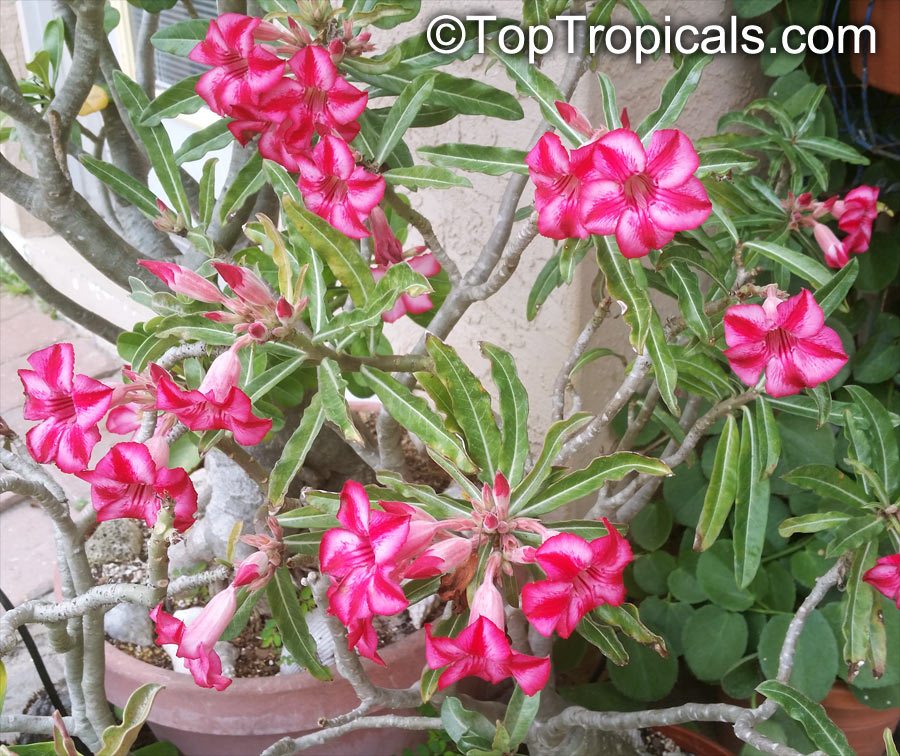
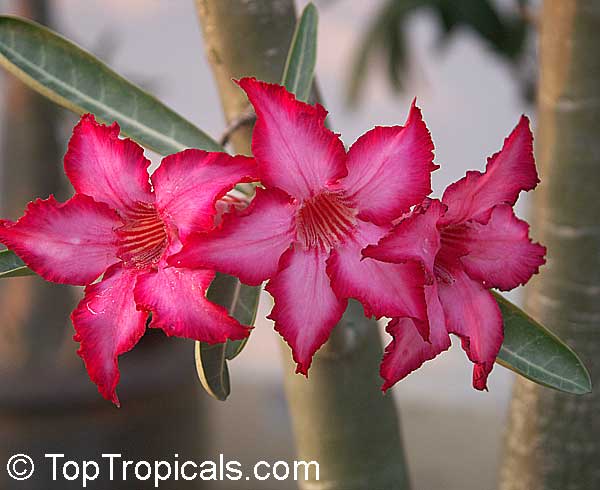
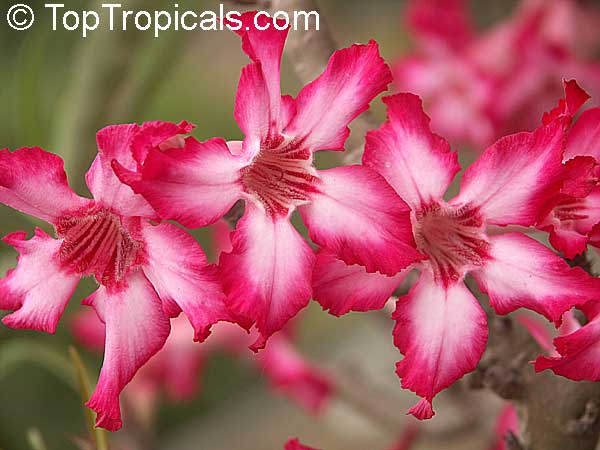
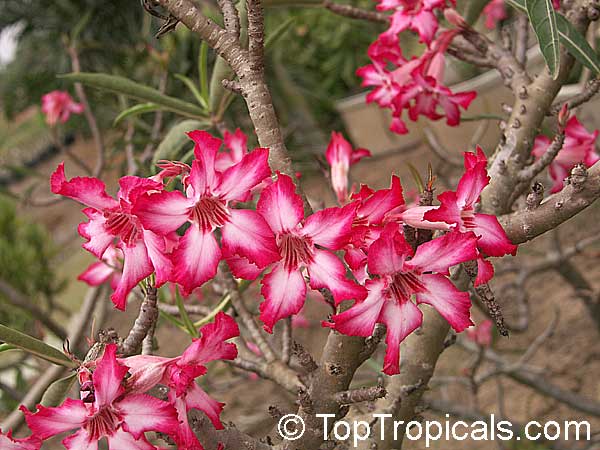
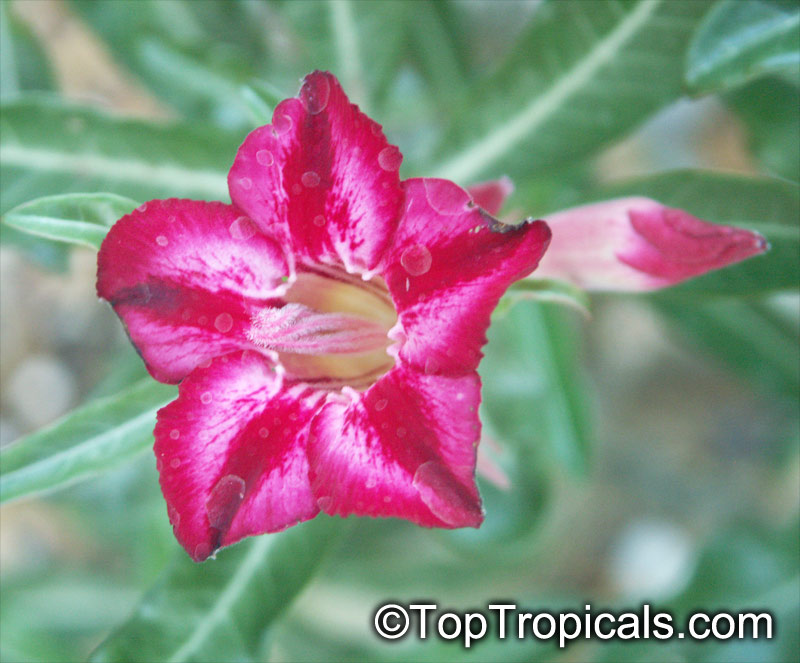
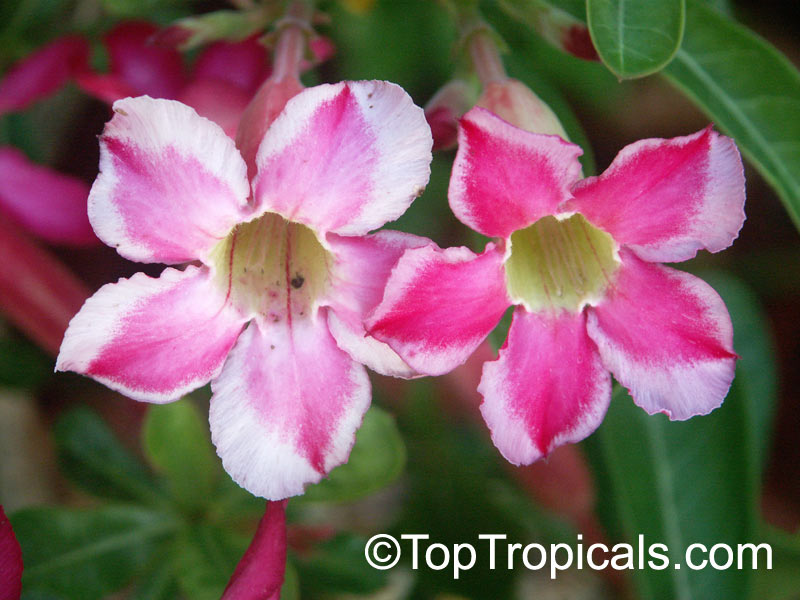
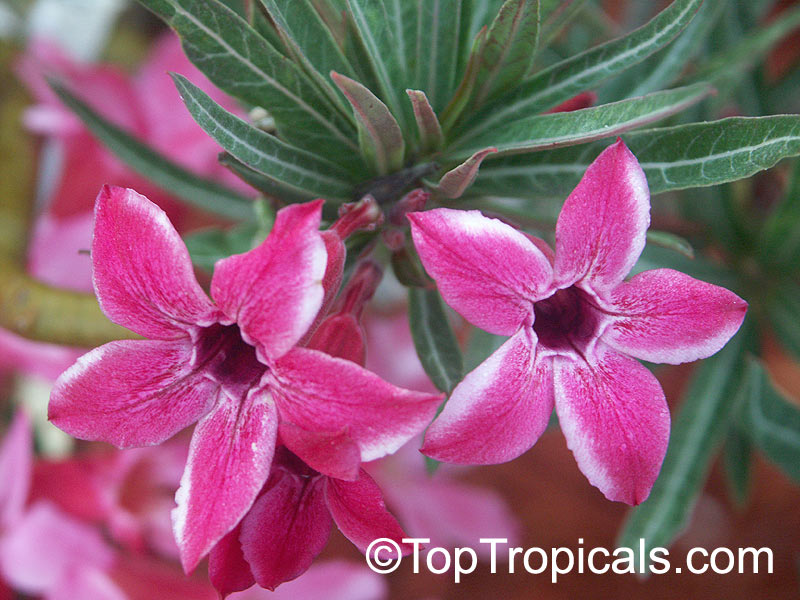
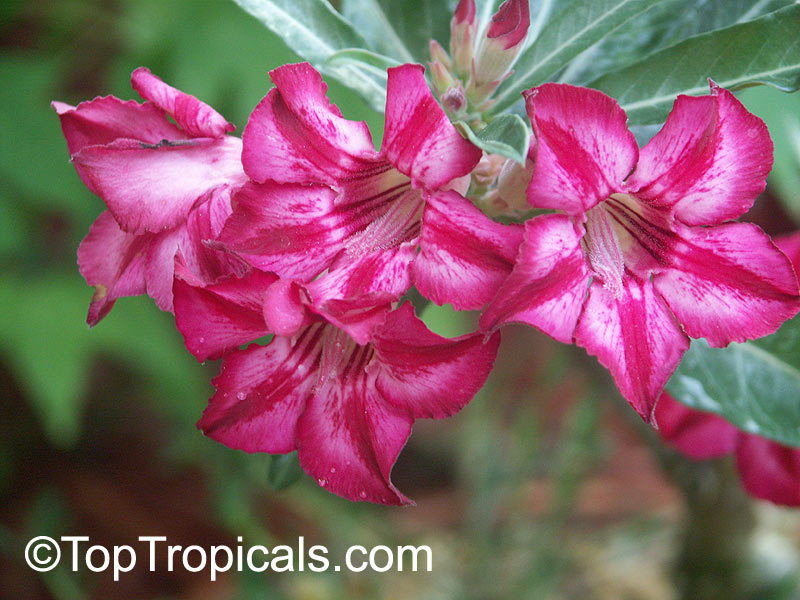
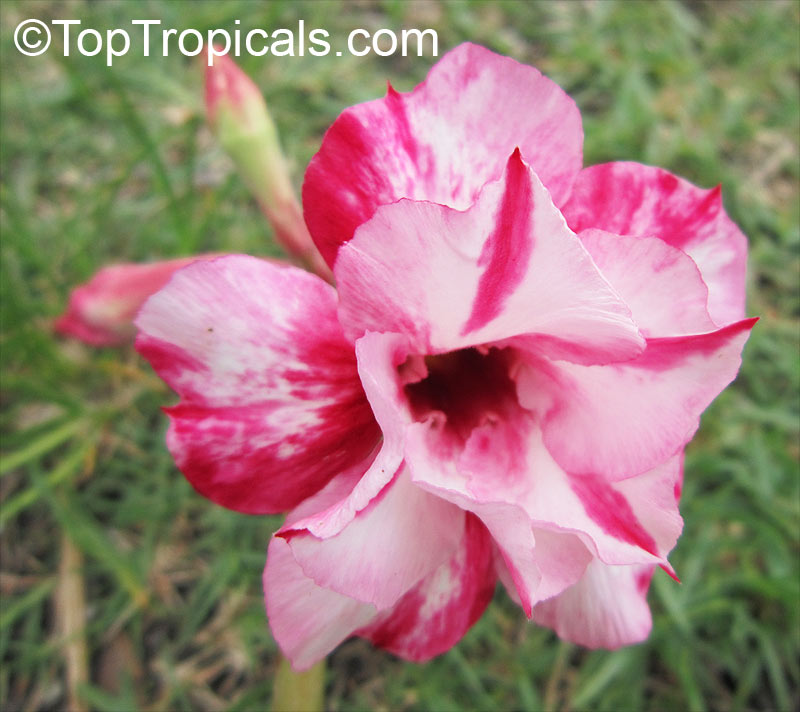
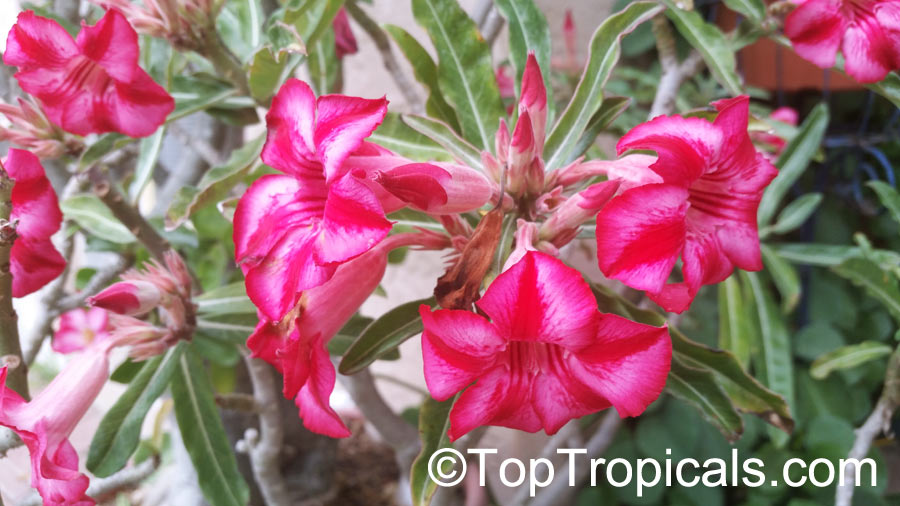
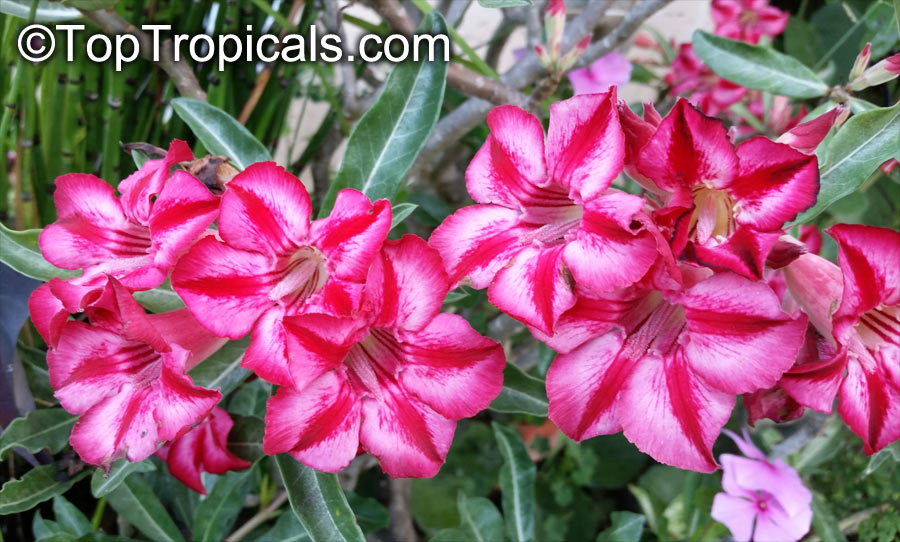
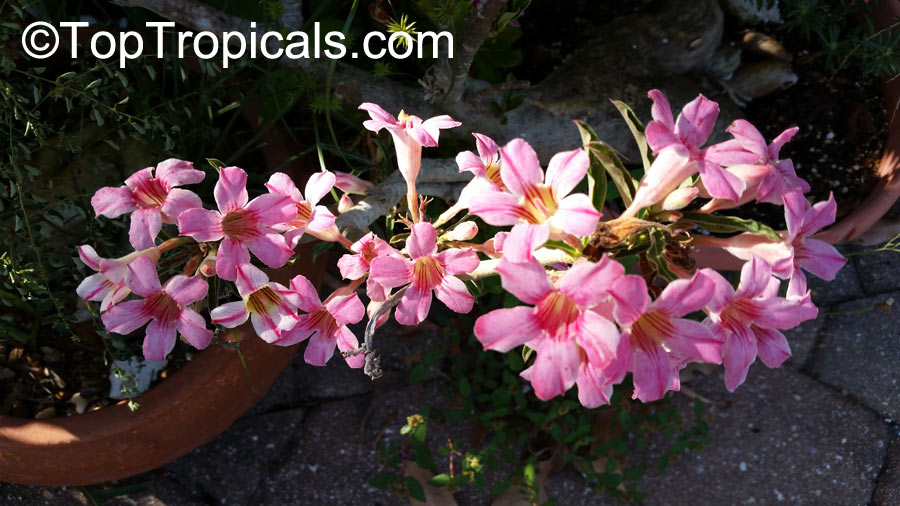
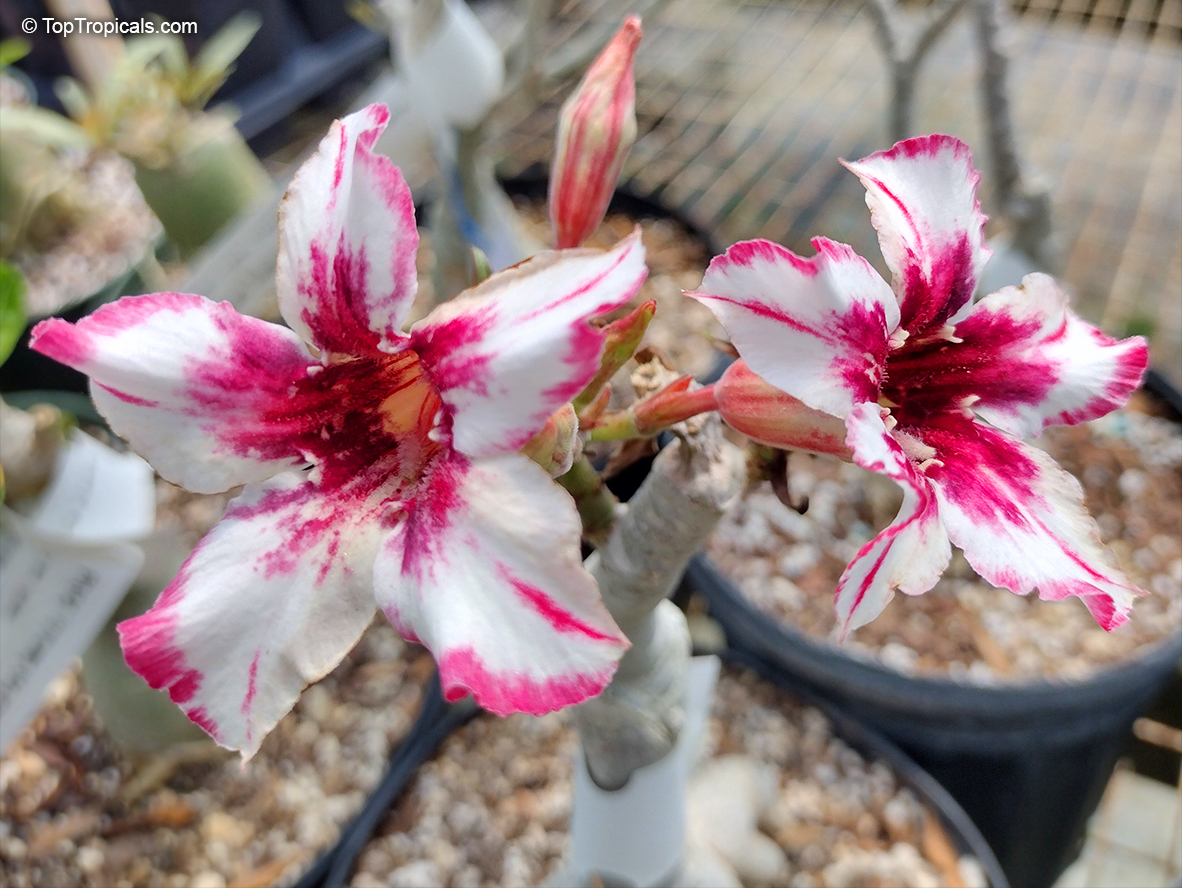
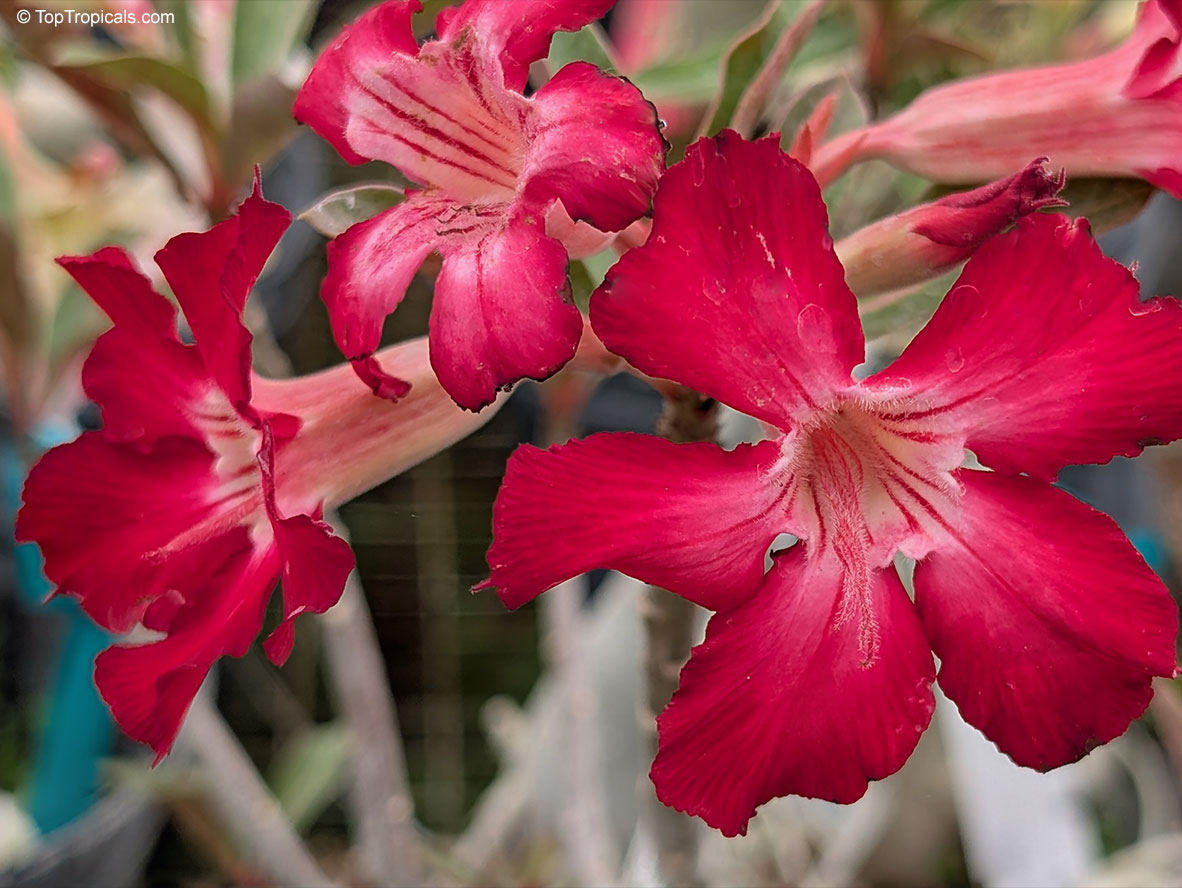
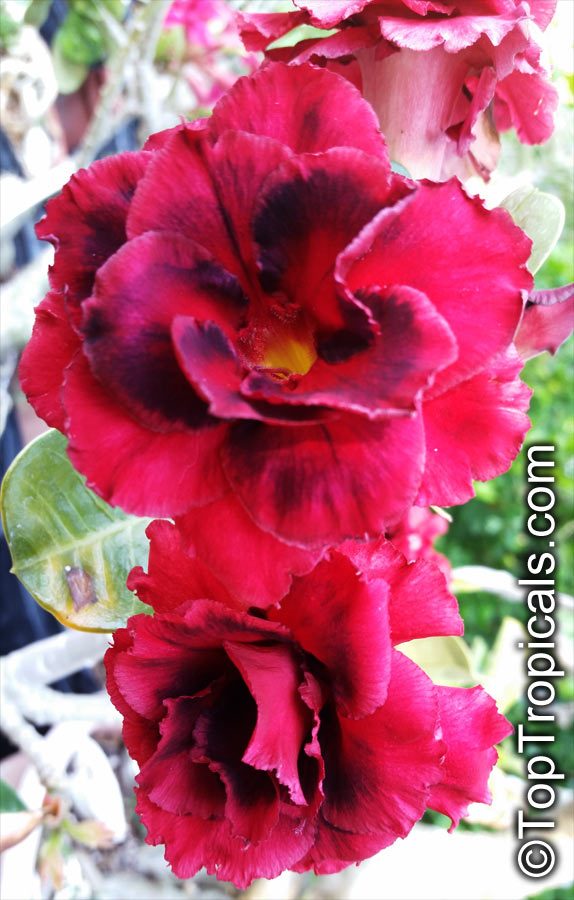
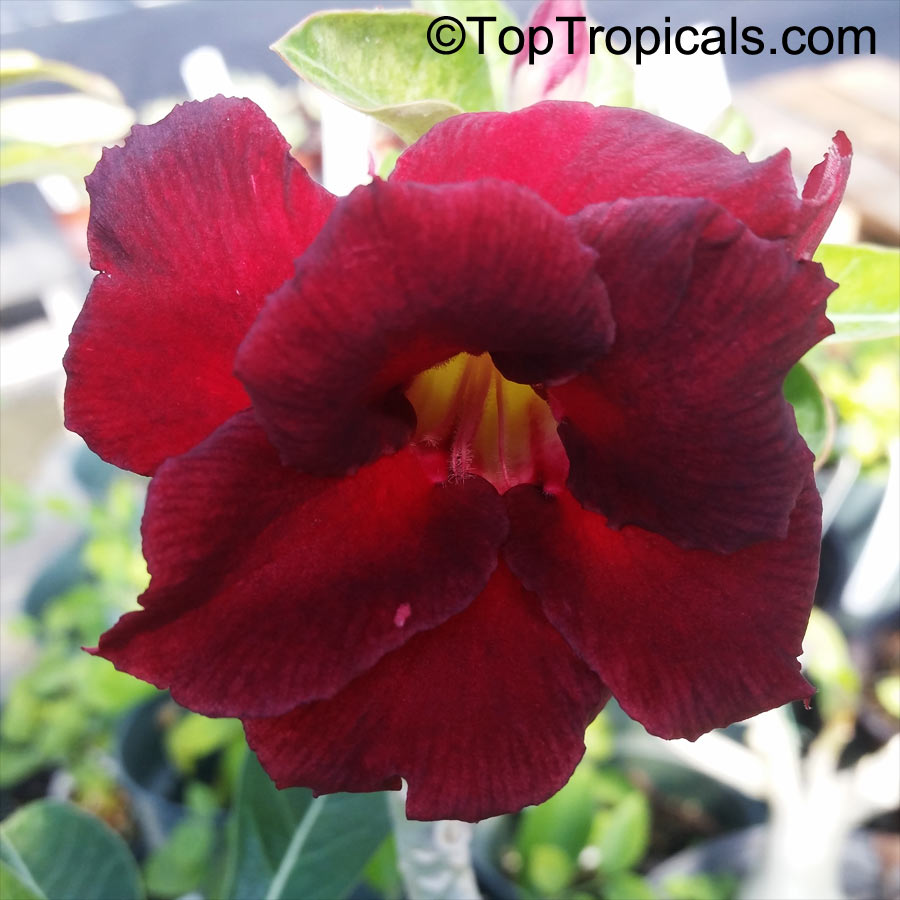
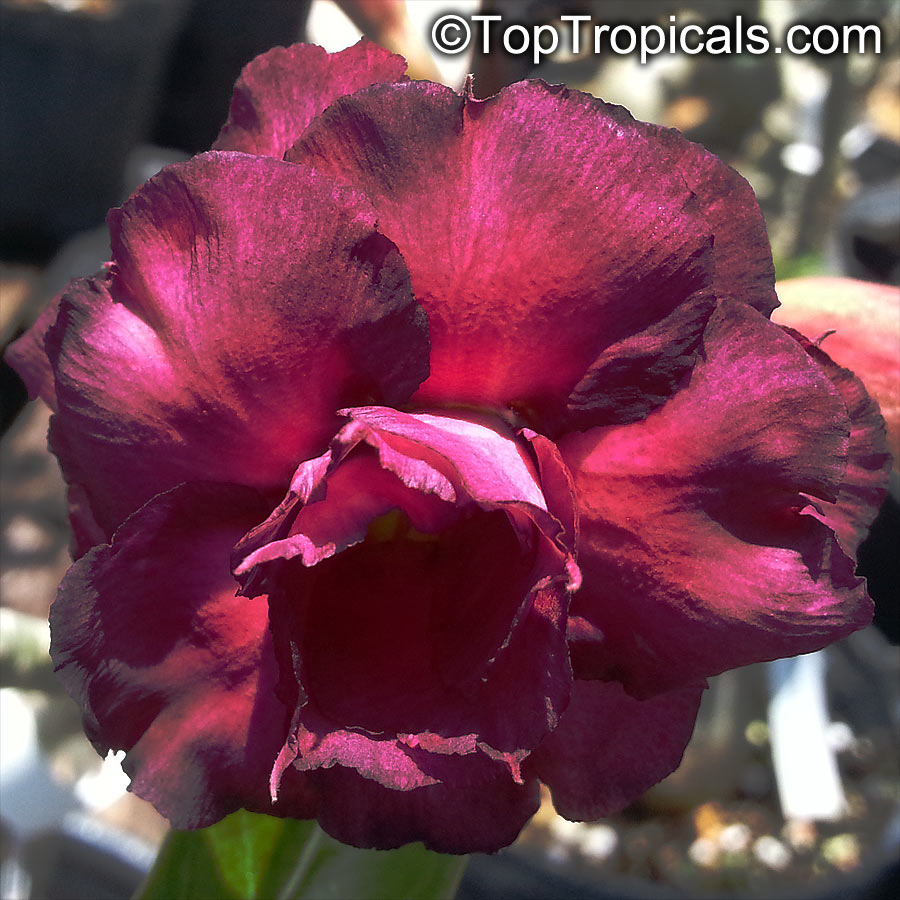
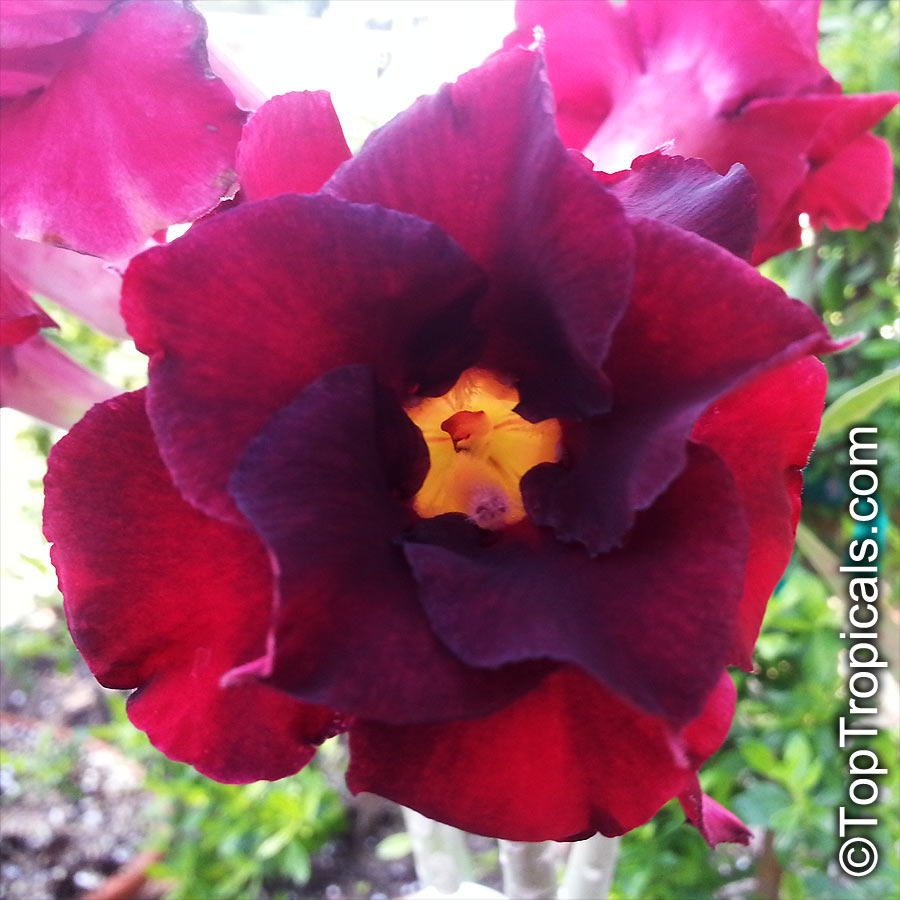
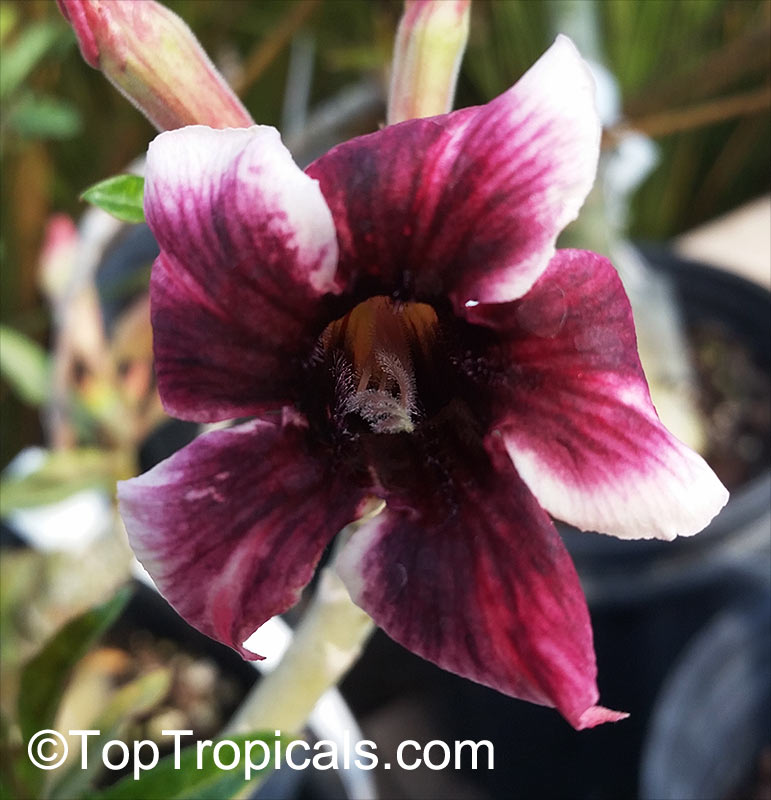
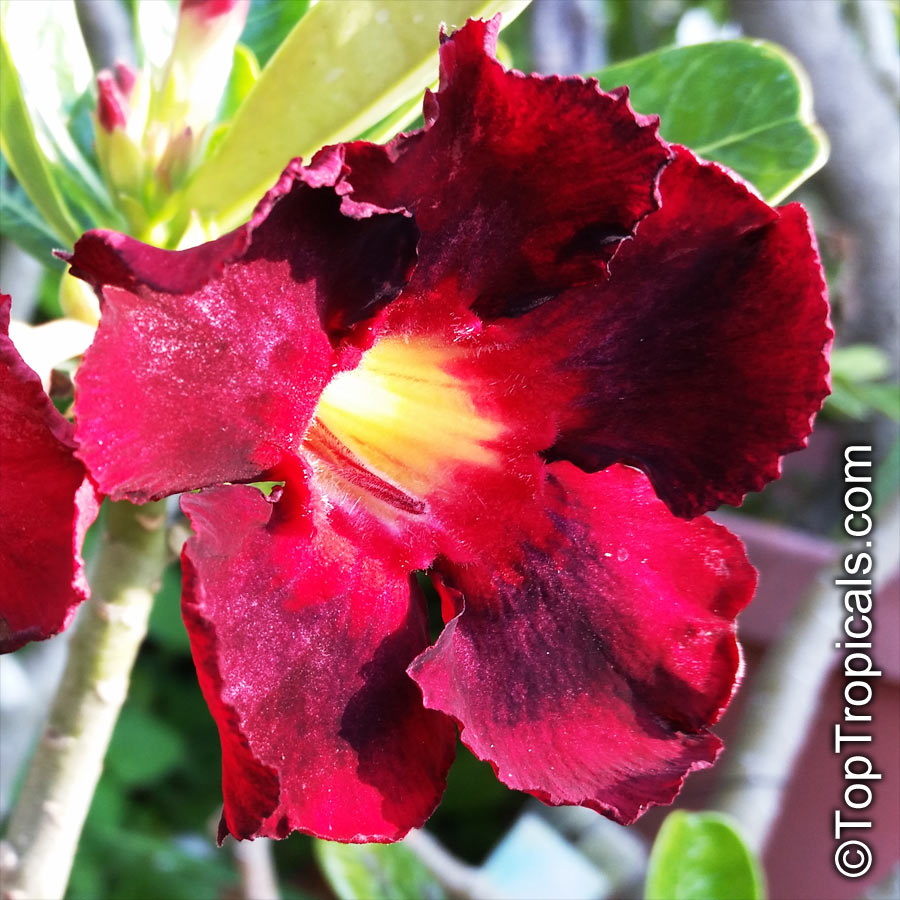
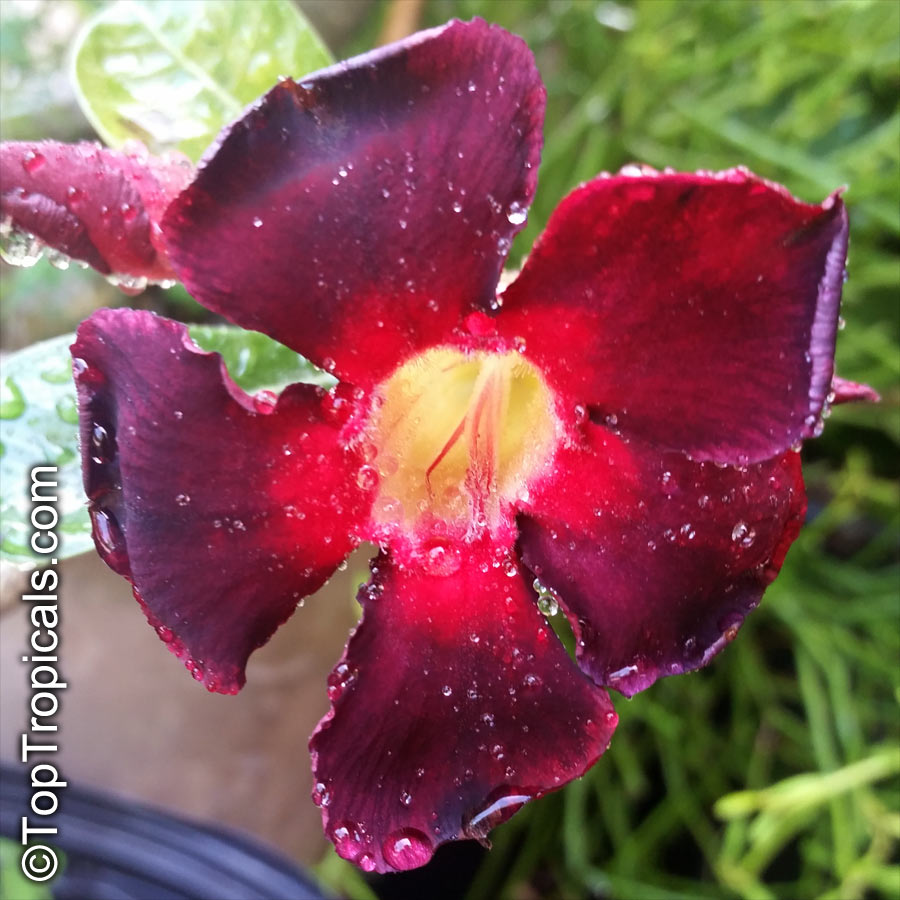
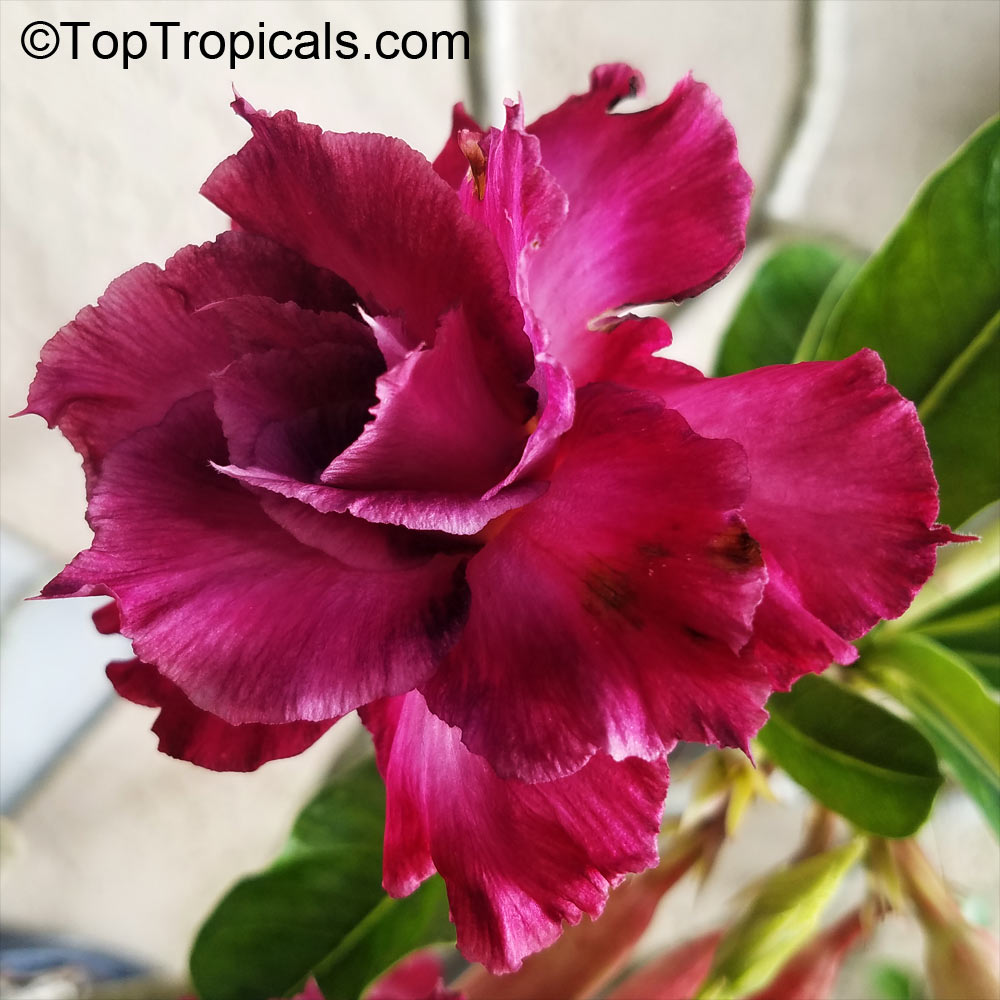
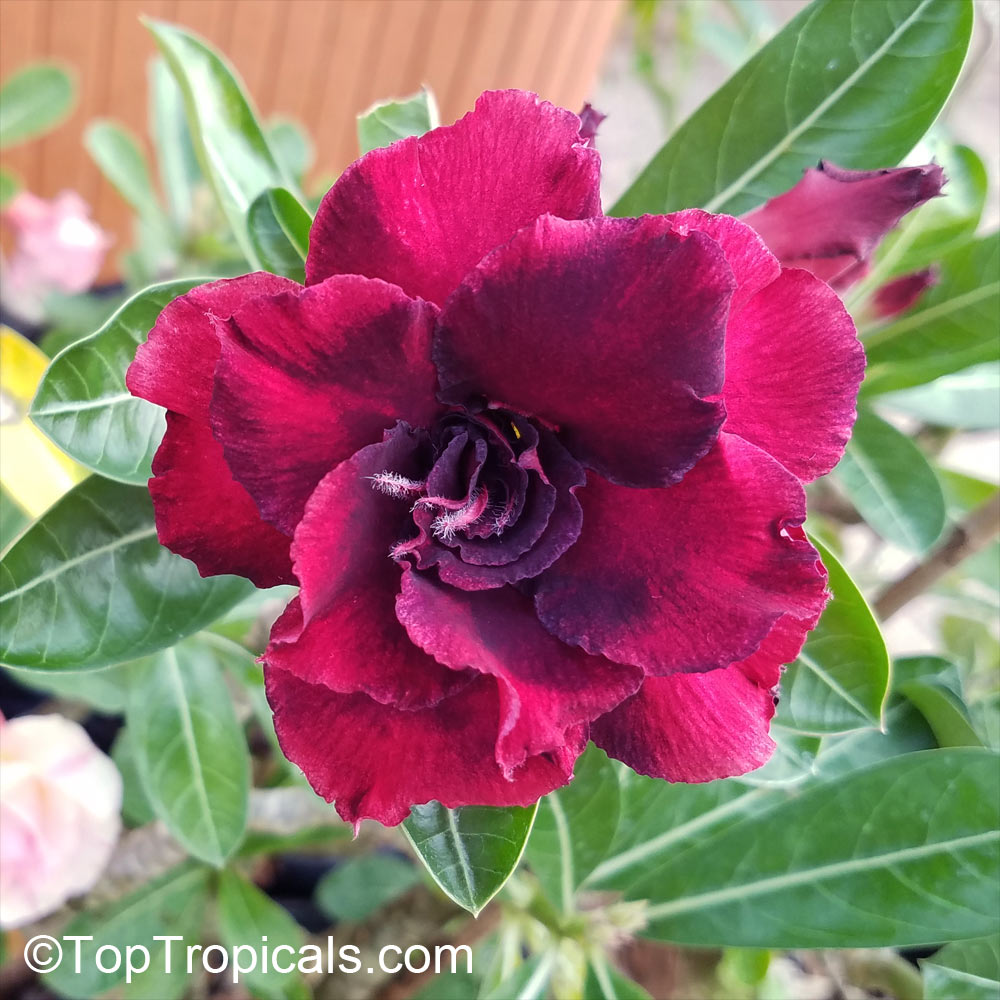
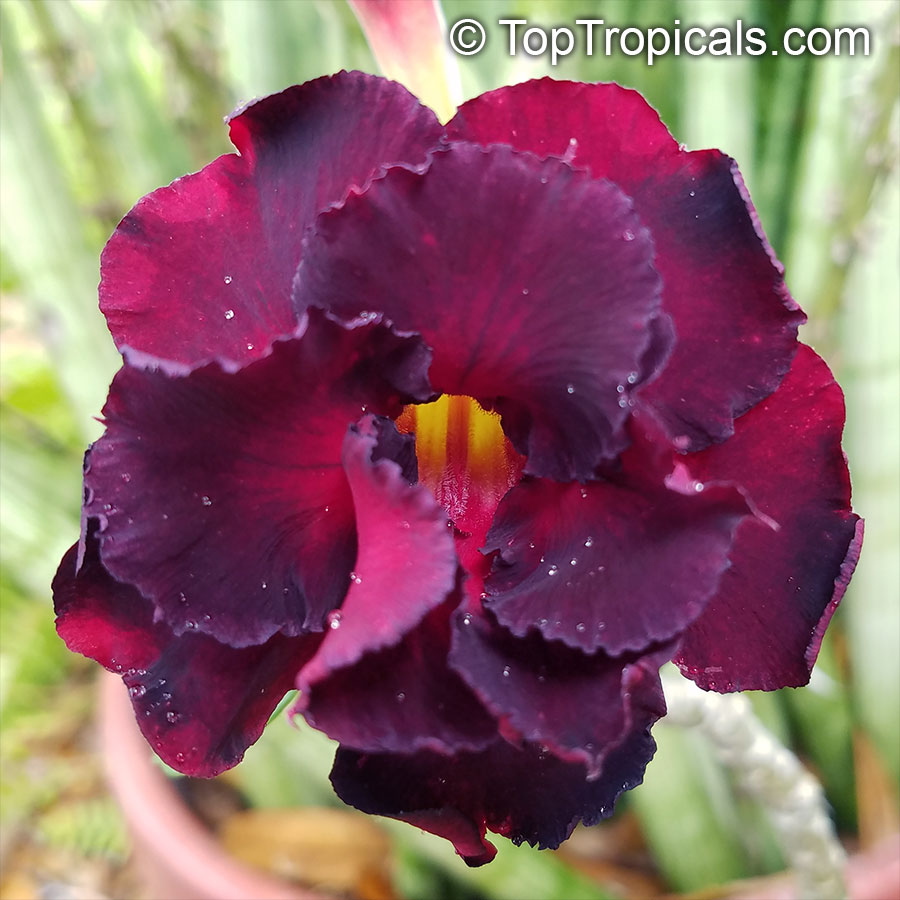
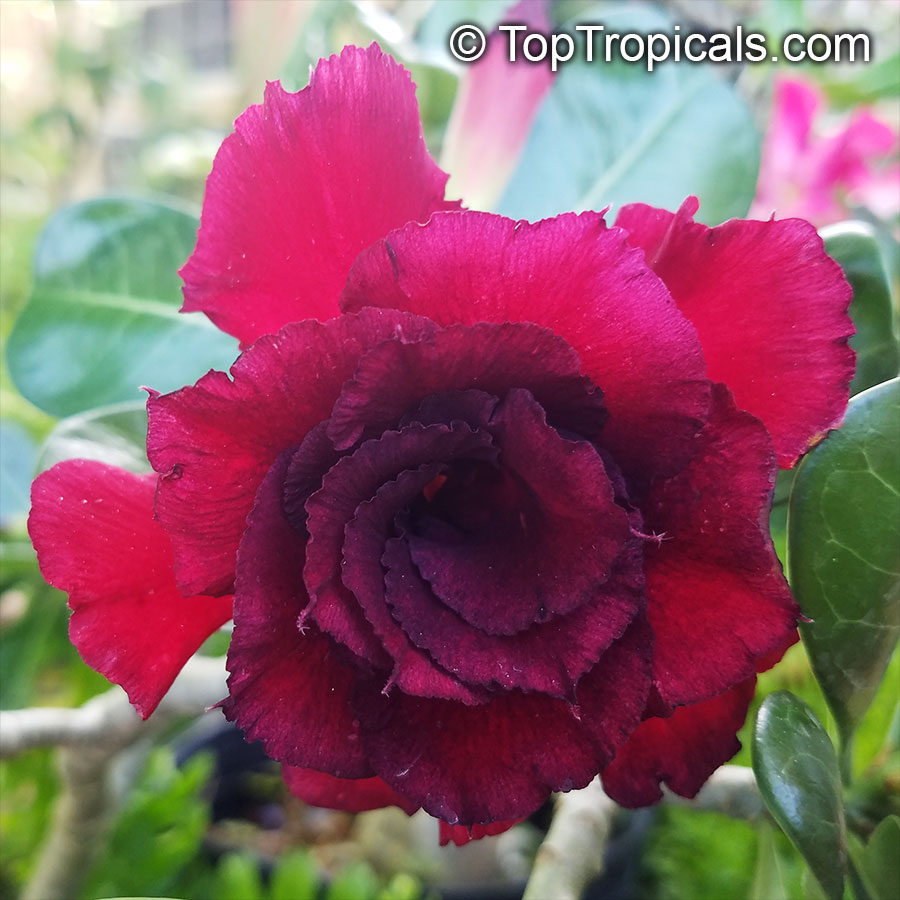
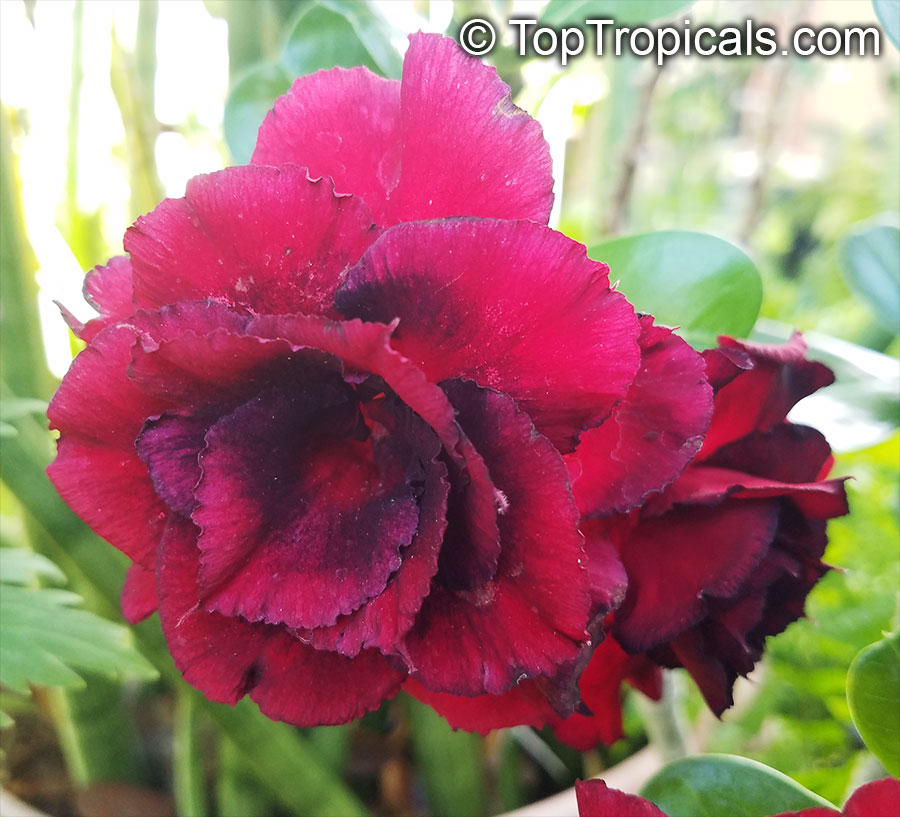
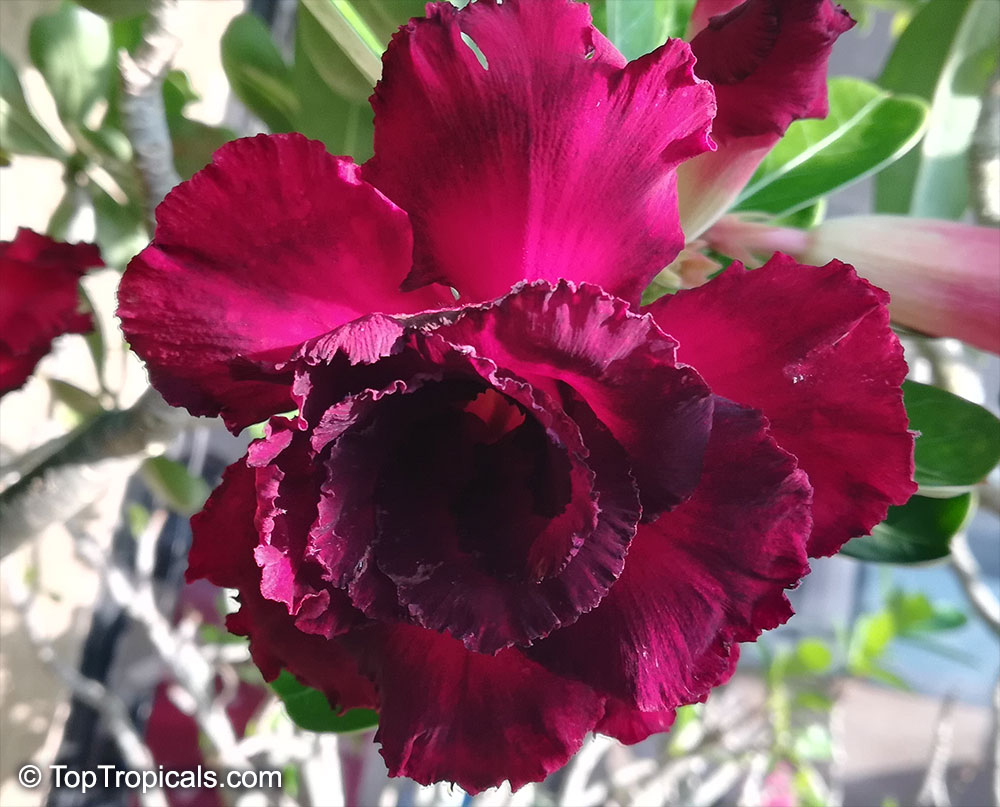

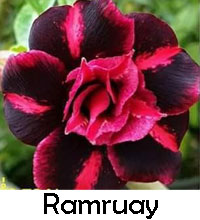
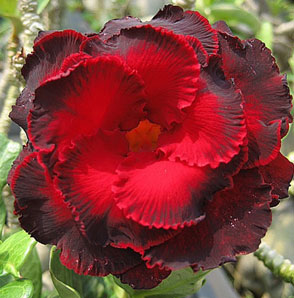
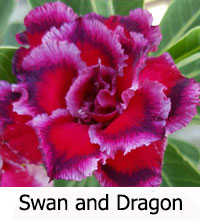

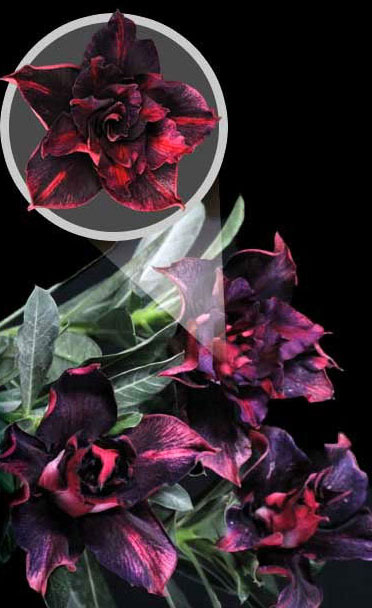
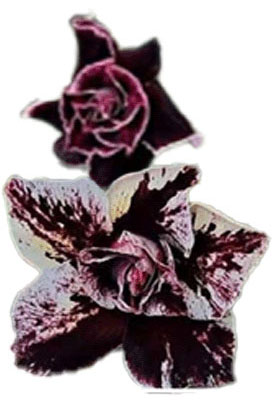
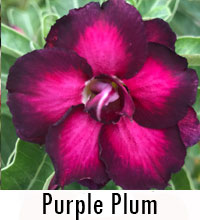
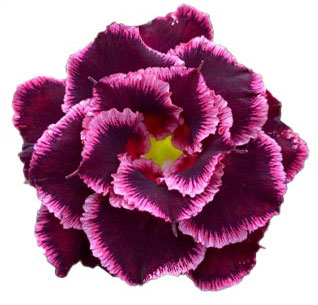
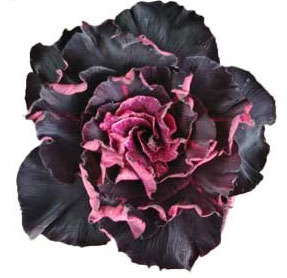
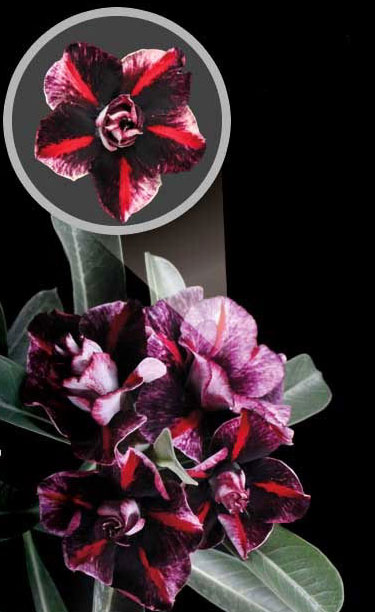
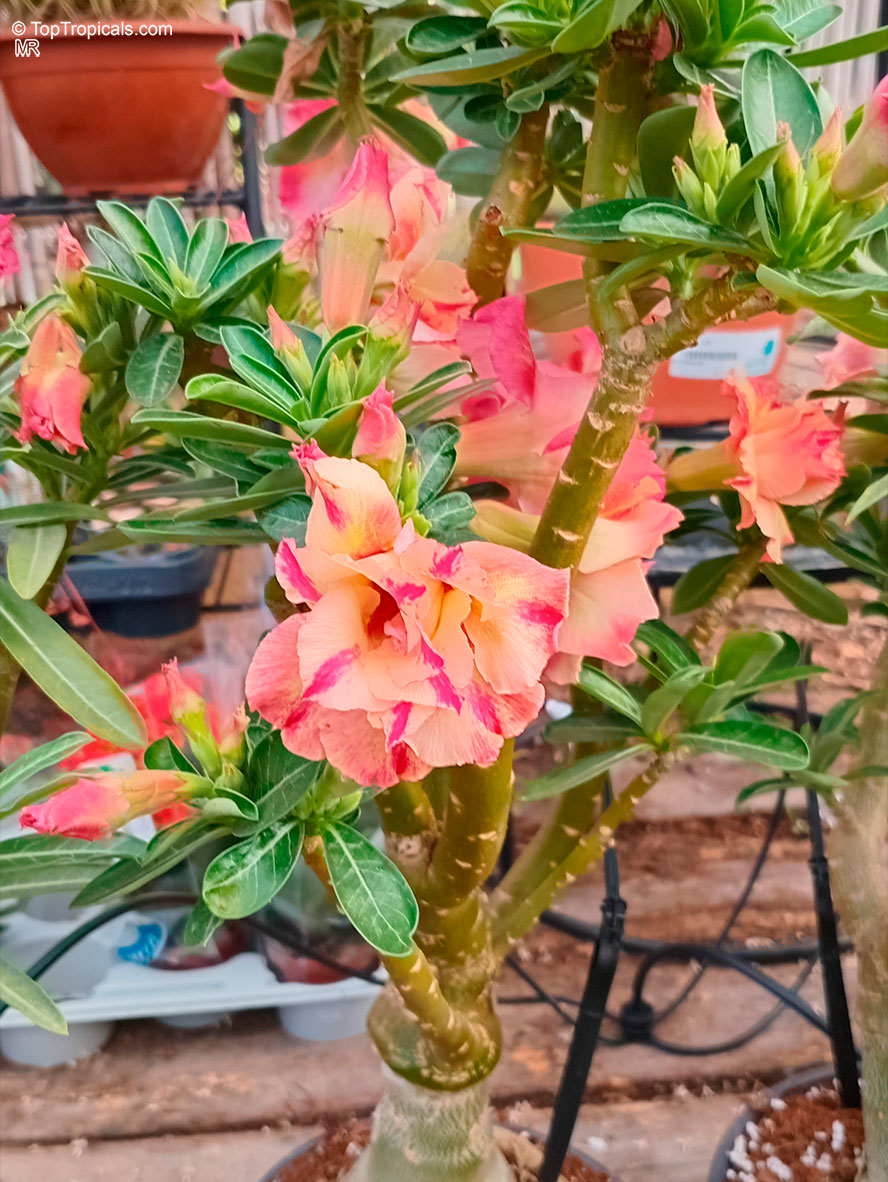
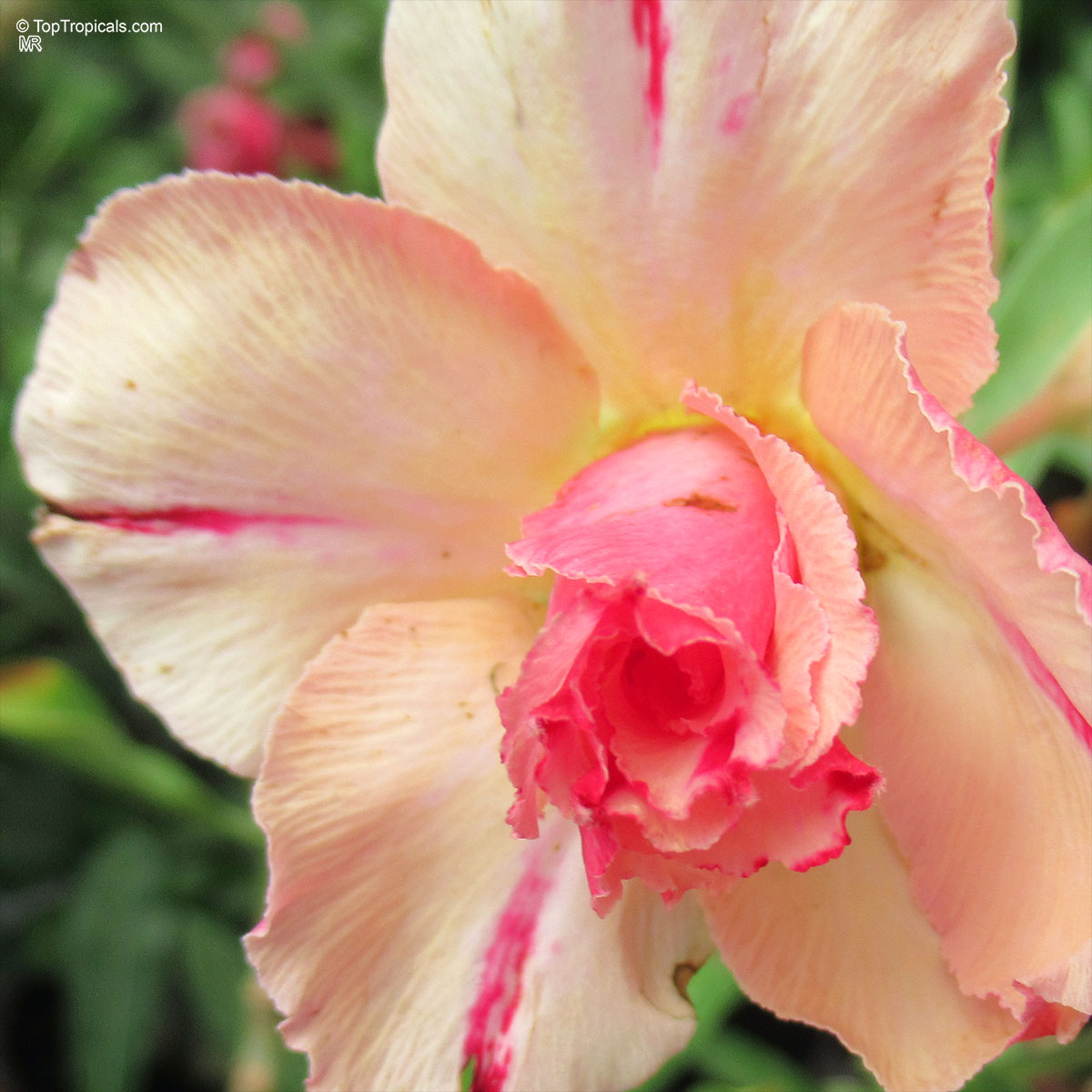
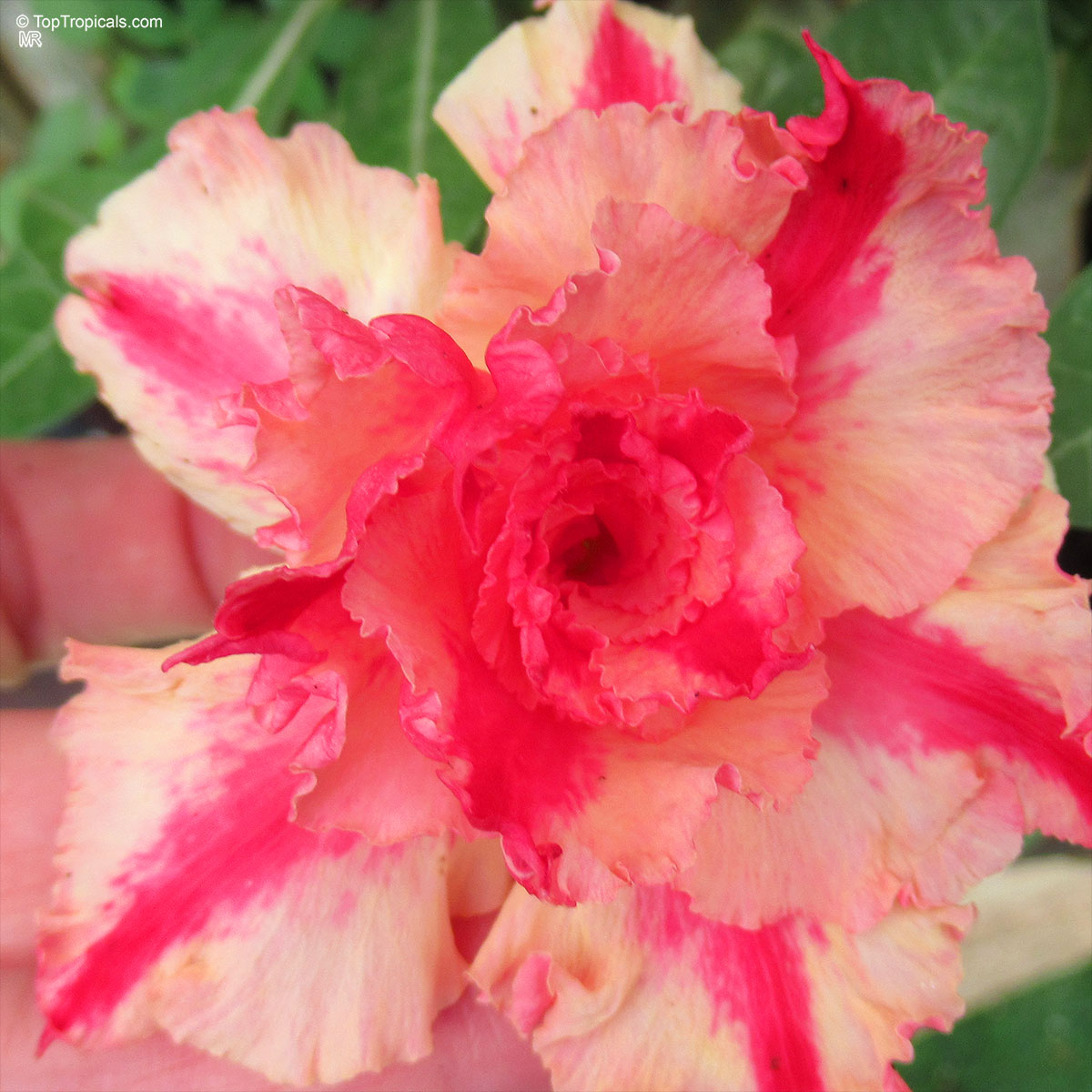
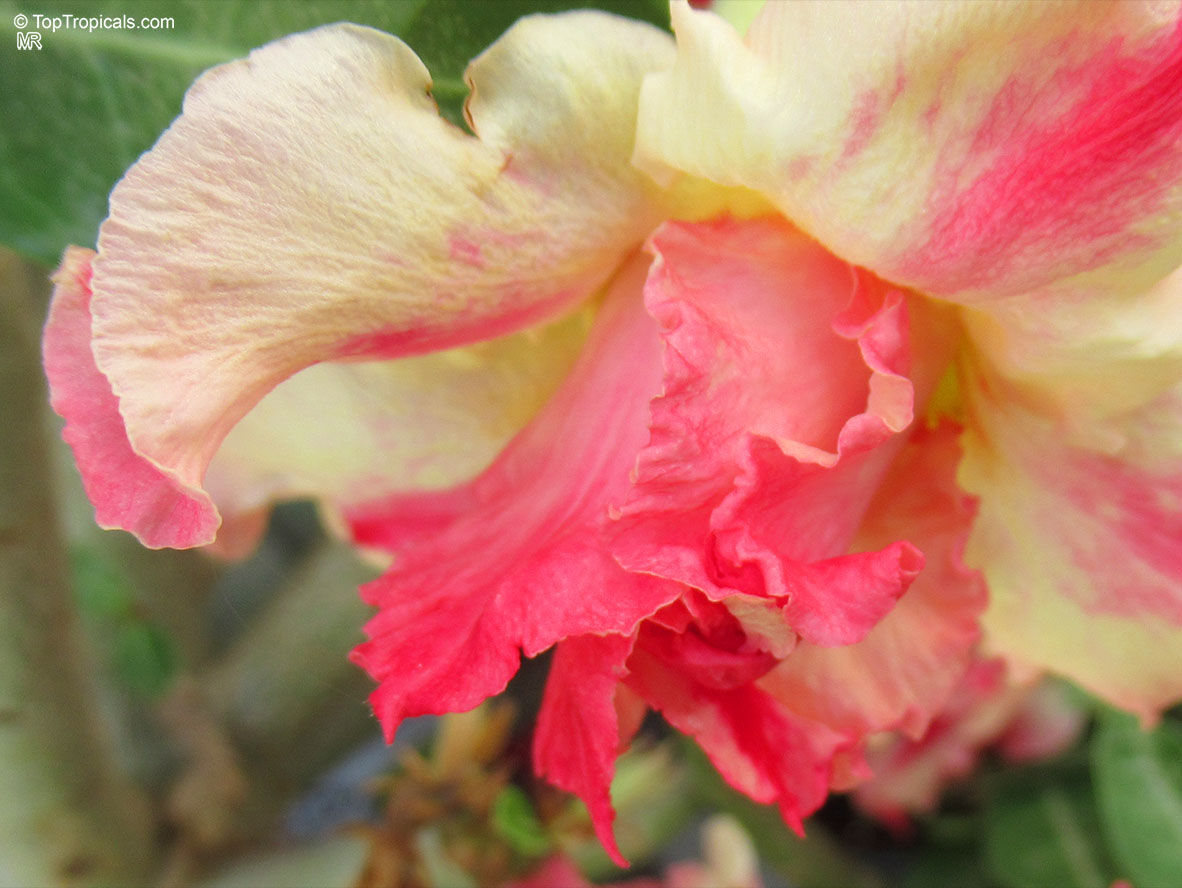
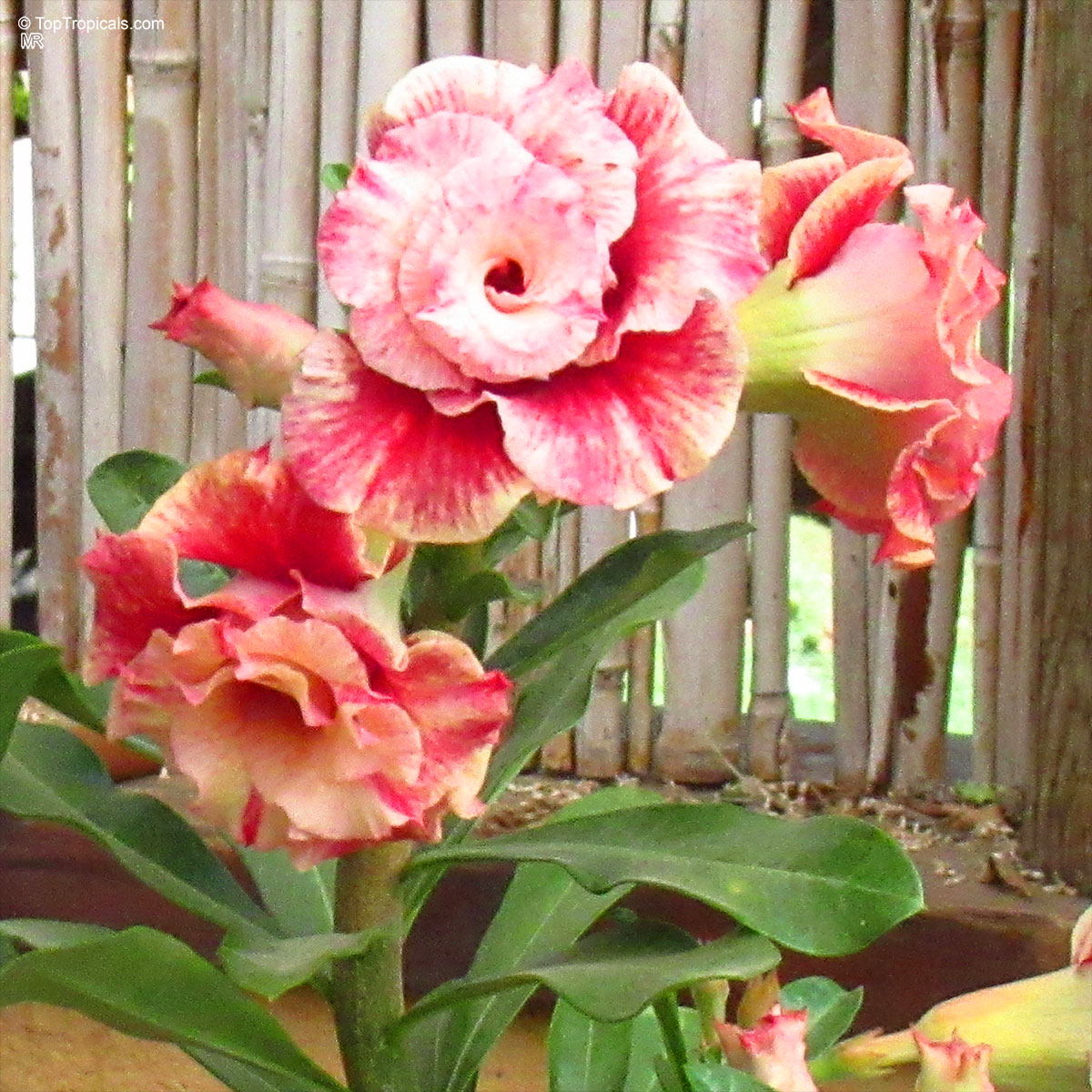
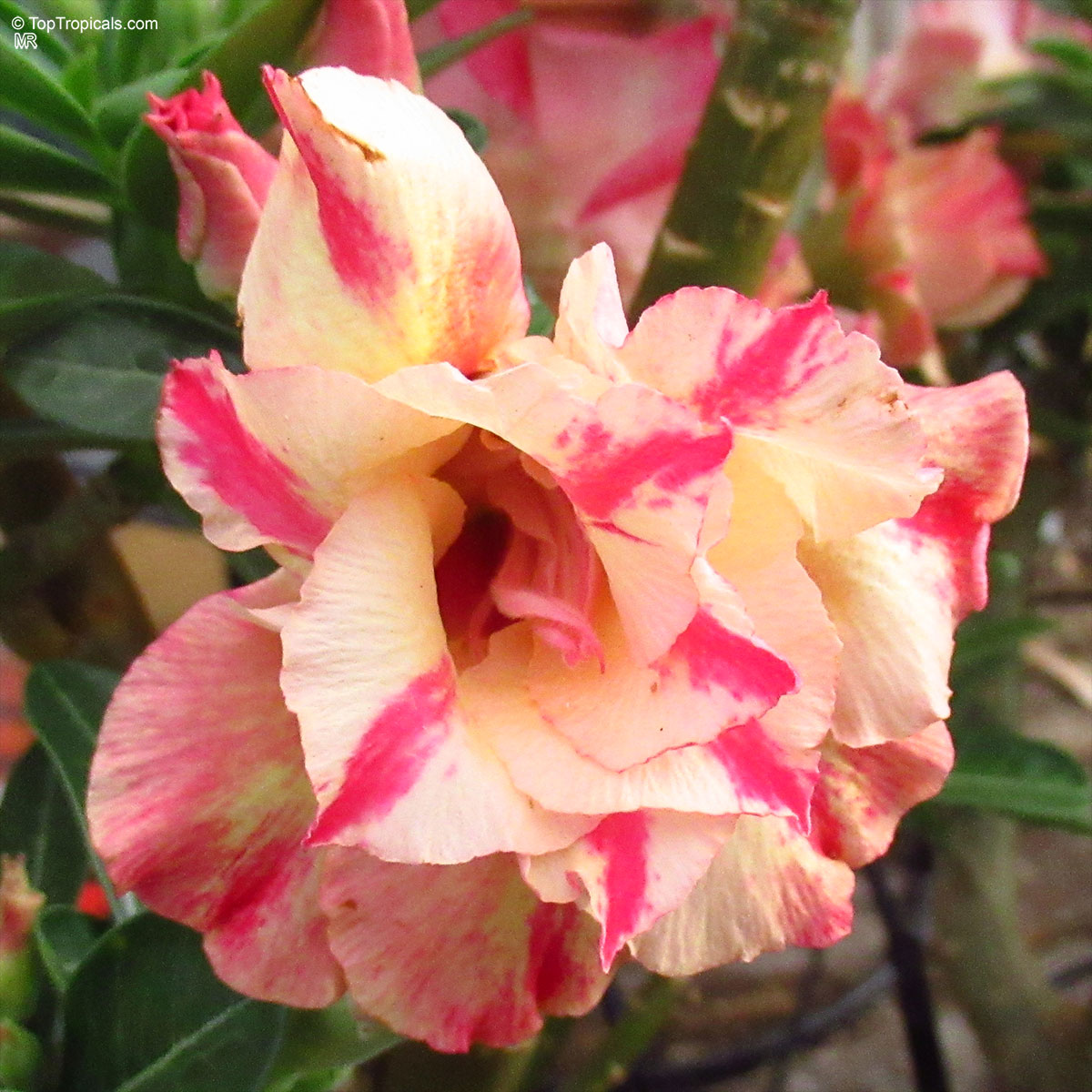
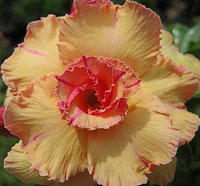
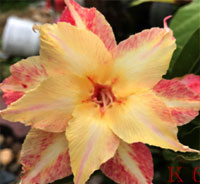
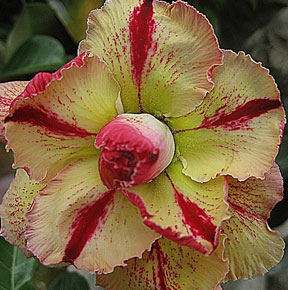
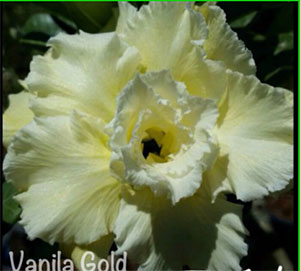
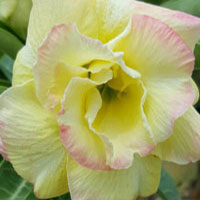
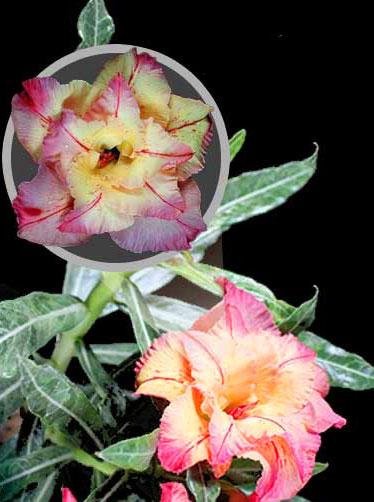
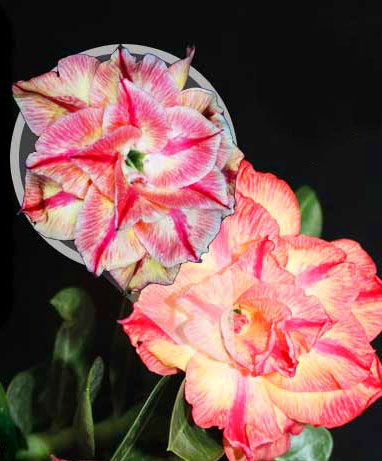
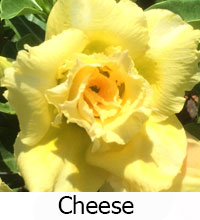
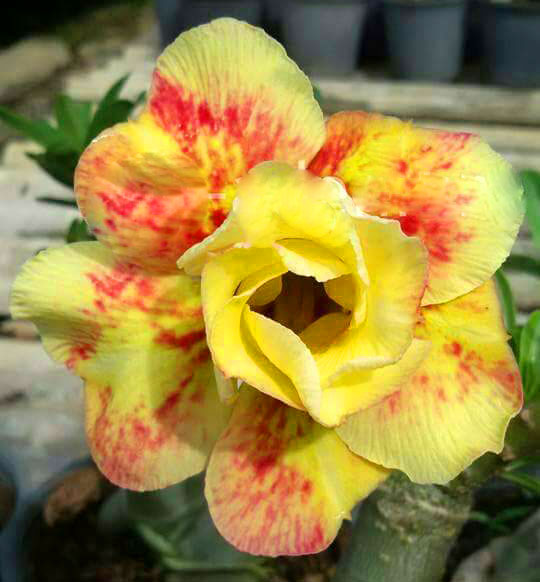
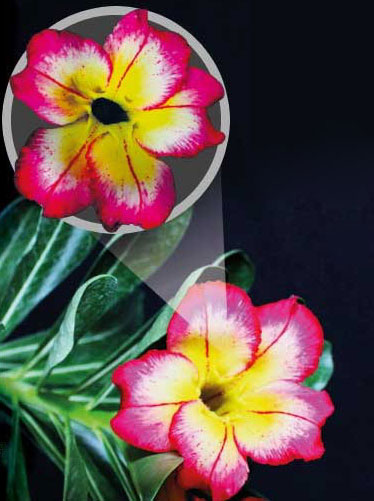
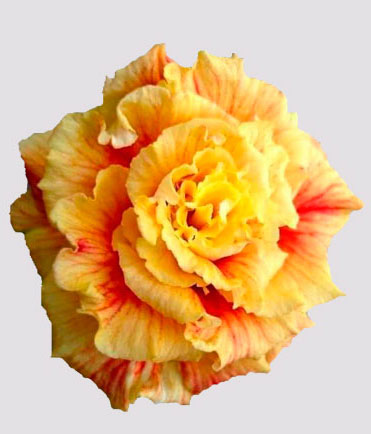
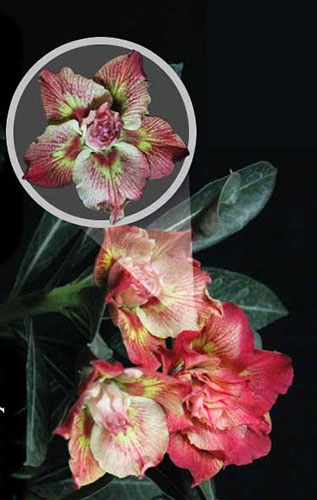
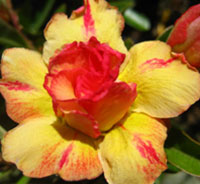
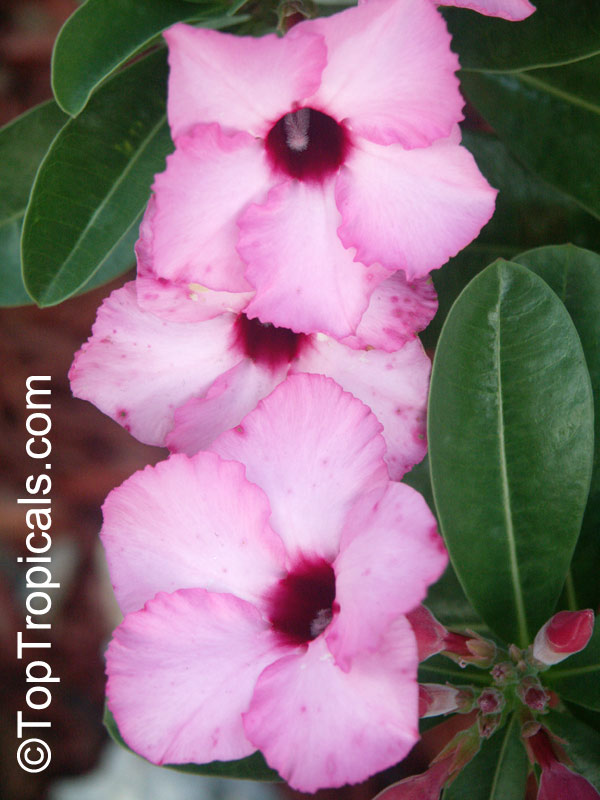
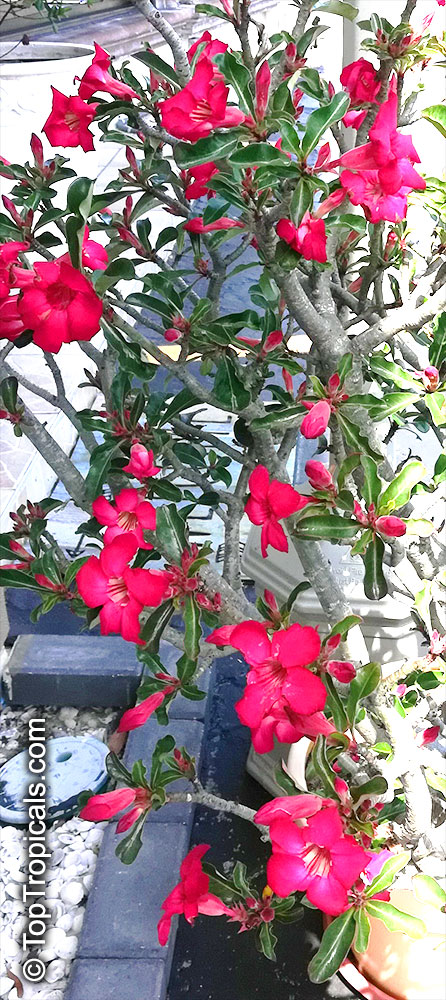
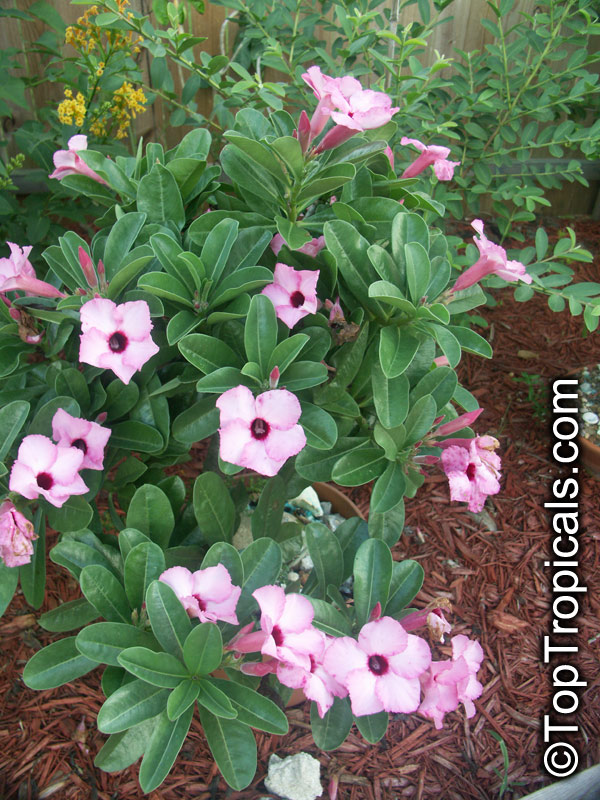
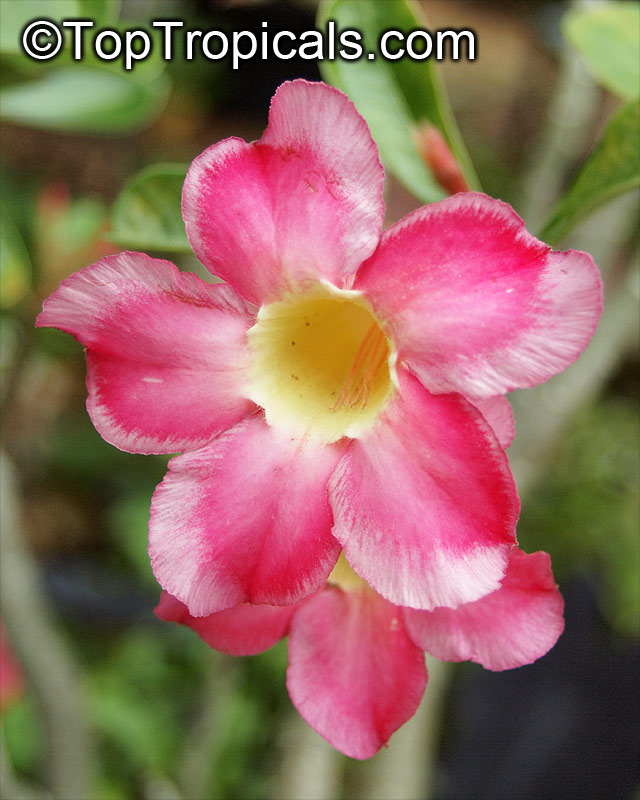
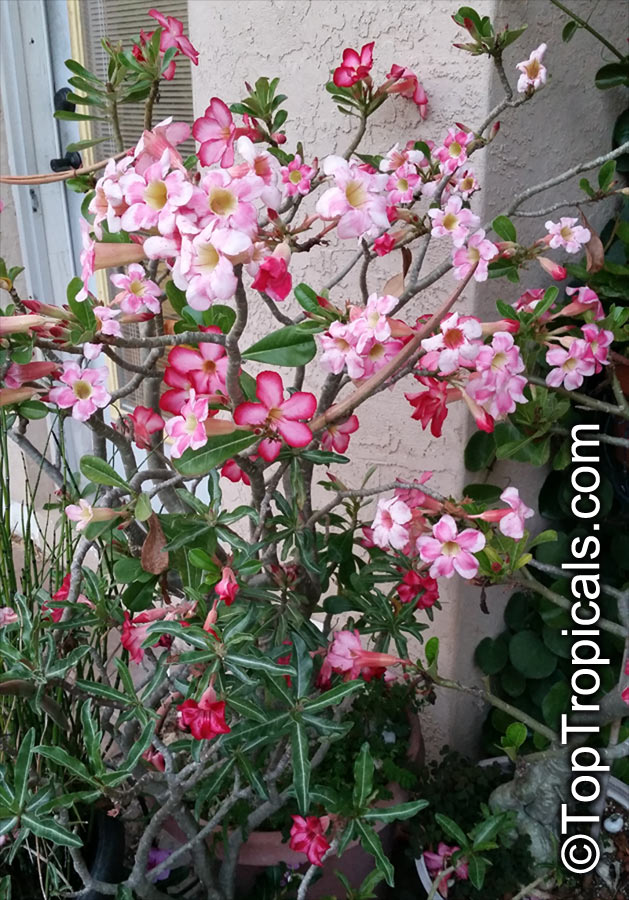
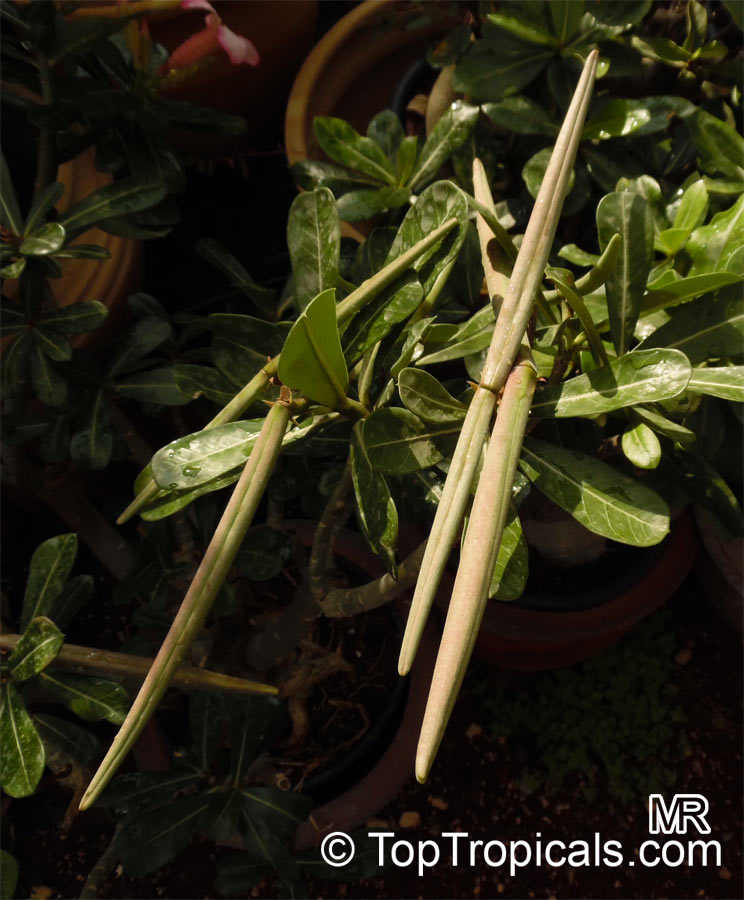
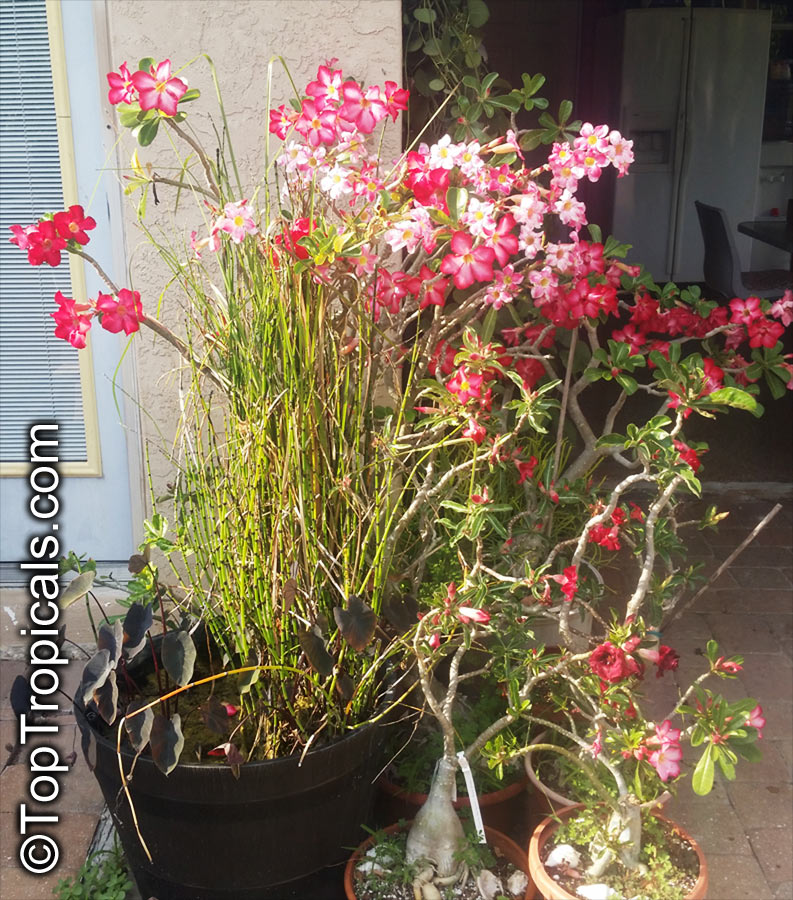
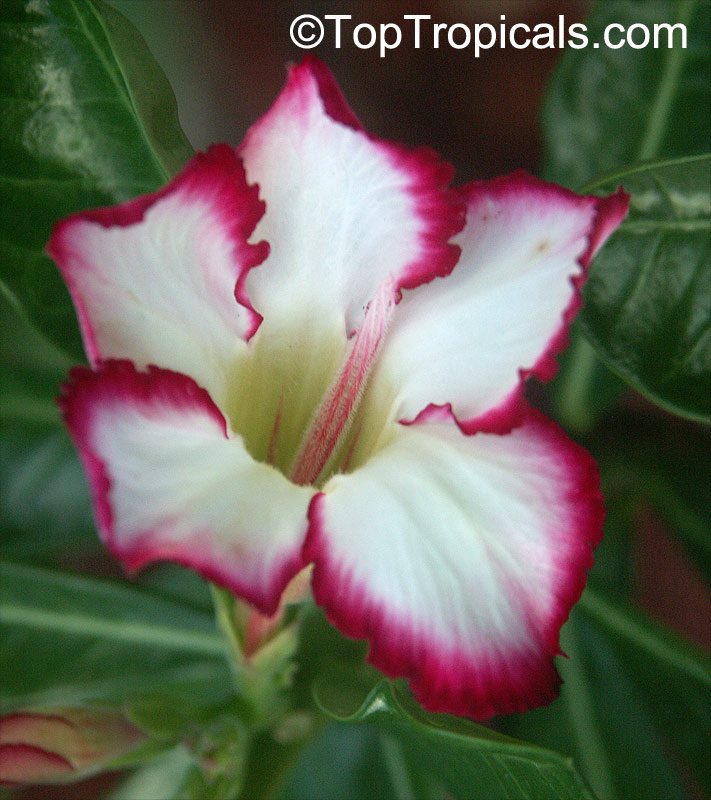
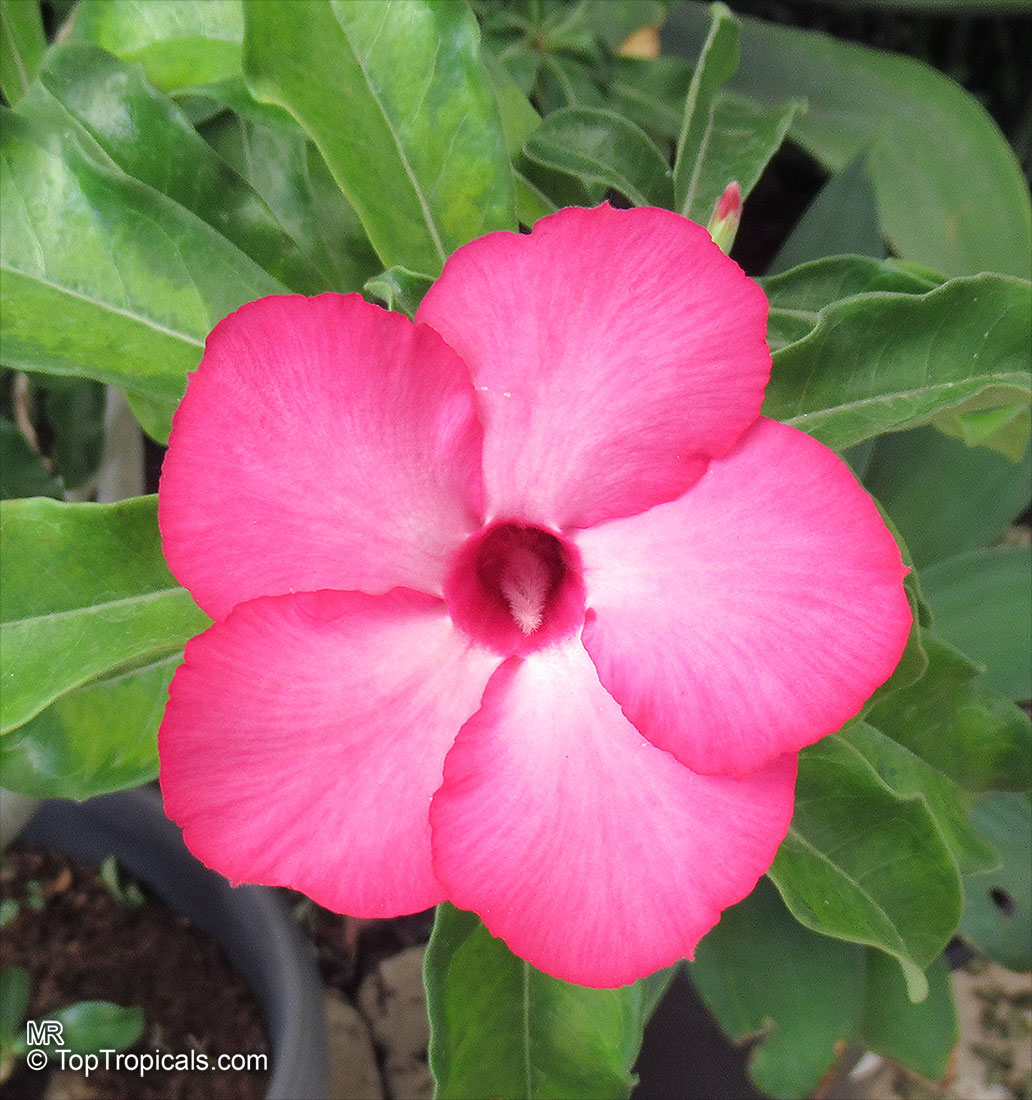
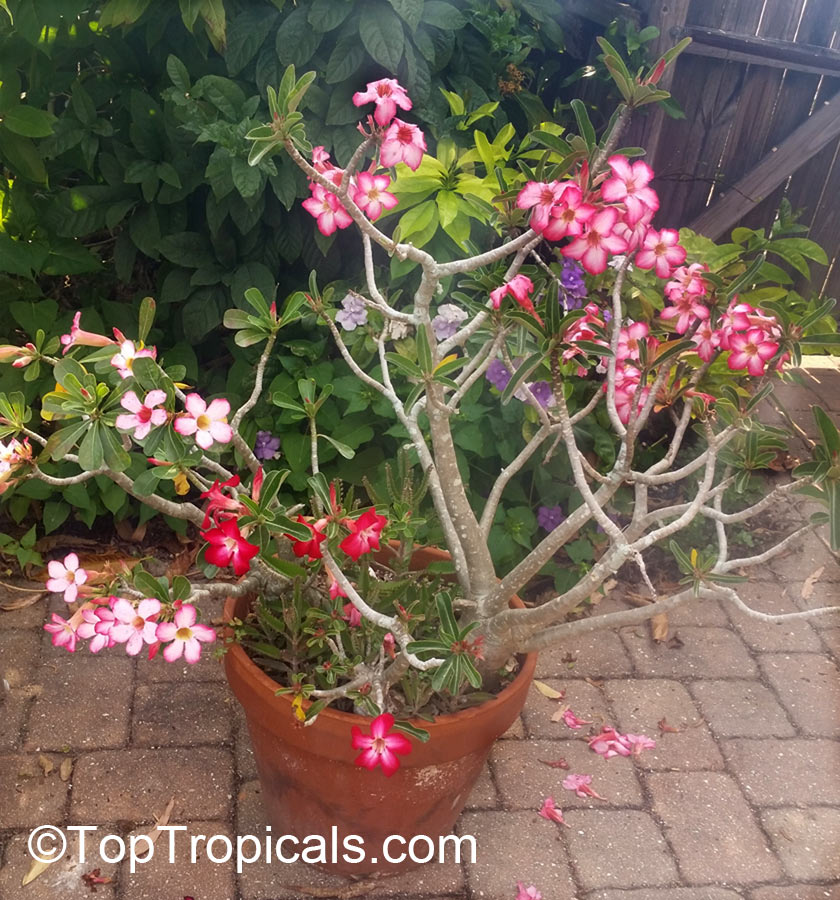
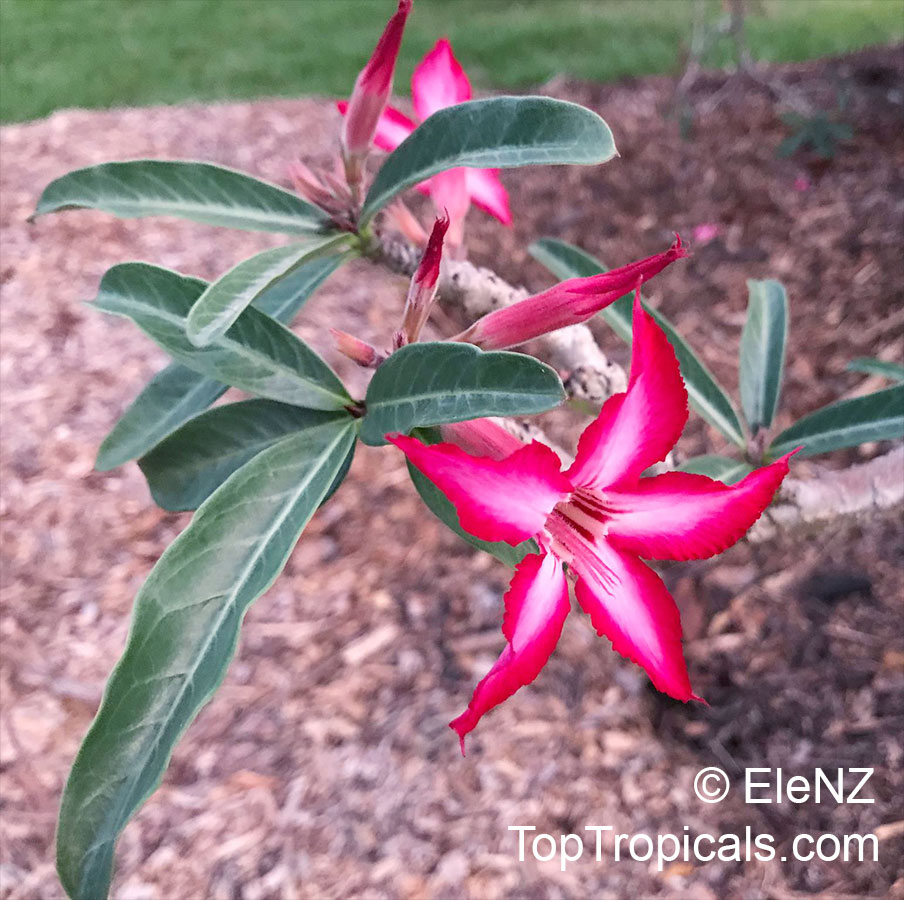
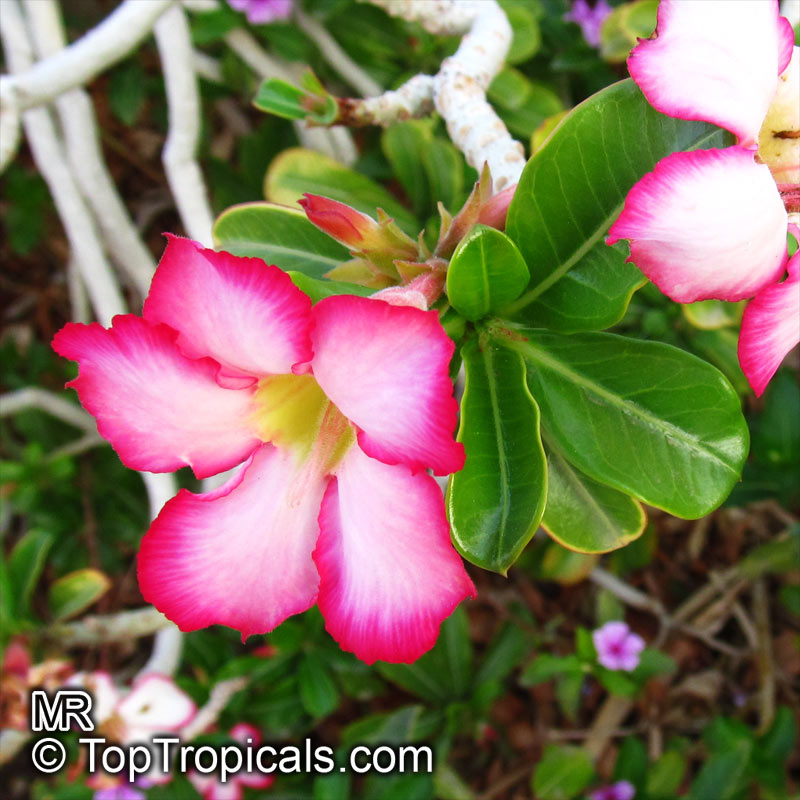
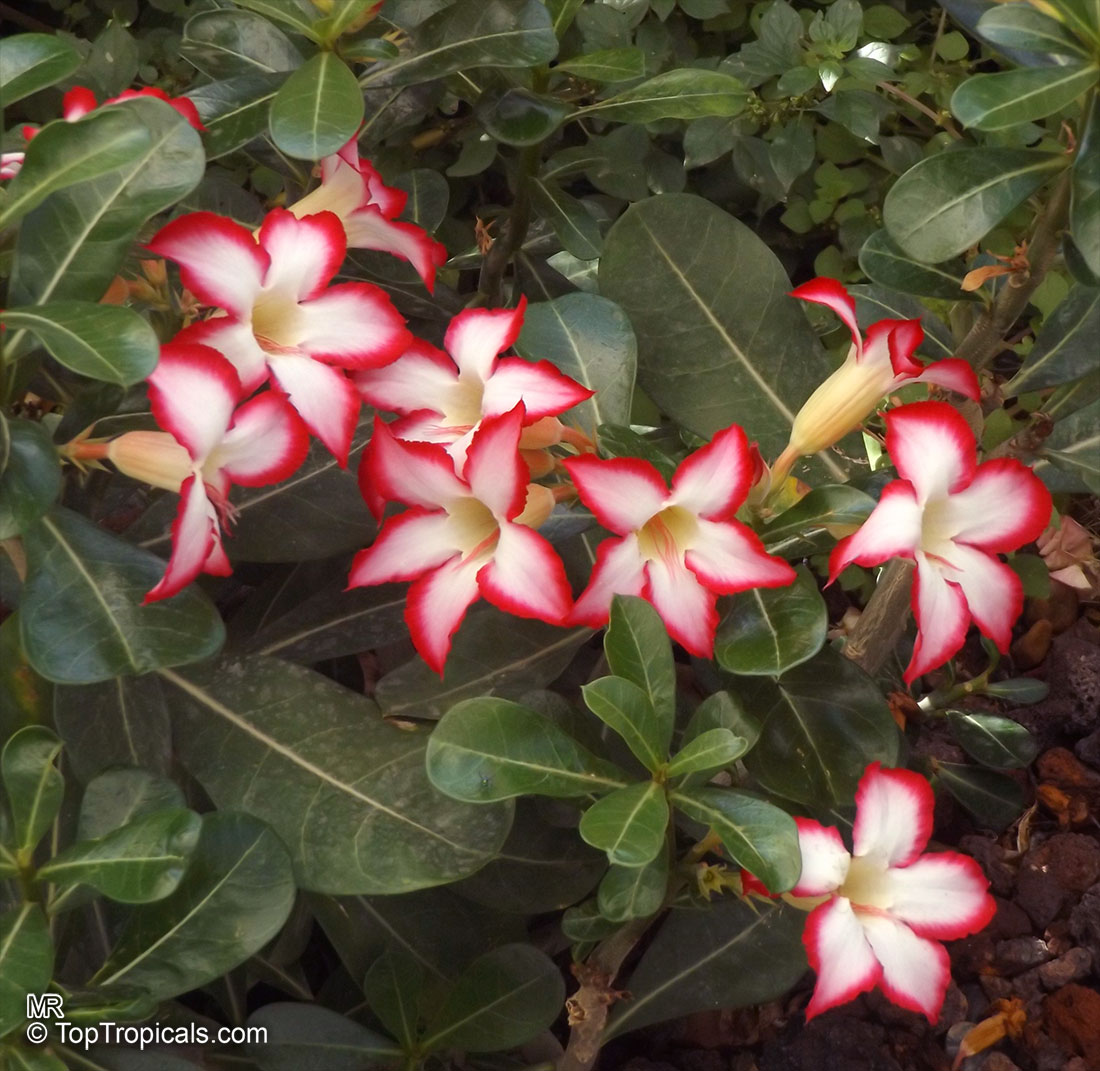
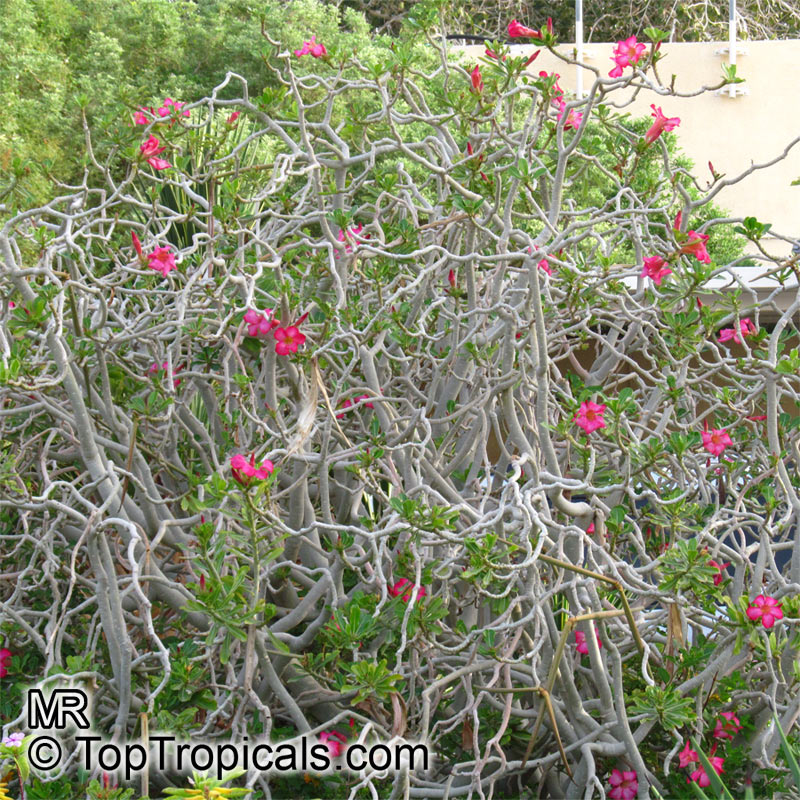
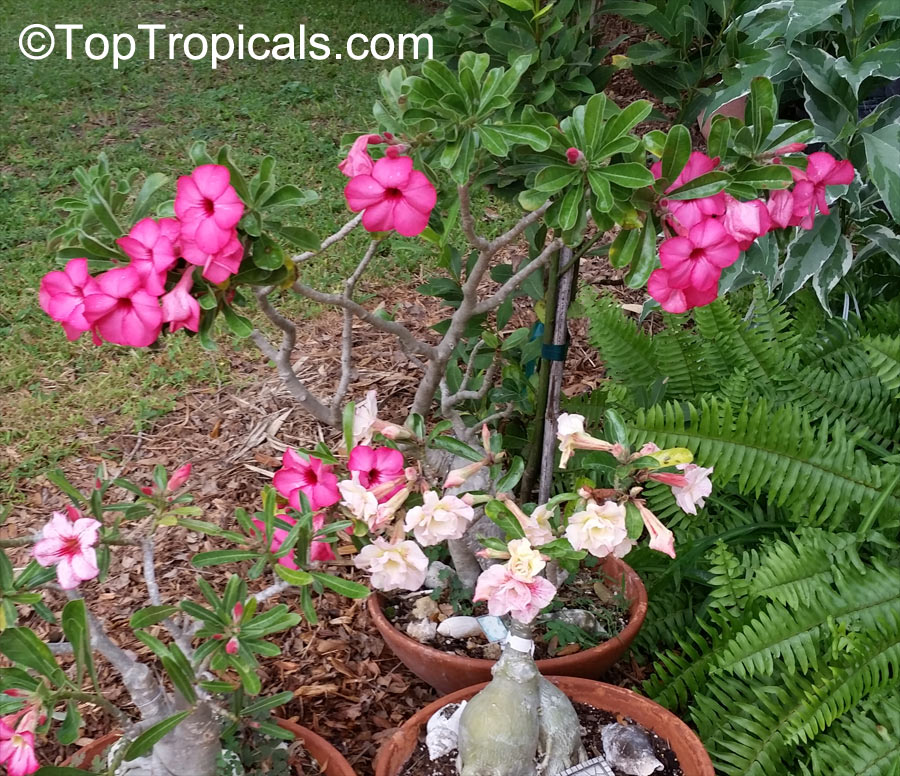
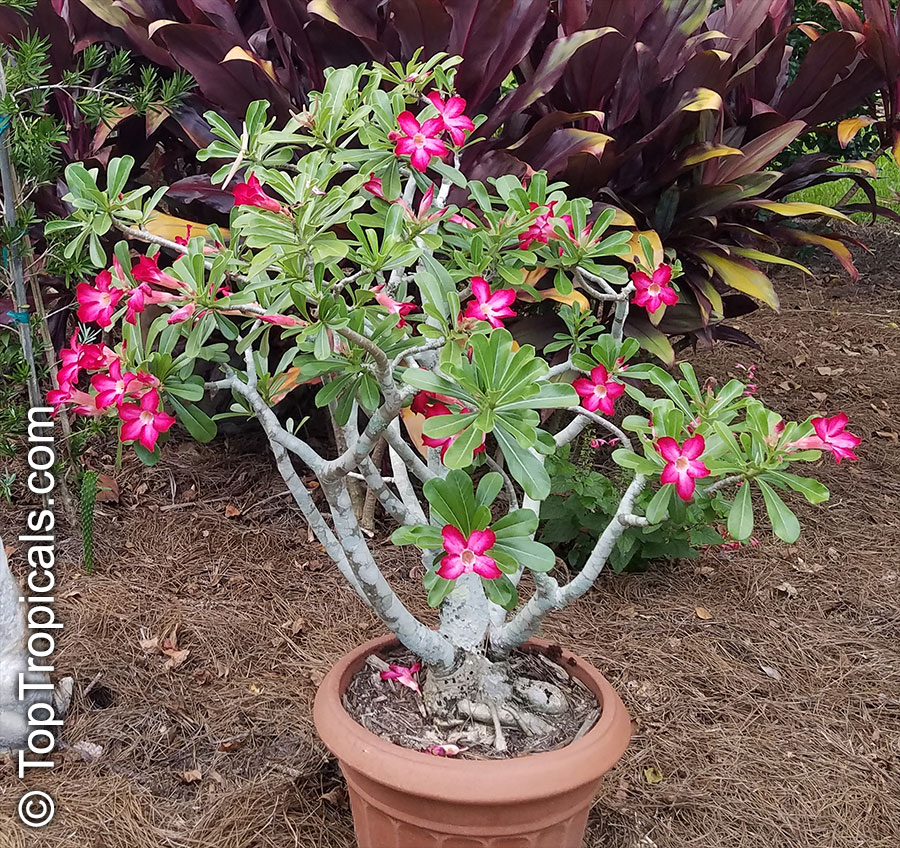
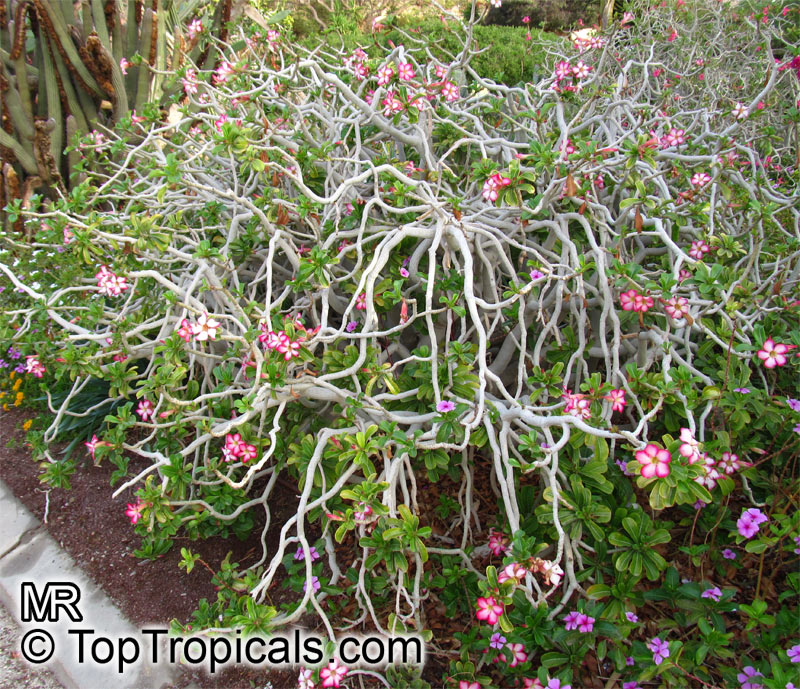
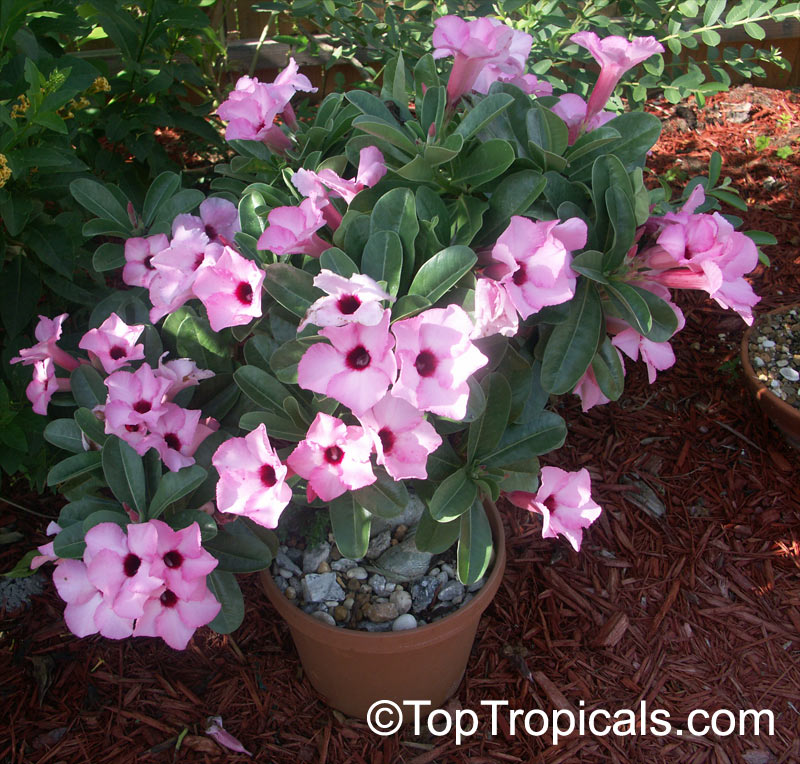
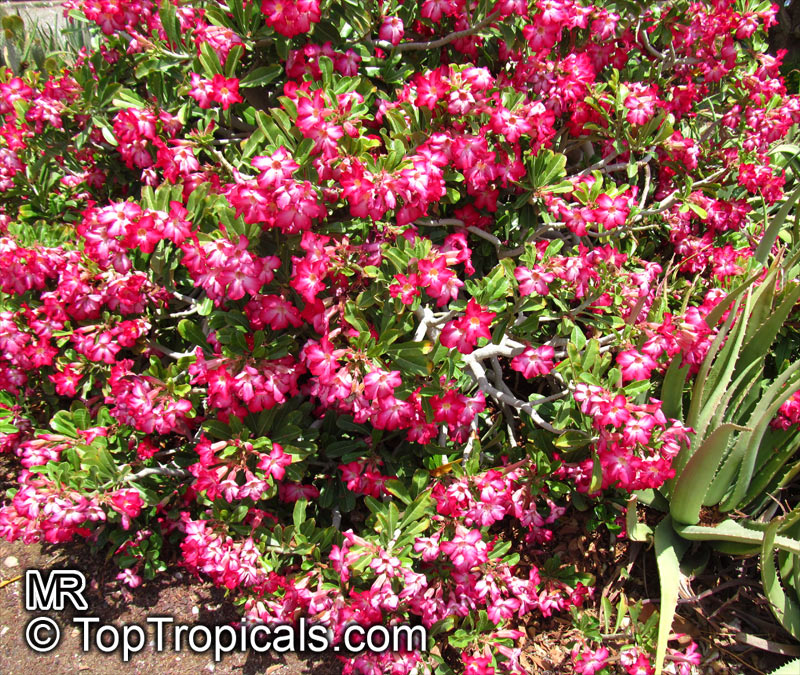
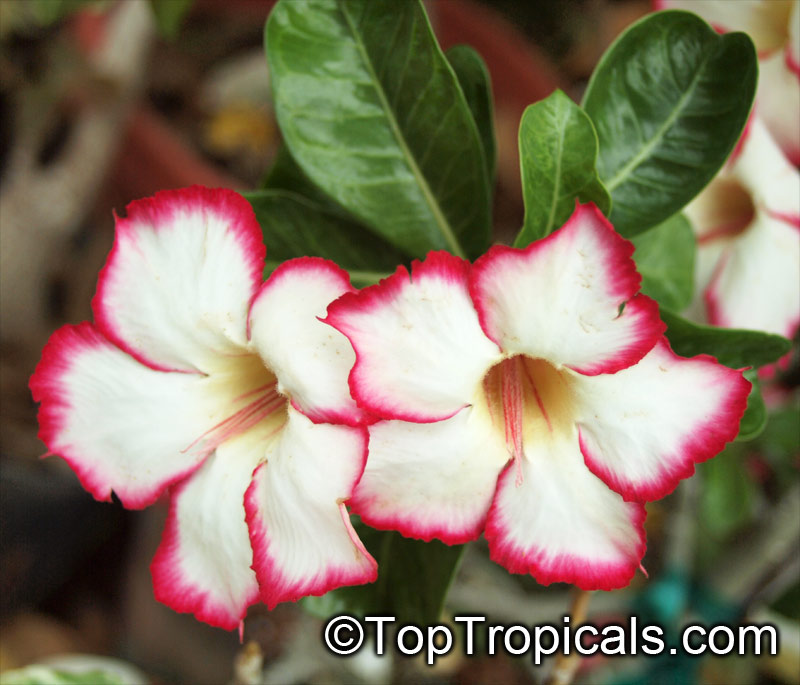
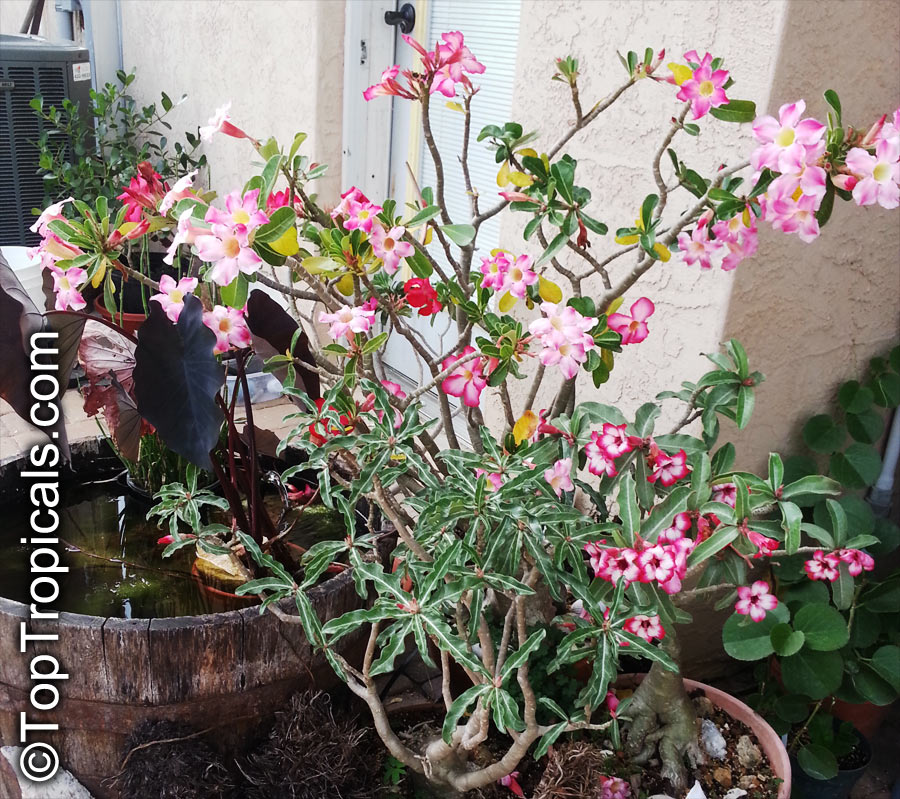
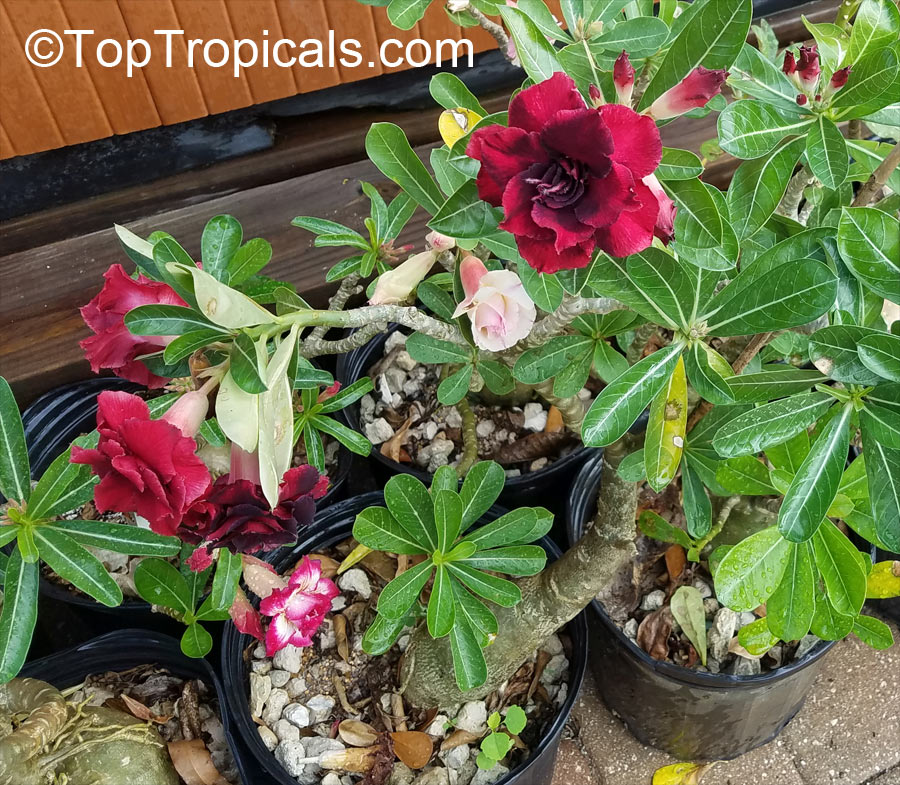
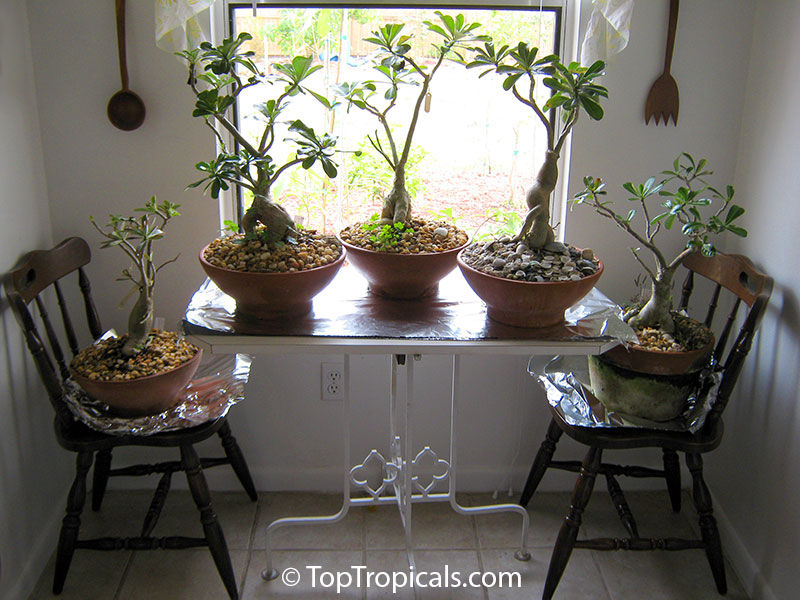
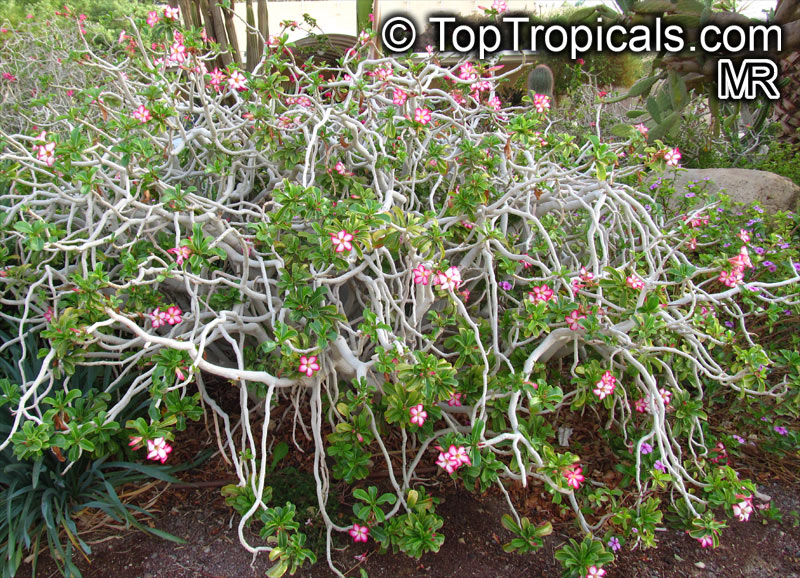
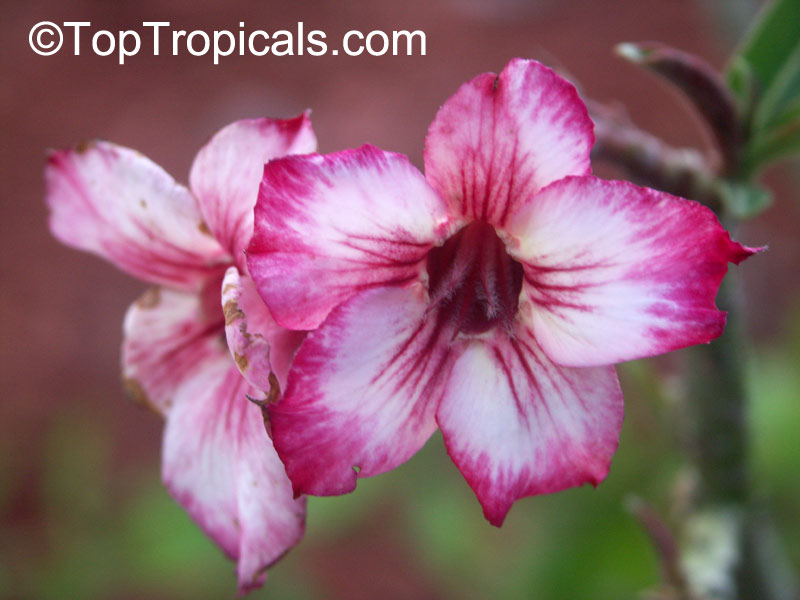
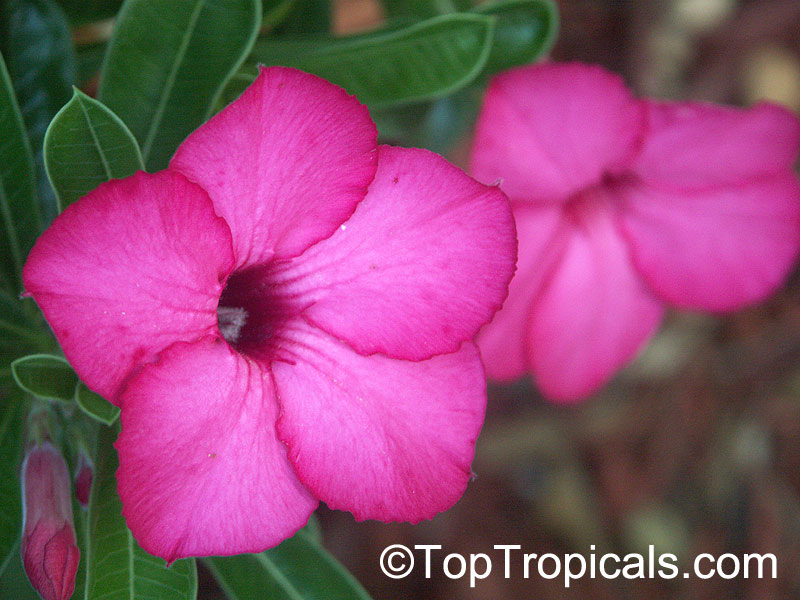
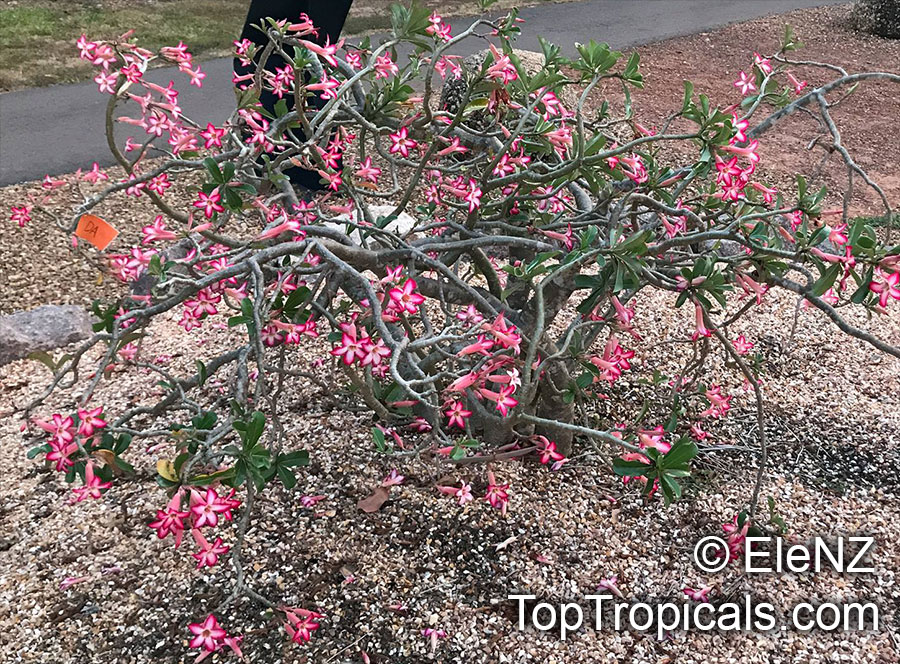
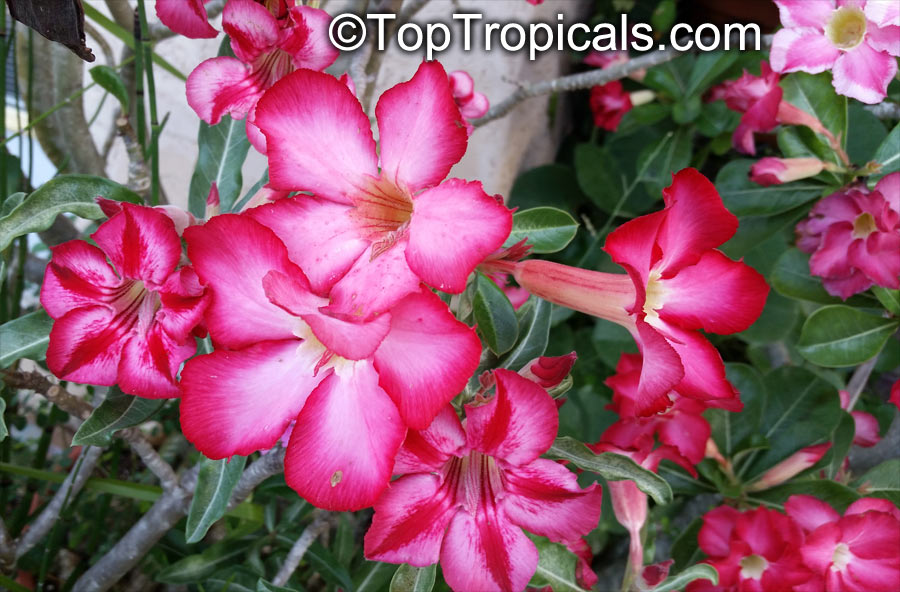
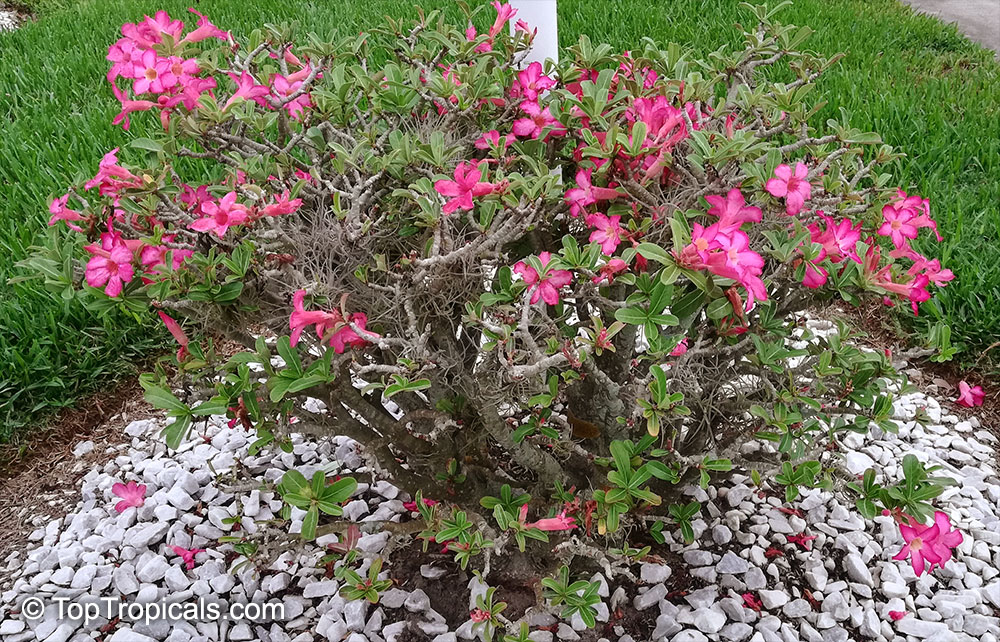
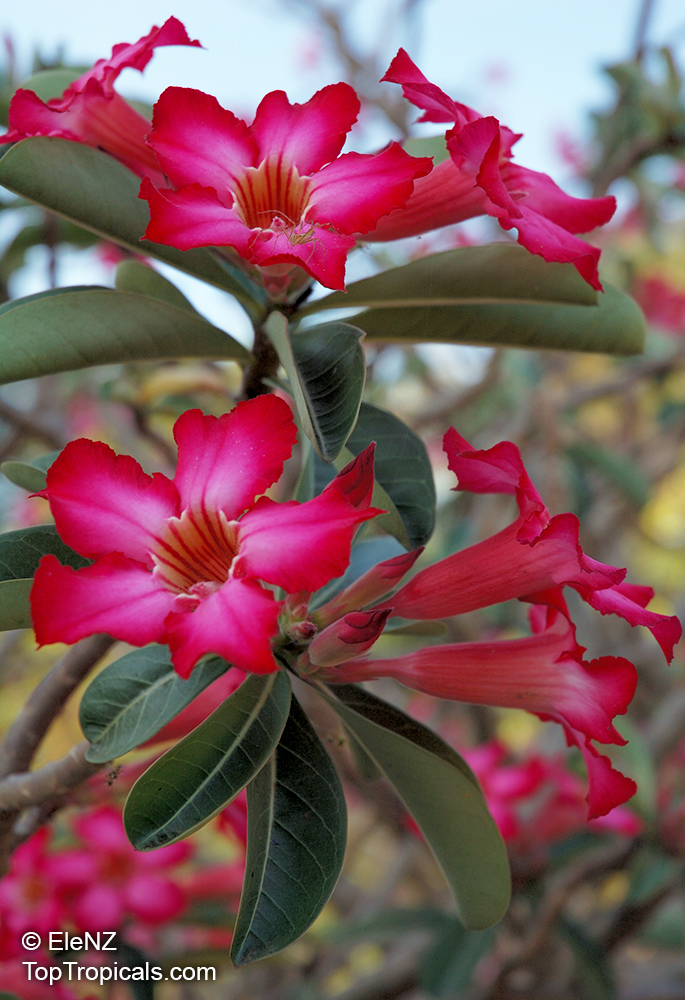
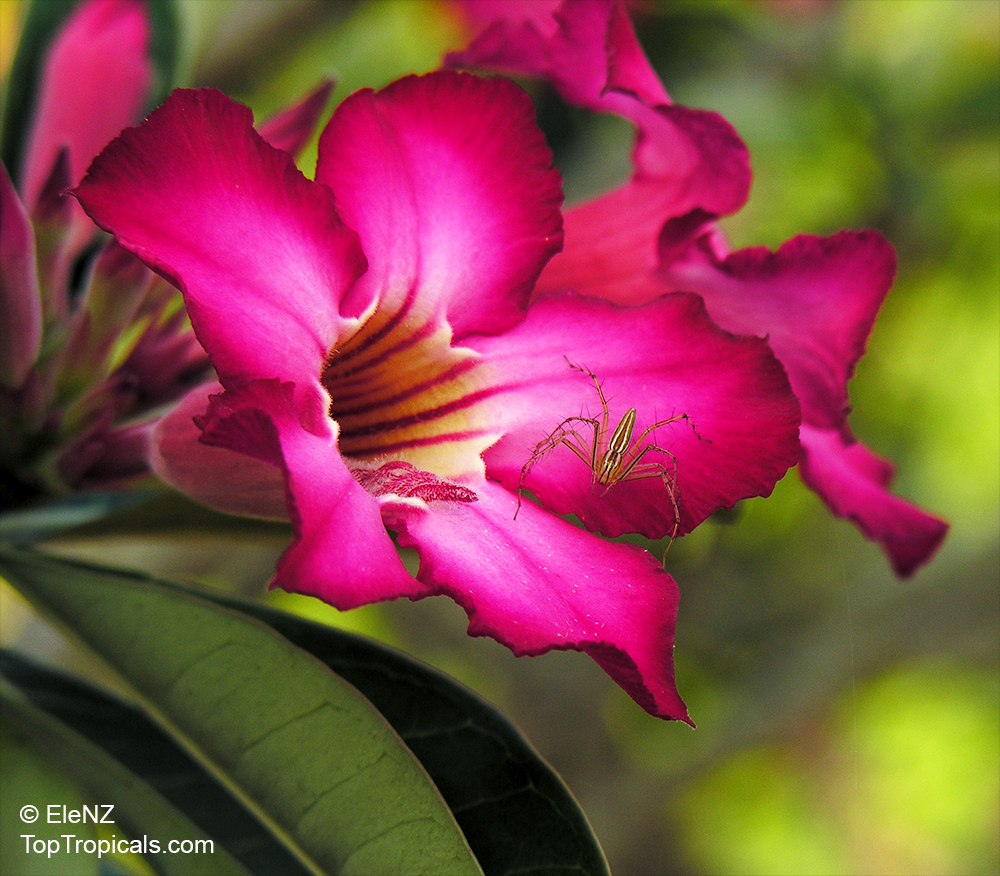
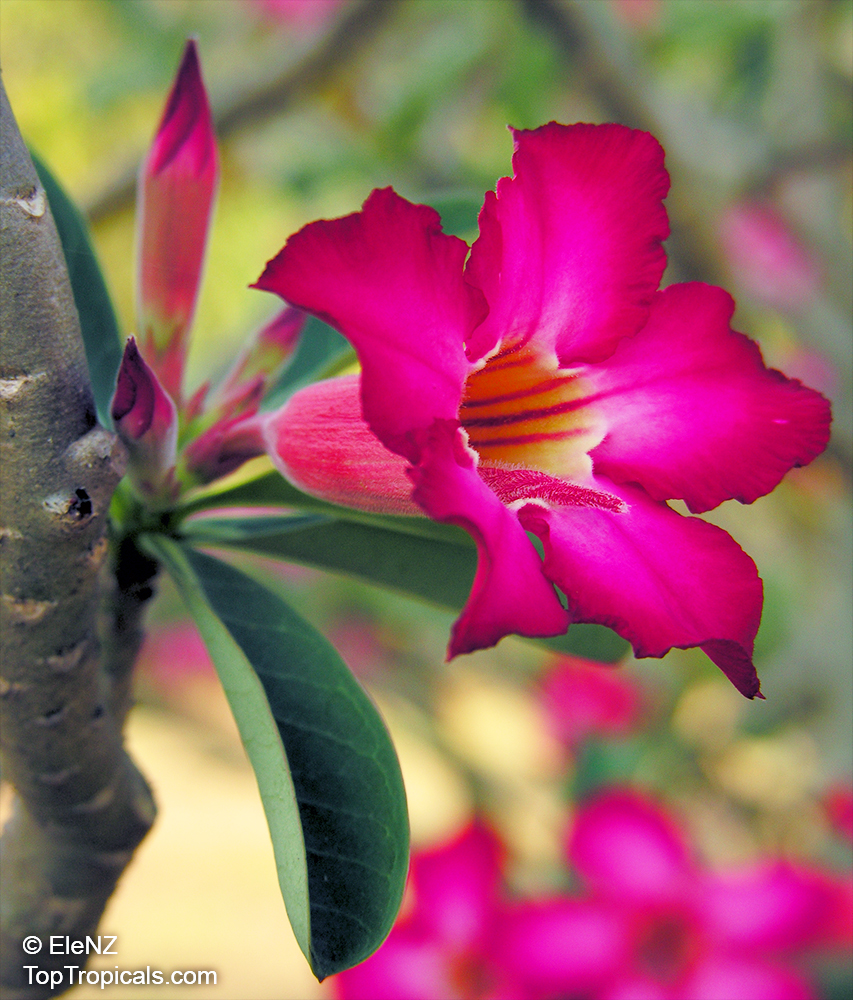
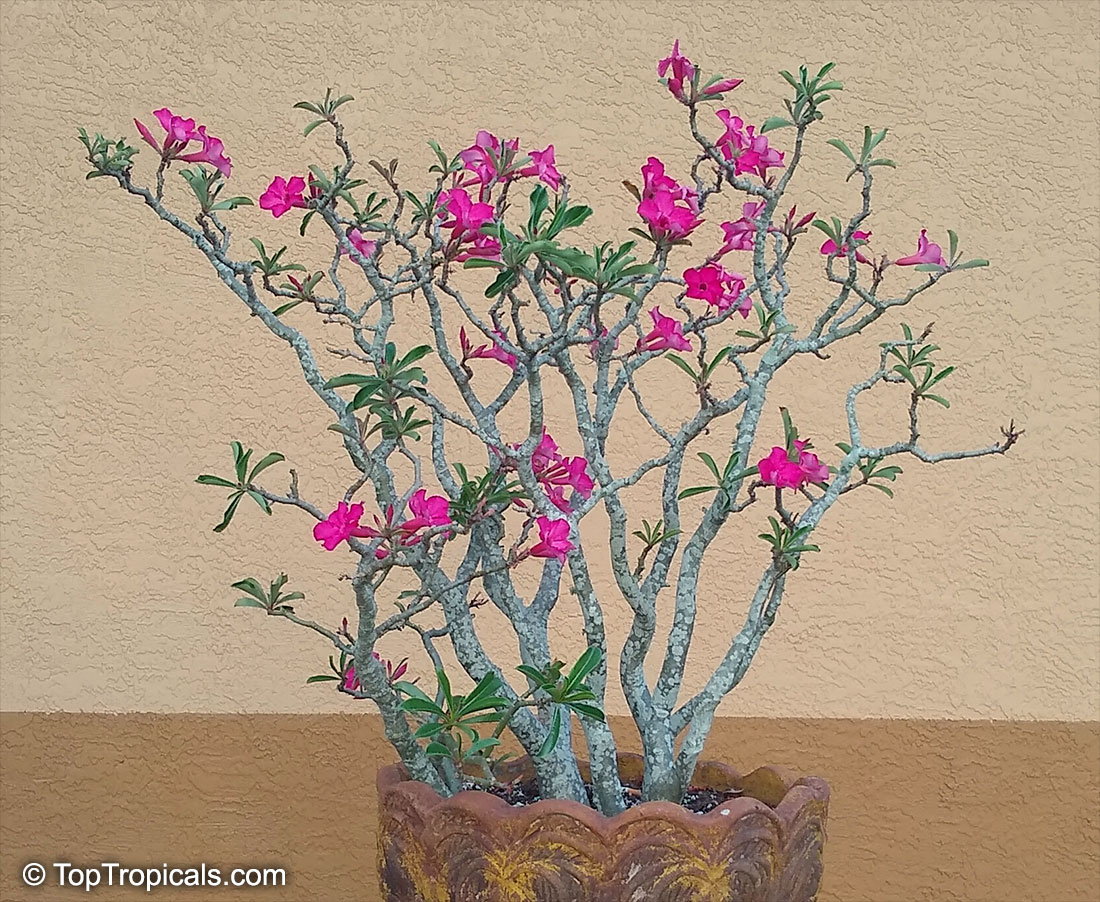
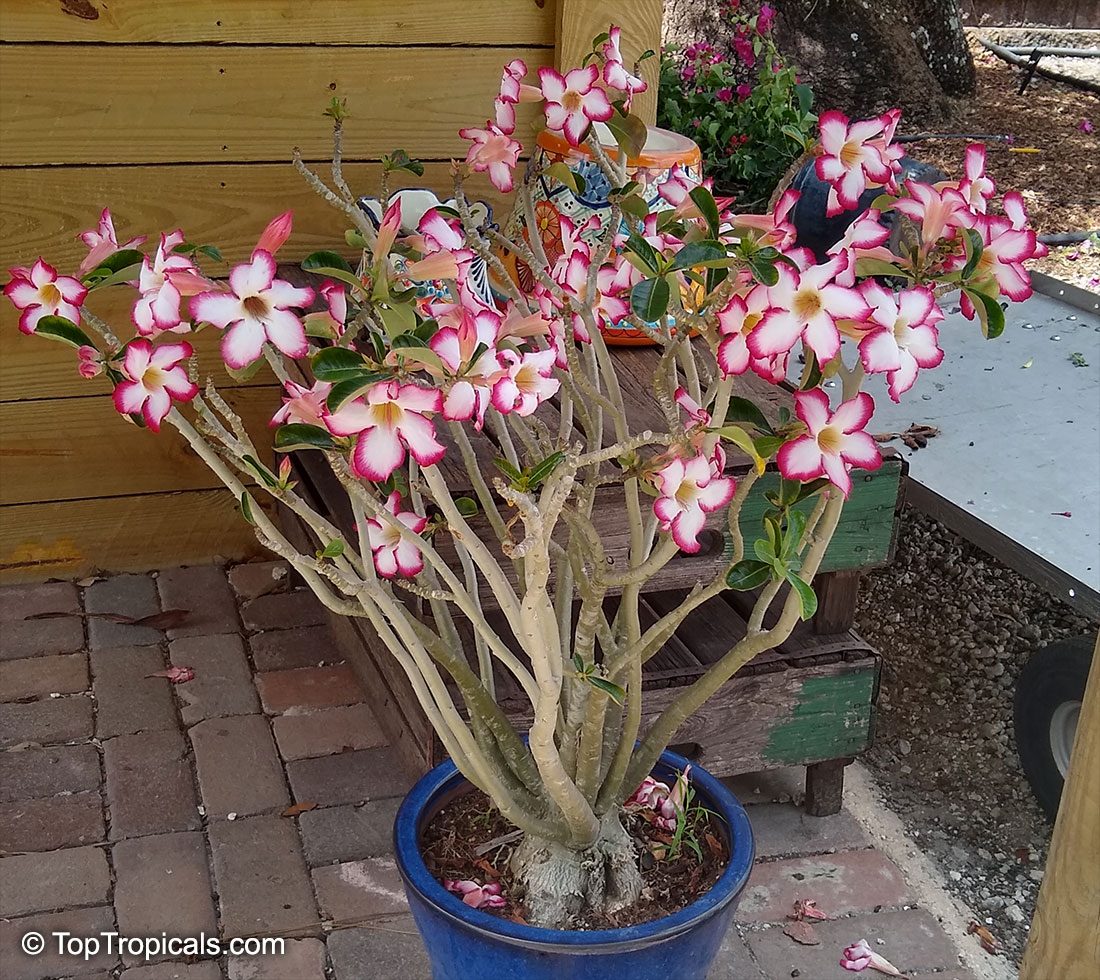
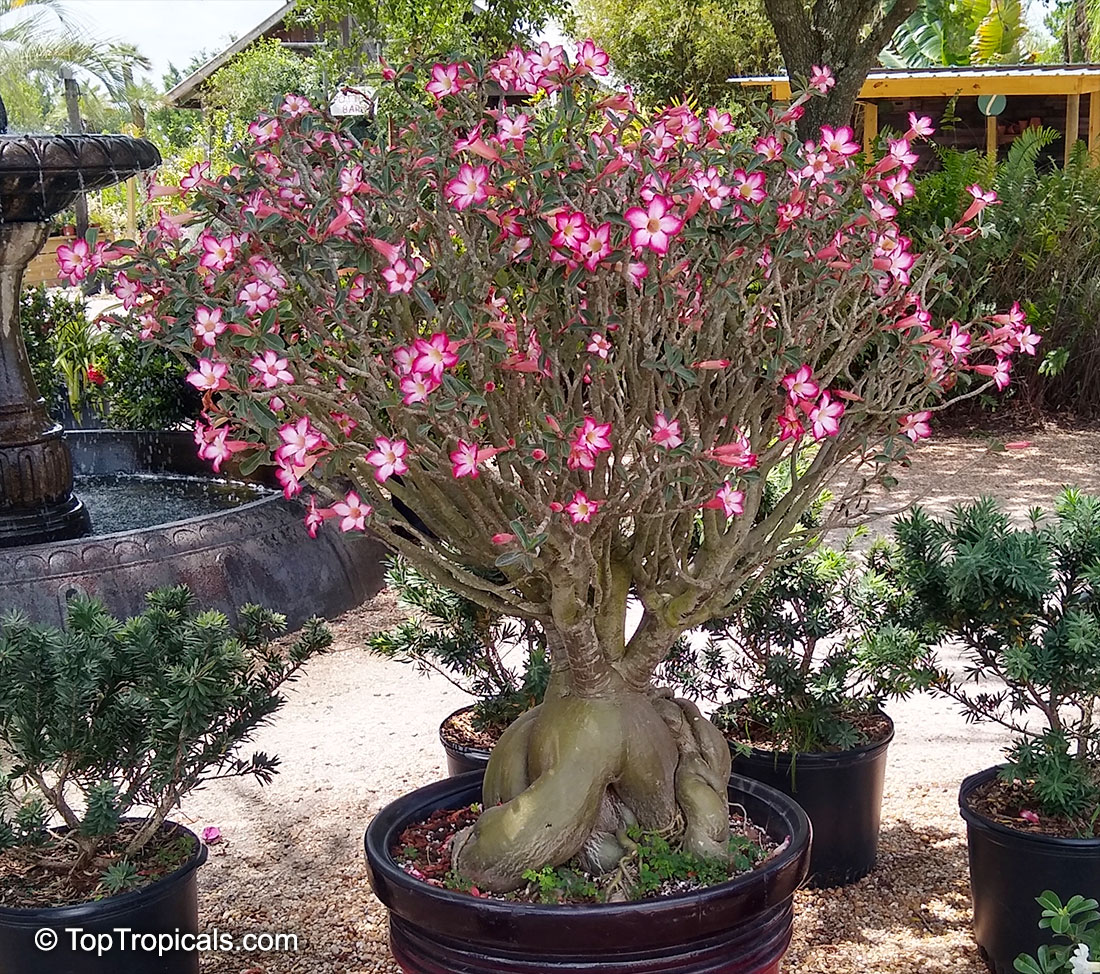
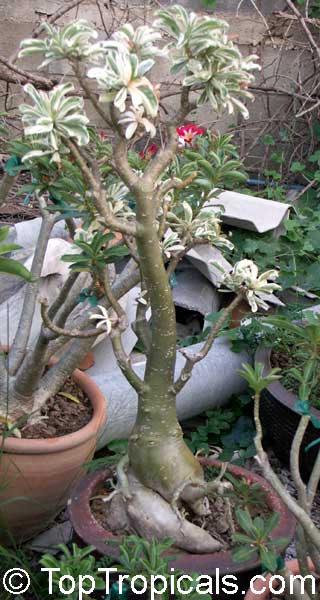
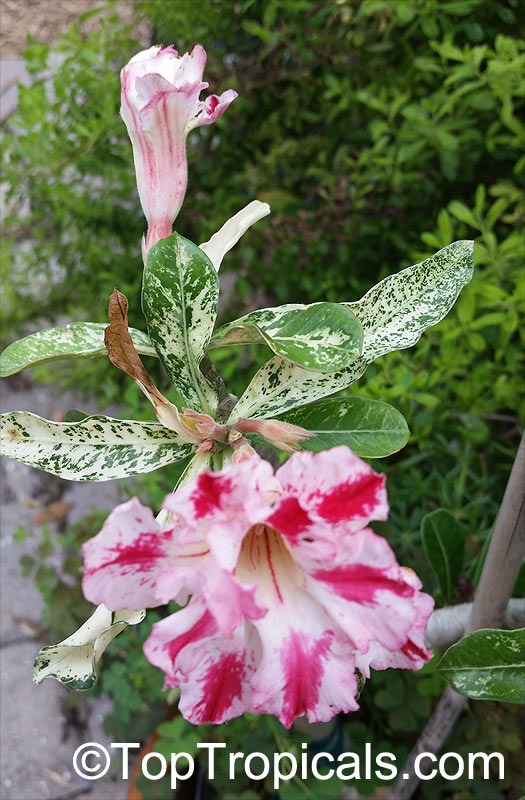
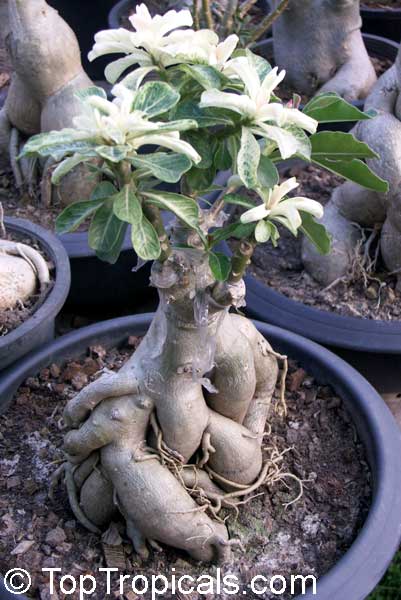
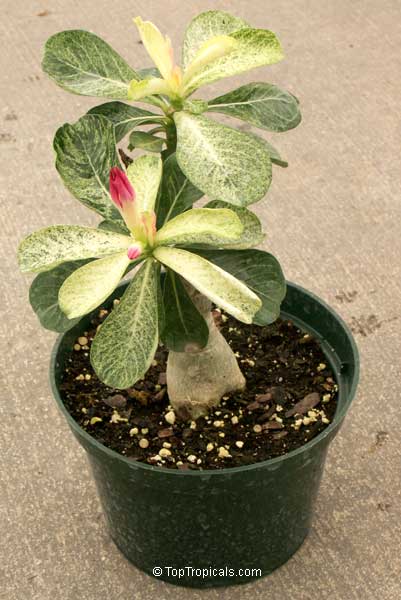

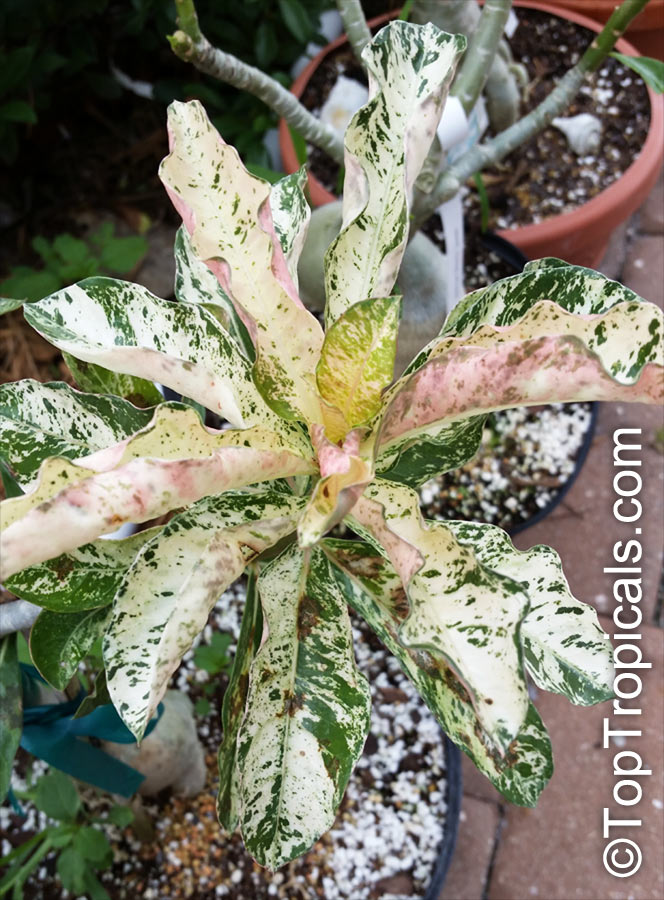
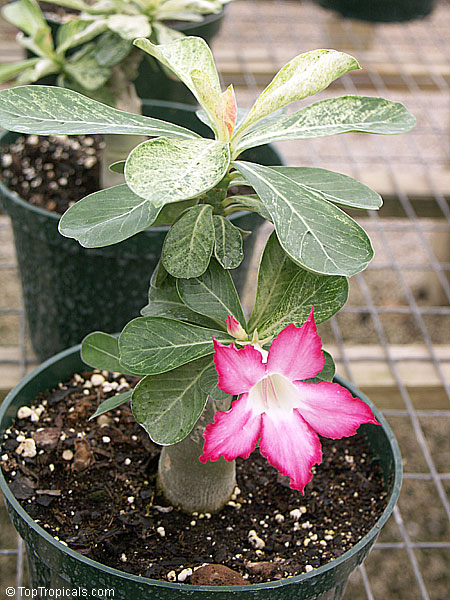
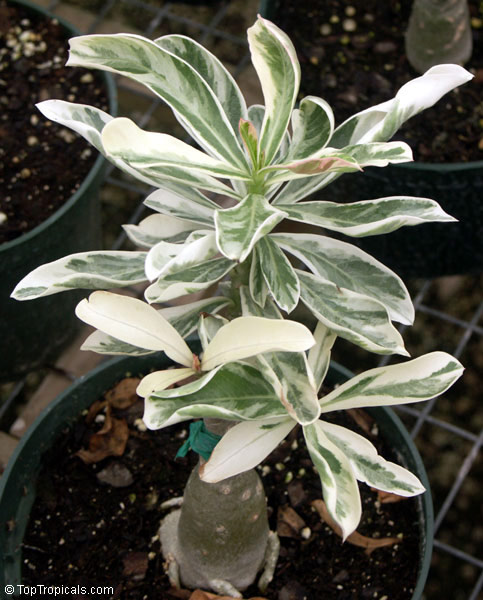
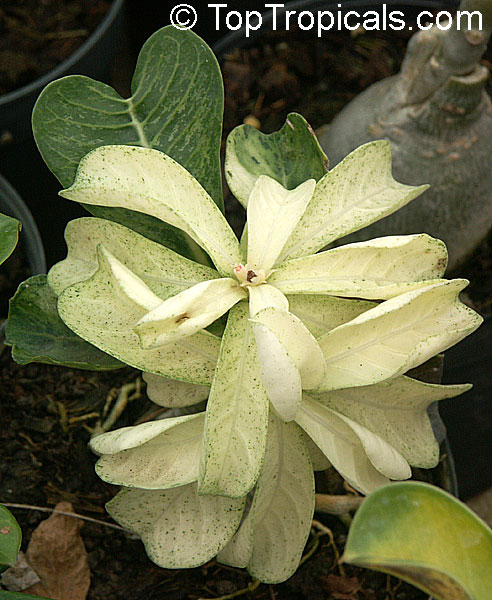
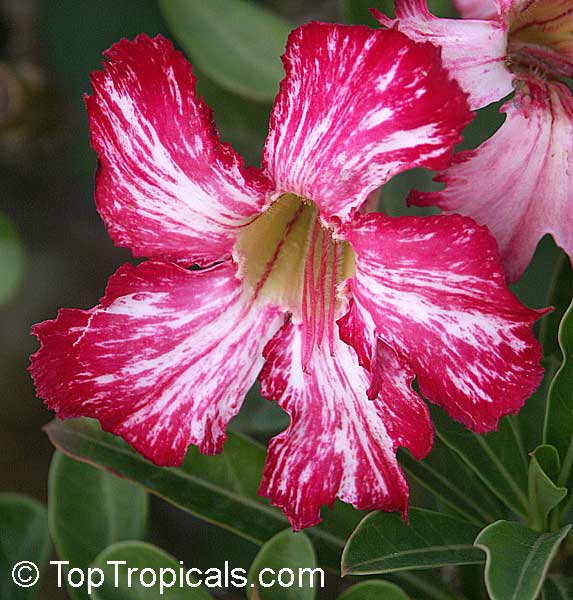
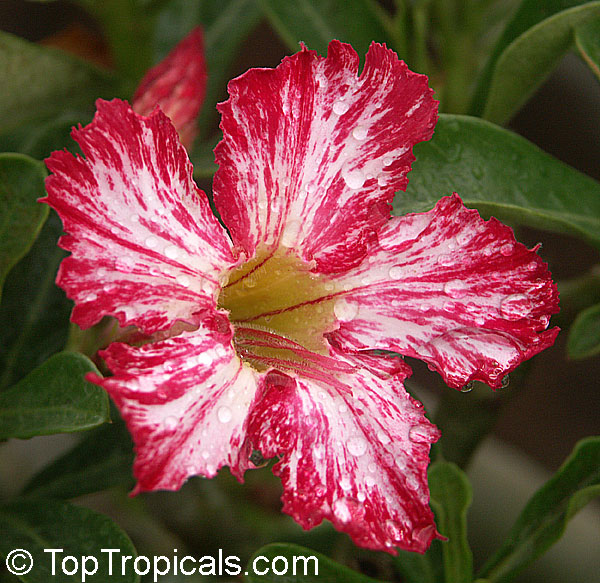

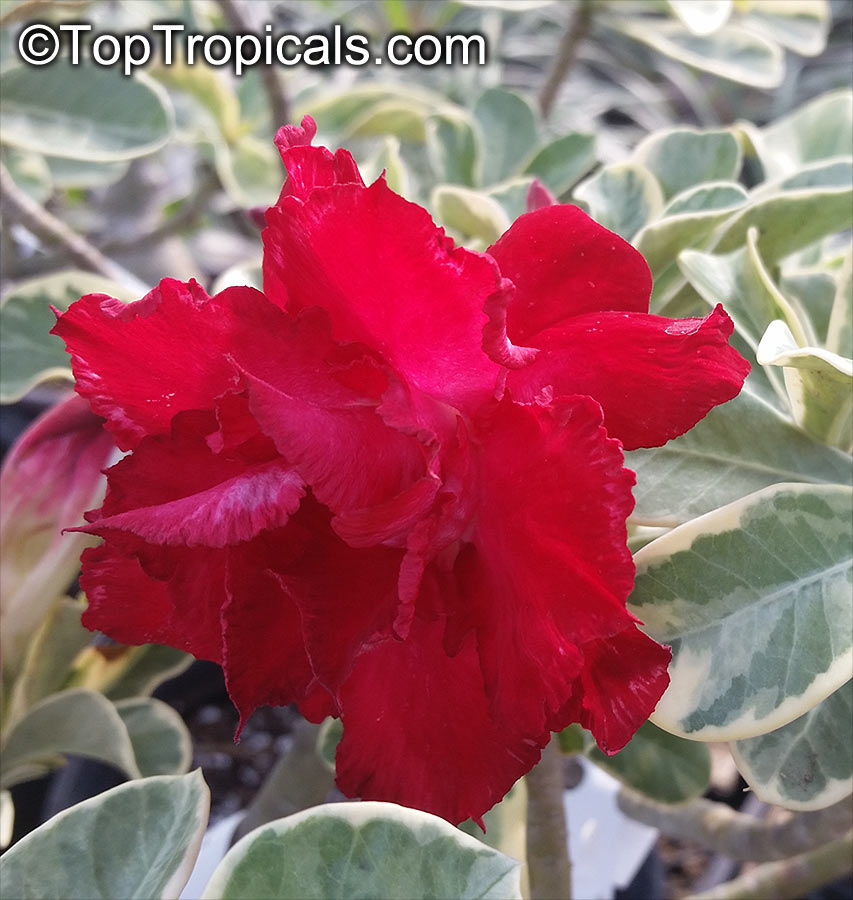
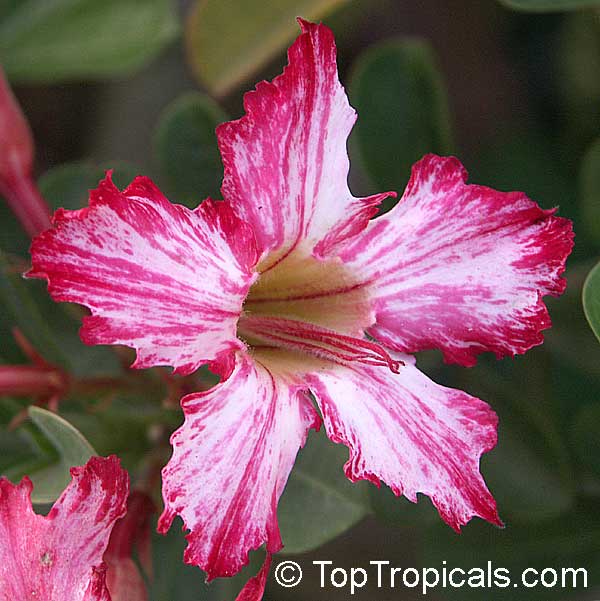
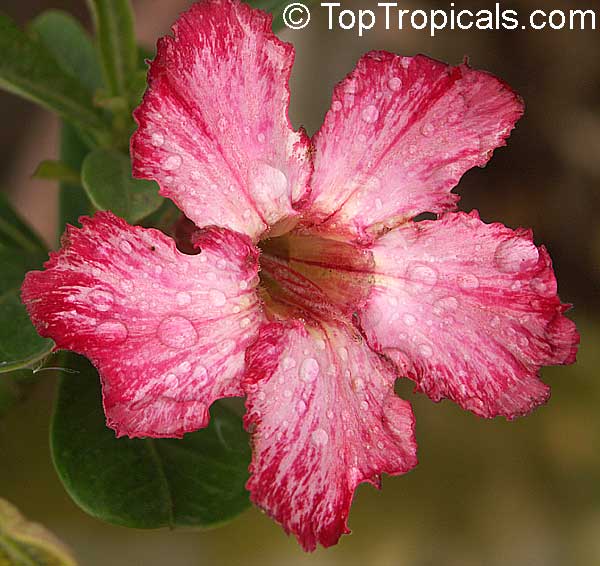

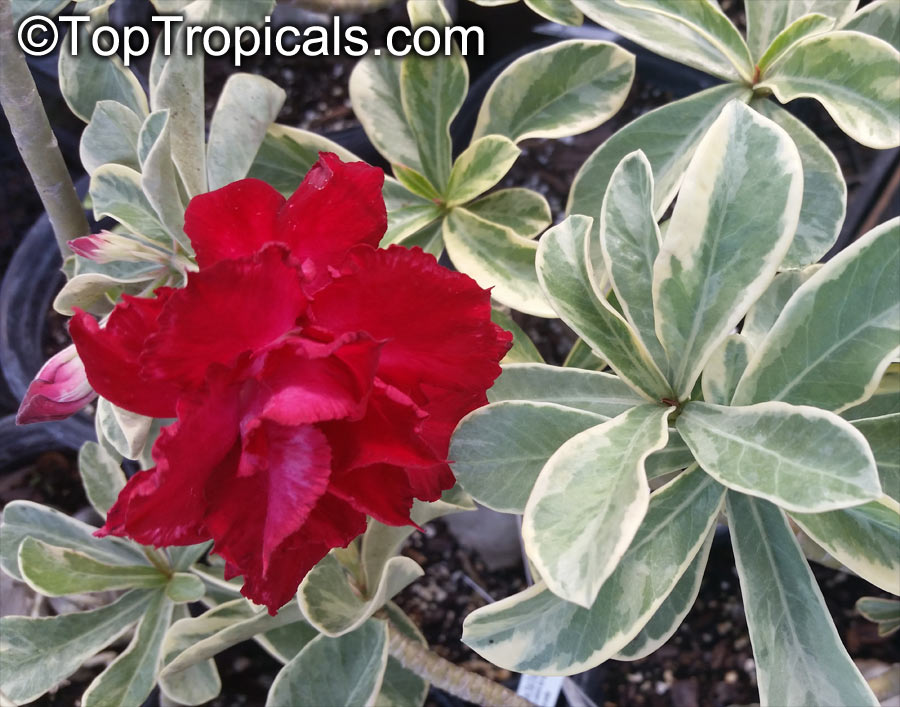

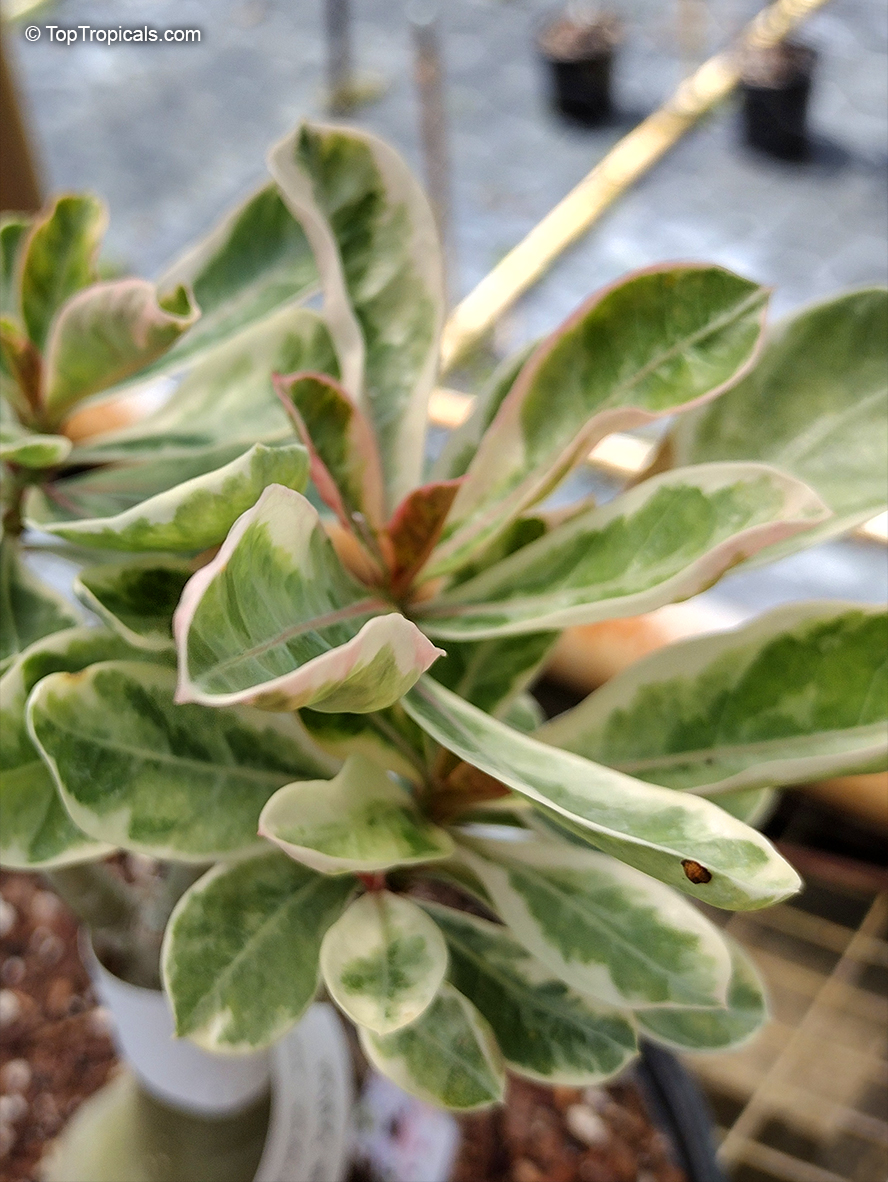
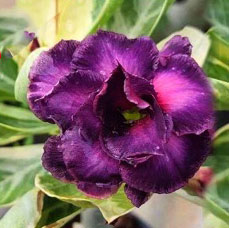
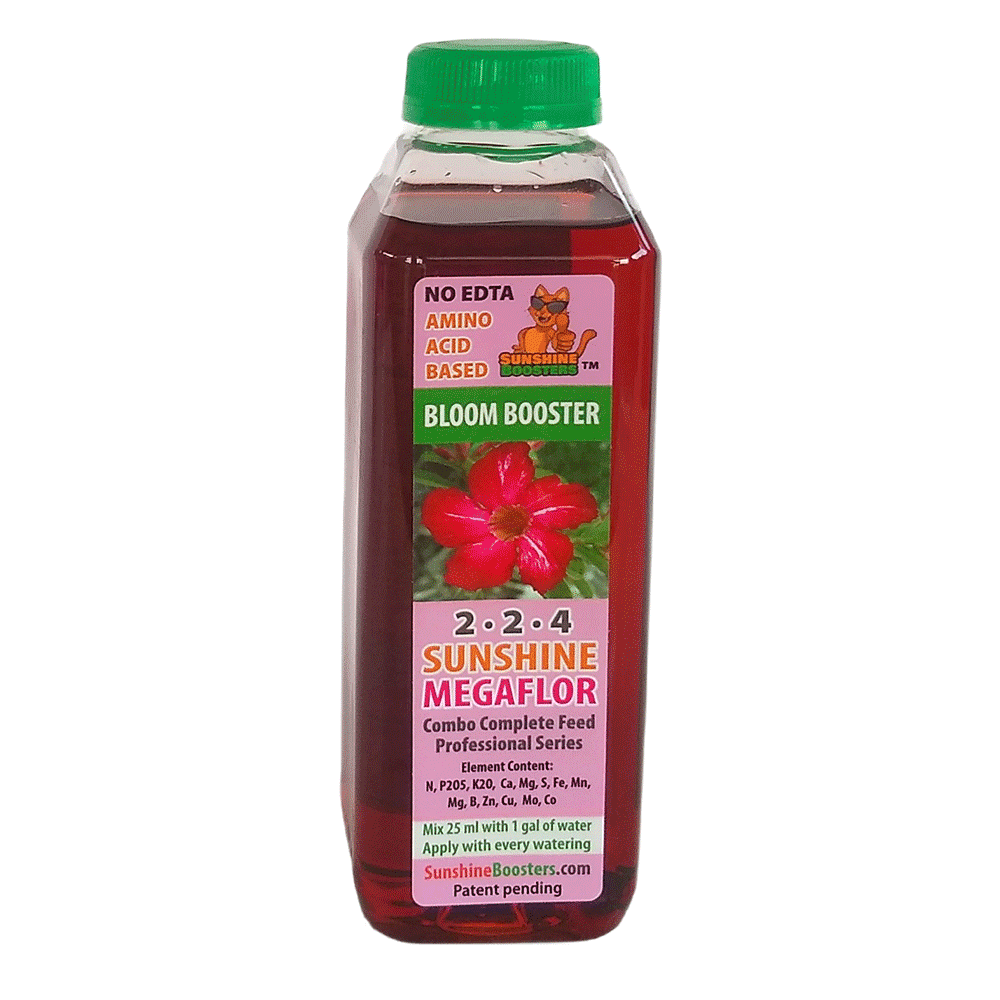 SUNSHINE Megaflor (NPK 2-2-4) - Bloom Booster for every watering. Formulated especially for blooms, to boost flowering, improve flower size and quality, and stimulate pollen development. This is an eco-friendly nutrition booster that can be used for organic gardens. Can be used for daily feeding with every watering. Scientifically-balanced stable formula is organic Amino-acid based and has NO EDTA chelators to eliminate nutrients lockup; it does not affect crop taste. Organic Amino acids greatly enhance stability of all Sunshine boosters and provide excellent absorption of trace elements. Pollinating insects friendly.
SUNSHINE Megaflor (NPK 2-2-4) - Bloom Booster for every watering. Formulated especially for blooms, to boost flowering, improve flower size and quality, and stimulate pollen development. This is an eco-friendly nutrition booster that can be used for organic gardens. Can be used for daily feeding with every watering. Scientifically-balanced stable formula is organic Amino-acid based and has NO EDTA chelators to eliminate nutrients lockup; it does not affect crop taste. Organic Amino acids greatly enhance stability of all Sunshine boosters and provide excellent absorption of trace elements. Pollinating insects friendly.